











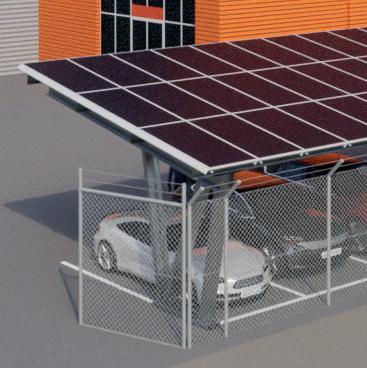

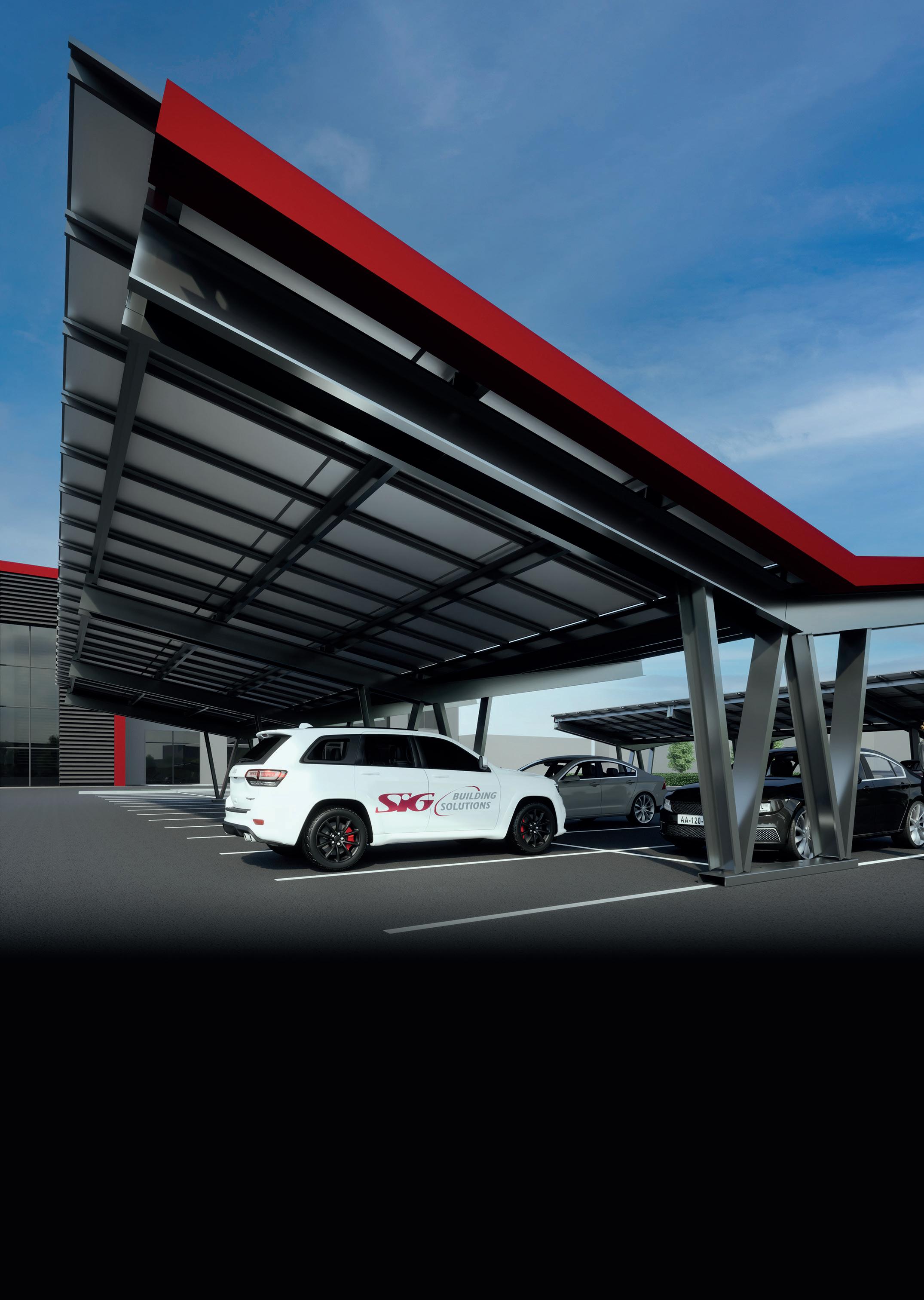
EDITOR Joe Forshaw

joe@energy-focus.net
PROJECT MANAGER Tommy Atkinson
tommy@energy-focus.net
PROJECT MANAGER David Hill
david@energy-focus.net
PROJECT MANAGER Chris Bolderstone
chris@energy-focus.net
PROJECT MANAGER Ekwa Bikaka
ekwa@energy-focus.net
FINANCE MANAGER Isabel Murphy isabel@energy-focus.net
LEAD DESIGNER Aaron Protheroe aaron@energy-focus.net
CONTRIBUTOR Manelesi Dumasi
CONTRIBUTOR Karl Pietersen
CONTRIBUTOR David Napier
CONTRIBUTOR Timothy Reeder
CONTRIBUTOR Benjamin Southwold
CONTRIBUTOR William Denstone
An integrated, combined approach to renewable energy is taking centre stage as developers realise the potential of a linked tactic where solar, wind, and other technologies work in unison to achieve bigger, better, faster results.
Taking tools from different providers also drives cost competition and innovation as suppliers strive to be the best and grow their market share. It’s a highly beneficial model that is having great results.
On Site Energy, the UK provider and financer of renewable energy systems to large manufacturing companies, is busy installing integrated systems for clients to maximise potential and minimise carbon emissions. The same is true for Solar Sense – traditionally a solar PV installer – the company is now pairing solar thermal and innovative digital solutions for clients looking for natural energy from the sun. Glen Dimplex Heating and Ventilation is innovating with new technologies to ensure sustainability through the use of IoT and AI. By understanding usage like never before, there is an obvious route to eliminating waste and saving energy.
Efficiency and reductions in emissions are key themes at this year’s ADIPEC conference, where Energy Focus is a media partner, and where the main topic will be decarbonising faster, together. All of the world’s biggest energy businesses will be in attendance and all will be showcasing their commitments to the future of energy. Lookout for our separate release on ADIPEC and some of the best companies that are exhibiting products and services that will truly revolutionise industry sectors.
Lamprell, the UAE-based rig builder and engineer, will be there talking about its shift in strategy, incorporating more renewable energy business with a new production line working on windfarm transition pieces. CEO Ian Prescott tells us more about this significant change.

We also hear from the fantastic team at ScanTech Offshore, part of James Fisher and Sons, about a highly innovative new product that has been engineering specifically for the offshore wind market to protect sea life during construction.
Published by
Chris Bolderstone – General Manager
E. chris@cmb-multimedia.co.uk
Fuel Studios, Kiln House, Pottergate, Norwich NR2 1DX ++44 (0)20 3097 1743 www.cmb-media.co.uk
CMB Media Group does not accept responsibility for omissions or errors. The points of view expressed in articles by attributing writers and/or in advertisements included in this magazine do not necessarily represent those of the publisher. Whilst every effort is made to ensure the accuracy of the information contained within this magazine, no legal responsibility will be accepted by the publishers for loss arising from use of information published. All rights reserved. No part of this publication may be reproduced or stored in a retrievable system or transmitted in any form or by any means without the prior written consent of the publisher.
© CMB Media Group Ltd 2023
Get in touch and tell us what your company is doing to bring together different ideas and technologies, and how you are rolling them out in a novel way. We’re online, as always, at LinkedIn
SCANTECH OFFSHORE (JAMES FISHER AND SONS)
ST3100 - Safer, Stronger, Smaller
ADIPEC 2023
Decarbonise Faster, Together
LAMPRELL
Lamprell Reimagines with New Board and Management Team in Place
REFLEX MARINE
Safety on the Seas, Guaranteed
UNIQUE GROUP
Unique Group’s 30-Year Journey in Ocean and Subsea Technology and What Lies Ahead
NEW OIL GENERATION
ECT Technology: Pioneering the Future of Heavy Oil Extraction with Sustainability in Mind

EUROPEAN ENERGY
European Energy Building Lasting Impact in Green Transition
ON SITE ENERGY
“Innovation Sets Us Apart”
SOLARSENSE
Solarsense Experience Second to None in UK Solar Market
66 72 78 86 90 96 102 110 118 124
GLEN DIMPLEX HEATING & VENTILATION
50 Years and Still Growing at Glen Dimplex
ALBA POWER
Leading Independent Turbine Specialist Hunts for Further Growth

SHELL On Track for Net-Zero Emissions by 2050
BUCHAN OFFSHORE WIND
Future Proofing Scotland’s Offshore Wind Sector
RWE – THOR
Largest Offshore Wind Farm in Denmark Increases Resonance
INCHCAPE SHIPPING Giving Steady Bearings Through Deep Industry Experience
SBM OFFSHORE Efficiency Focus Sails SBM to Strong Performance
BP
Real Solutions for Energy Trilemma
EDF
Carbon Free Energy Expertise Unrivalled at EDF
ARGENT ENERGY
Helping to Decarbonise Transport Worldwide

PRODUCTION: Joe Forshaw & Aaron Protheroe
A world-class innovation from ScanTech Offshore is helping to double capacity while more than halving the footprint on a vessel as the company launches its ST3100 air compressor which delivers Class Zero, oil free air for big bubble curtain applications around offshore wind farm developments. VP of North America, Barry Craig tells Energy Focus about expansion in the growing US market.
The potential of offshore wind as a green energy source is unmatched. The IEA suggests that worldwide, offshore wind could provide around 36,000 TWh of electricity each year – close to the total projected global demand for electricity in 2040. The industry is expected to become a US$1 trillion (£800 million) sector in the coming decades, and world-leading economies including the US are set to realise the booming potential of the wind energy market. In 2018, US electricity demand was
4,011 TWh but the potential of offshore wind was calculated at 8,086 TWh. Turbine technology is getting bigger and cheaper, and regulation is paving the way for sustainable rollout.
In the US, where 30GW is targeted by 2030, less than 0.5GW is currently installed, but that is changing. Project developers are continuing to search for exciting opportunities and a robust supply chain is being developed.
From north to south, all the way down the US East Coast, offshore wind farms are proposed or already
planned. To ensure the public benefit from not only the green energy that will come, the Jones Act enforces the deployment of local vessels and workforce (where possible) to carry out construction activities.
James Fisher and Sons, headquartered in the UK, and its subsidiary ScanTech Offshore, has an existing operation in Houston, Texas, and recently expanded to Providence, Rhode Island to further support the nascent US offshore wind industry. It is also expected in 2024 that further

expansion of supporting facilities will be opened across the North-East Coast of the US. These operational bases will provide in-country support of ScanTech Offshore’s world-class bubble curtain air delivery packages.
In 2018, ScanTech Offshore – a company with a strong history in well-test and support for the oil and gas industry – diversified and entered the renewables market, exploring opportunities for the deployment of its specialist air compressor units. Through bespoke technology which was carefully engineered to be powerful but stackable on a vessel, ScanTech Offshore air compressors quickly became recognisable across the energy sector as a reliable, premium product.
Engineers at ScanTech Offshore sites in Aberdeen and Great Yarmouth quickly saw the potential of air compressors in wind energy, supporting the idea of the bubble curtain – a barrier that surrounds the piling of wind turbine foundations with bubbles to attenuate noise and protect marine wildlife. Air is sent down a hose to a flexible hose system, which is pre-laid on the seabed with special
nozzle openings that release bubbles in strategic column formations.
A high flow of compressed air is required to create a well-formed and effective bubble curtain. Not as simple as pumping gas down a tube, the air that goes into the water must be Class Zero ‘clean air’ and must be moved in huge volumes at pressure. To create the force, ScanTech Offshore stacks up multiple compressor units alongside its SeaSentry system, which ensures air is contaminantfree and leaves no negative environmental impact in the water.
Prior to ScanTech Offshore, bubble curtains delivered the volume of compressed air by installing many industrial-style air compressors that required a large footprint on a vessel (up to 30 air compressors on a single vessel). This resulted in the need for the deployment of larger vessels (typically PSVs) in order to install the required compressed air volume needed to support an effective bubble curtain.
The typical compressor types being deployed were either not stackable due to the inability to stack or issues resulting in overheating due
to the types of vessels often available in the market to locate the equipment.
ScanTech Offshore successfully entered the market in 2018 by providing the market-leading bubble curtain specialist - HydroTechnik Lubeck - a ‘stacked solution’ that effectively reduced the footprint allowing for a larger portion of available vessels to be considered to support certain offshore campaigns. This was achieved by deploying ScanTech Offshore’s containerised ST1600 (1600cfm / 45m3/min) model air compressor that had been proven to be a durable and reliable compressor from supporting high-value well test support contracts in the oil and gas sector for over 25 years.
ScanTech Offshore has supported numerous Big Bubble Curtain (BBC) projects spanning from the UK, and Europe to Asia deploying the ST1600 compressors with great success. However, during this time, it was clear to ScanTech Offshore that the market needed a truly purpose-built solution that would eliminate the most common challenges experienced when installing a large spread of diesel-

driven air compressors on a vessel with confined space constraints.
Previously, compressors would give off undesirable levels of heat whilst working on ships with high sides, as the heat from machinery would struggle to escape. Temperatures became uncomfortable for personnel and led to increased maintenance for machinery. It became clear that future projects may even require larger volumes of compressed air to support an effective bubble curtain, due to challenging environmental conditions (such as strong sea currents) and the increasing size of the foundations (requiring more noise attenuation).
HydroTechnik approached ScanTech Offshore for a solution that

would provide further deck space savings allowing for even higher volumes of compressed air to be installed on a single vessel but also “fit for purpose” whilst working on vessels with high sides. Finally, the new system needed to be capable of supporting projects in deeper water –capable of producing a higher working pressure was of critical importance.
After refinement and much testing, ScanTech Offshore developed the ST3100, a 20ft CSC / DNV2.7-1 containerised air compressor with a Caterpillar engine and original radiator technology that can deliver 3100cfm and capable of working pressures of up to 200 PSI, providing the air required to a create a bubble curtain that reduces noise by up to 90%. Importantly, the ST3100 delivers more than double the power compared to previous air compressors, whilst taking up half the footprint, even when equipment
is not stacked. When stacked (as per the design) the footprint savings are much greater providing up to 3-4 times more compressed air on the same footprint as some of the alternative solutions available in the market.
Testing and learning in 2018 through to 2022, several major projects were undertaken as ScanTech Offshore eyed eventual rollout in the US. “Even during the initial learning in Europe and Asia, we instantly saw that the market needed a purpose-built solution and not just a compressor. It had to be reliable,

“WE INSTANTLY SAW THAT THE MARKET NEEDED A PURPOSEBUILT SOLUTION AND NOT JUST A COMPRESSOR”ScanTech Offshore Great Yarmouth
and it had to be designed first and foremost with the safety of personnel in mind,” says Barry Craig, VP of North America at ScanTech Offshore.
He says that on an oil rig, compressors are stacked in a uniformed position and the heat generated can escape. But on the back of a vessel, the heat has nowhere to go, and the result was increased maintenance in addition to the need to take additional measures including sea water cooling for the units when working in higher ambient countries such as Asia.
“We spent 18 months on the design work, and we looked at many different options to maximise every aspect, from power to emissions.”
Caterpillar engines were chosen because they were familiar and proven in the harshest environments that ScanTech Offshore support, this paired with ScanTech Offshore’s vast experience with the engines made them the ideal choice. The engines also offer Stage V / EPA Tier Four Final emission standards – required for compliance in both the European and US markets. There is also no need for additives, meaning no storage of diesel exhaust fluid (DEF) on a vessel. Pairing with compressor technology
from Sullair, the offering was almost complete, but ScanTech Offshore still had to develop the solution to deal with the high temperatures.

“We came up with a unique heat rejection system that has been incorporated into the compressor unit that allows it to be stackable, reducing footprint drastically, and ensuring that the ambient conditions around the machinery and on the vessel are maintained well within safe working limits for personnel. Furthermore, the solution providing additional value through automated refuelling and reduced need for personnel amongst other things.”
With extensive and successful trials conducted on the ST3100 solution, the team took the units to the US market and successfully supported the first commercial scale offshore wind farm on the East Coast of the US. The ST3100 solution ensured our client could deploy their own specialist vessel for the project, negating the need to deploy a much larger vessel to the project at a greater cost.
Alongside the cost-effectiveness proven in the US, the ST3100 did the job underwater, reducing decibels from construction activity significantly,
protecting whales, dolphins, porpoises, and other sea life. On the deck, the heat from the units was completely mitigated thanks to the clever system designed by ScanTech Offshore.
The process of evolution from compressor for oil and gas, to allnew specialist designed product for renewables was a journey for ScanTech Offshore. “We had to go into it almost with our eyes closed to learn – what do we actually need on these vessels to make it safer, more efficient, and maximise performance? At the end of the day, this is all about uptime,” says Craig, adding that downtime can cost millions of dollars per day. “The value of us providing what we do is critical. Everything stops if we’re not providing compressed air to the bubble curtain effectively.”
The offshore project in the US provided engineers and offshore teams with a significant amount of data to display to the market. The on-deck and beneath the surface excellence displayed on this key project in the US was the perfect case study to demonstrate the full value that the ST3100 solution offers.
Craig moved to Rhode Island in 2022, with plans to deploy the ST3100 technology along the East Coast of the US, supporting their key clients and partners in each state. Following the successful deployment on the recent US project, it has set the business up as a well-established player for the future projects expected in region.
Now a proven part of the growing supply chain, ScanTech Offshore hopes to ramp up US involvement substantially. “We want to be the number one supplier for sure. We have taken the design which we built in the UK, and we’ve taken it across the pond with a leading EPCI to do the work on the US East Coast, and it’s been very successful,” says Craig.

Already secured on two large projects for the next two years, local manufacturing will begin imminently with the US renewable pipeline now beyond 51GW – enough to power 20 million homes.
“We focused on the US because it is an emerging market and it’s good to be in emerging markets at the start,” says Craig, adding that the importance of local procurement is vital. “We already had our facility in Houston with a team which has
successfully supported operations in the US for over a decade. The same team even supported operations on the first US offshore wind turbines off Block Island, RI. Today, with the expanding offshore wind ambition demonstrated by the US, we also have plans to replicate and expand our offering up and down the East Coast to support the upcoming projects.
“We will work collaboratively with key partners in region to ensure our air delivery packages can support the projects and bring a huge amount of added value through our innovative technology. We are working with our partners on methods to improve efficiency and reduce cost in an effort to further boost the sustainability of the offshore wind industry.”
Craig, pays tribute to the James Fisher and Sons plc board who backed the move during an unpredictable time, following the pandemic and global supply chain challenges, providing investment and continuing to support the team at ScanTech Offshore.
“We are now set to enter phase 3 of our build programme where equipment will be assembled out of our Houston facility. The
units being built will probably be working on renewable based projects for the next decade at least. We will build the compressors in America, with 100% US content.”
The US market is different to the European sector and one of the challenges is vessel size and availability. The Jones Act means that locally flagged vessels, manned by local people, must be used in offshore construction, and this can mean big changes in cost as projects look to move up in size. To help here, ScanTech Offshore always had the footprint of the compressor in mind and Craig says that making it as small as possible without compromising on power was the goal.
“We want to give a solution that widens the selection process for a vessel that can be used and allow vessels to potentially complete other tasks as there would be spare deck space,” he hopes.
“When we look at the vessels available here, there’s not a huge number of large vessels and the availability of vessels is not great because the oil and gas market
is up. The day rate jumps from vessel to vessel and can easily be $10,000 - $15,000 a day if you need to jump up to the next class.”
“In some circumstances, ScanTech Offshore technology has the potential to even to reduce the need for two vessels,” reiterates Craig.
The US offshore wind developers have been strict in saying you must comply with the highest level of tier emissions, and you must use US-flagged vessels. We looked at the market and how it might work, and we believed that the ST3100 could make an impact there more than anywhere else in the world by reducing the footprint and allowing for a wider variety of Jones Act vessels to be deployed. If a competitor tried to stack the equipment, then you’d get the same issue of heat not escaping and ambient temperatures rising beyond what you would want for people or machinery. The ST3100 not only stacks but conforms to the slim profile that US vessels typically have ensuring there is no dead
space when installing equipment.
The added bonus for ScanTech Offshore equipment is the certification that boosts confidence. Everything is rated for offshore work – DNV 2.7-1 certified and CSC approved, using the correct grade of steel, easy to transport and crane like any other container. “We give validation that everything is fit for purpose and designed to be on a vessel and designed to be at sea,” says Craig.
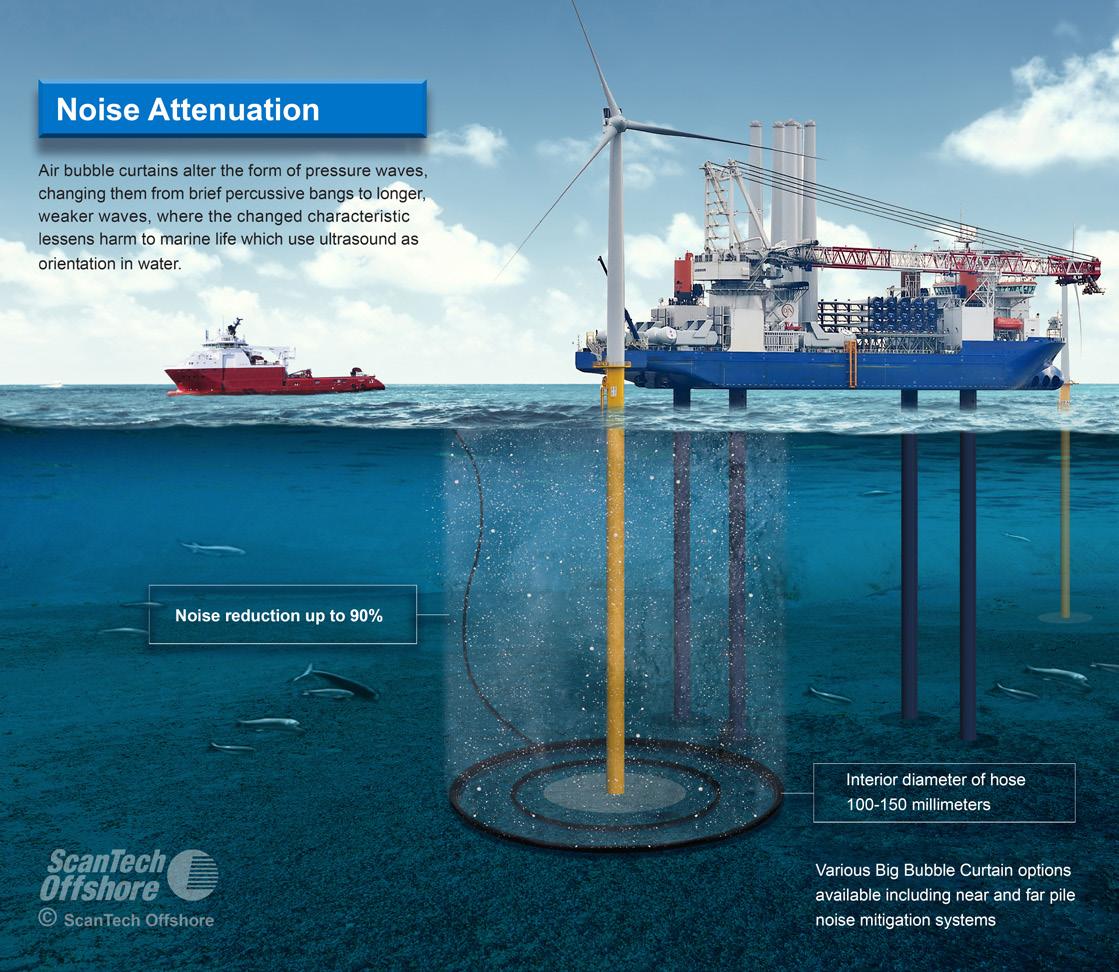
“Previously, industrial compressors had been chained to the back deck of a vessel, and no formal certification such as CSC were being met. With the ST3100, walkways are clear, and units can be craned from vessel to vessel if required,” he adds.
On-ship, with temperature levels low, and you are automatically informed if maintenance issues could arise via remote telemetry installed on all units (creating reports for the client at the same time). ScanTech Offshore engineers are thrilled with the performance of the ST3100 units to date. Craig reports that, ultimately, they continue to do the job.
“I speak with our team on the project, and they say they have never seen so many whales, ever. The number of whales off the East Coast of the US is phenomenal. The project we recently supported was stopped several times in the name of animal welfare. We hear of in excess of 100 whales at a time in a single area and that is not something our team sees often. So, I think you can see why they’ve adopted the highest levels of mitigation possible.”
The wind energy market will grow exponentially in the coming decades and Craig is excited to be part of a solution for the future. In the US, new vessels are on order or under construction, new facilities are being erected, domestic skills development programmes are being rolled out, and the American Clean Power Association (ACP) expects 83,000 jobs to be created in offshore wind by 2030.
“With the rapid expansion of offshore wind globally across multiple geographies, it highlights the necessity to build and support locally in order to be successful,” says Craig.
Typically, sound detection buoys are placed at 750m distances from a construction site and operations must not exceed the agreed threshold in the environmental permit which is critical to comply with at all times. The bubble curtain helps to achieve this by altering the characteristics of the sound waves as they pass through the bubbles.
“There’s nothing that gets close to it in terms of noise reduction,” confirms Craig. “A 15-18-decibel reduction is enough to make a real impact as sound behaves differently in water. This can equate to a 90-95% noise reduction which provides a clear benefit for marine life.”
Other noise abatement technologies can be used alongside the bubble curtain to protect marine life and, as long as conditions are suitable, the local underwater populations will remain well protected
as activity ramps up. However, time after time it has been shown that bubble curtains are the most effective technology to attenuate noise during pile driving activities.
“It’s phenomenal, it has been a massive team effort from the offshore teams feeding in the information to our engineering team doing a lot of testing. We’ve just finished a big job, one of the first in the US and it has been a great success. You can do all the simulations, but until you prove it in the field, it’s only as good as your theory.”
Going forward, ScanTech Offshore is well-placed for expansion in the US and harnessing potential in the Blue Ocean economy, and Craig hopes that the wider James Fisher and Sons team, which has already supported over 17GW of renewable construction and development around the world, can

assist as the nation ramps up effort to green its generating capacity.
“We’ve already secured a further two major projects on the East Coast of the US for major international wind energy businesses. Our pipeline here is extremely exciting for at least the next three years, complementing our already prominent Europe and Asia business lines.
He adds further assurance that if you engage with ScanTech Offshore, or the wider James Fisher Group, you will get a partnership that achieves results.
“We’ve all been offshore, and we’ve seen the failings of our customers, competitors or even our own. That’s what differentiates us, and that is why we are successful.
“Our units are brand new; they’re not going to have been in anybody else’s hands, and they’re not going to
be rented out without our people.”
Truly a leading product for a burgeoning market, ScanTech Offshore’s ST3100 is an enabler of the green energy transition in the US. All EPCI companies and fleet owners should be considering the significant efficiencies that the system offers. Asked if he is expecting competitors to flood the market with similar products anytime soon, Craig remains confident.
“By the time they do, we will likely be on to the next innovation by working closely with our partners and clients as we all strive to further improve efficiency.”
Can the world’s largest and most influential energy exhibition bring together the wide energy ecosystem to drive realistic, sustainable, fast transition and decarbonisation? Energy Focus looks at the key messages and hot exhibitors from ADIPEC - the most anticipated event of the year.

Since 1984, ADIPEC has been a leading platform for discussion, innovation, knowledge sharing, and progress in the energy industry. In that time, the world’s energy conversation has changed considerably. Fuelling the development of society with fossil fuels is a concept that has been and
is set to be gone, but the managed transition will take time. Renewable energy, closed loop systems, and driving down environmental impact is the new conversation – and the new source of opportunity.
In October, Abu Dhabi will again host the brightest, best, and biggest in energy from around the world, this
year focusing on the question – how can we decarbonise, faster, together?
To answer the call as best as possible right now is an unrivalled list of speakers from the global community. Nowhere else in history has a more impactful group of industry peers joined to make things happen.
Abu Dhabi, the largest of the
PRODUCTION: Sam Hendricks
United Arab Emirates, will hold the event with ADNOC (Abu Dhabi National Oil Company) the official host company.
“ADIPEC is a powerful global platform that can help present the possibilities of a more inclusive approach by welcoming the solutions and skills of the energy industry today,” said His Excellency Suhail Mohamed Faraj Al Mazrouei, Minister of Energy and Infrastructure United Arab Emirates.
“ADIPEC 2023 will be a progressive force for energy transformation and leadership,” said Tayba Al Hashemi, CEO of ADNOC Offshore and Chair of ADIPEC 2023. “It will unite the expanding and increasingly diverse world of energy and help us work together to transform, decarbonise and futureproof our industry, by accelerating the innovation and tangible actions needed to enable a lower carbon and higher-growth future for the world.”
While the nature of conversations around the world’s energy mix have changed, the mix itself has remained relatively constant. While decreasing slightly, coal still makes up almost 37% of total electricity generation (40% in 1971). Natural gas makes up 23% and nuclear 10.3% (13% and 2% respectively in 1971), with oil the only fuel to significantly decrease over the period (21% in 1971 down to 2% in 2019). Renewables have gained traction climbing around 3% to reach 26% of global generating capacity.
But in the UAE, the oftenoverlooked progress has been phenomenal. Abu Dhabi-based Masdar, established in 2006, is now one of the world’s most significant renewable energy companies, pioneering wind and solar around the world. The UAE is home to the world’s three largest and lowestcost single-site solar plants and the first
Arab country to operate zero-carbon nuclear power that will supply 25% of the nation’s electricity demand by 2024. Also an early adopter of hydrogen technology, the region hopes to be a leader in this fuel of tomorrow. Today, as one of the world’s top contributors to the energy transition, according to the Gren Future Index 2023, Abu Dhabi is an example to follow.
At ADIPEC, more than 160,000 people from more than 2200 companies will come together to define the future of energy. Guest speakers across the various conferences and sessions include Wael Sawan, CEO Shell; Patrick Pouyanné, CEO TotalEnergies; Dai Houliang, Chairman CNPC; Bernard Looney, CEO bp; Claudio Descalzi, CEO
Continues on page 18



Continued from page 16
innovation, utilisation of modern energy finance, and advancing progress in developing markets.
and accelerating the development of new technologies,” he said.

Key topics up for debate will include new technology, decarbonisation through
Thomas Storch, MD at Affinity Partners, reminds that 775 million people – predominantly in the global south – still live without access to electricity. Innovation is the key to the problem, but innovation costs money. “Because the private sector is often reluctant to invest in technologies that are not yet proven, government funding plays a critical role in bridging the financing gap
But government funding alone is not enough, and forming and rolling out public-private partnerships PPPs, while effective, takes time. “If we want to accelerate the energy transition, stimulating conversations and collaboration between the energy industry, the finance industry and global policymakers is essential. These dialogues have never been more important, as we increase our ambition to tackle the twin challenges of energy transition and energy security.
“Ultimately, while words and pledges can be impactful in signalling policy goals, finance and investment are the key drivers of a sustainable energy future,” says Storch.
Christopher Hudson, President of dmg events – organisers ofContinues on page 20
// IF WE WANT TO ACCELERATE THE ENERGY TRANSITION, STIMULATING CONVERSATIONS AND COLLABORATION BETWEEN THE ENERGY INDUSTRY, THE FINANCE INDUSTRY AND GLOBAL POLICYMAKERS IS ESSENTIAL //

Continued from page 18
ADIPEC – states that technology cannot be underestimated. “Critical to accelerating innovation in decarbonisation is technology. New and improved technologies will enable


industries and companies to reduce emissions, improve efficiencies, reduce environmental impact, and enhance production, collectively allowing us to stay within the 1.5⁰C warming threshold set by the United Nations.” Recognition that speed of progress

has to be increased is essential and this is why dmg events decided to highlight decarbonisation as such a strong theme for this year’s event.
“By platforming the collaborative and innovative technologies that will be integral to a secure, lower-carbon future, ADIPEC 2023 is contributing to the advancement of decarbonisation in support of the global energy transition for a brighter and more sustainable future for all,” says Hudson.
CEO at Uganda’s National Oil Company, Proscovia Nabbanja agrees that progress must hasten but focus must be shared with developing nations which face added pressure from around reducing emissions at the expense of their own development.
“Supporting an equitable energy transition through clean energy in the developing world is crucial
for combating climate change and achieving sustainable development,” she says. “These efforts contribute to poverty reduction, improved health, and inclusive growth. By investing in clean energy, developing countries can enhance energy security, decrease reliance on fossil fuels, create jobs, and foster economic growth. The international community, private sector, and governments must all play a role to support the energy transition in the developing world.”
Some of the world-leading companies demonstrating innovation at ADIPEC include Unique Group - expert in diving, buoyancy, unmanned surface vessels, and surveying – which is opening a new facility in Saudi Arabia to support growth in the Middle East, and Reflex


Marine – the leader in offshore crew transfer technology by crane – which is launching its latest product range with improved safety and technical performance. New Oil Generation will also be displaying its new method of enhanced oil recovery through exothermic chemical treatment, retrieving heavy oil with unique chemical reactions. Global majors, including bp and Shell, continue to diversify product portfolios and investments and both are now more exposed than ever before to renewable energy sources, both in upstream and across the supply chain. The landscape is complex and remaining close to the conversation is now more important than ever for those looking to grow in the ever-changing sector.
You can sign up to register for ADIPEC here. And you can
register as a delegate here.
This year, under the scorching desert sun, as the world continues its dynamic transformation towards sustainable energy solutions, ADIPEC stands as a beacon of hope, knowledge exchange, and collaboration, promising to unveil groundbreaking insights and innovations. Against a backdrop of rapidly shifting paradigms in the energy landscape, ADIPEC 2023 comes at a pivotal moment. As we navigate the complexities of an evolving industry, ADIPEC remains the compass that guides us toward a brighter and more sustainable future, driving the need to decarbonise faster, together.
Lamprell’s purpose has long been to provide best-in-class project services and solutions for the energy industry, and a recent reorganisation has resulted in an increased focus on the group’s strategy and part in renewables and the energy transition while it continues to support its core oil & gas business segment. The result is that Lamprell is doing its bit to best align with customer needs and enable optimum access to opportunities in its core markets.


//Lamprell enjoys more than 45 years’ experience in delivering world-class projects to the international energy industry, since its establishment in 1976. A leading provider of EPCI contracting services, the company drives strategy and growth through its renewables and oil and gas business units.
Underpinned by almost half a century of expertise, and staffed by more than 5,000 people through its primary facilities in Hamriyah, in the UAE, and those in Saudi Arabia, Lamprell has tirelessly established its reputation for delivering projects safely, to the highest standards of quality, on time, and to budget.
Lamprell has set about transforming its business to thrive in the energy transition, offering foundation fabrication and other services for the offshore wind sector alongside activities in its traditional oil & gas segment

including the delivery of modules, platforms and rig construction and refurbishment projects. “Over the years, we have gained a foothold in energy markets with significant barriers to entry,” explains CEO Ian Prescott, “and we continue to evolve the business to deliver more sustainable and differentiated solutions.” “The world around us is changing, and the way that we think about energy is changing, too.”
For a very long-established player in the Middle East, this represented a significant change in direction, Prescott underlines. “As with many other EPCI contractors, the company has been through some hard times in recent years,” he admits. “Lamprell failed to win sufficient business and ended up becoming financially distressed. Our major Saudi Arabian shareholders started acquiring Lamprell’s shares on
the open market, which were listed on the London Stock Exchange. They took a controlling interest in late August and then decided to delist with the process being completed in October last year.”
“Lamprell is now a private company, the shareholders have put in place a new Board of Directors, to reflect the new ownership structure, and the Board has in turn refreshed the management
// LAMPRELL CONTINUES TO ACTIVELY TARGET THE GROWING RENEWABLES INDUSTRY IN ITS TRADITIONAL MARKETS AS WELL AS NEW GEOGRAPHIES //
Ian Prescott, CEO
team with highly experienced individuals from the industry.”
“These are hugely exciting times, and we can all see the potential in the company; we are in fact starting to realise some of that potential already. We are under new ownership with new direction, have a new Board as well as new and energized management team, and we want to share that news far and wide.”
Extensive renewables experience has already allowed Lamprell to build several multi-purpose jackup vessels and hundreds of wind turbine substructures including jackets, suction buckets and piles, with a multi-billion dollar bid pipeline of renewables projects in the offing. The company is also currently delivering 62 transition pieces through its renewables production line. “A major part of the company’s new direction
was to invest in what we have called our ‘growing line’, a production line to cater for the serial fabrication of monopiles and transition pieces for the offshore wind sector,” Prescott adds. “Things like this are what make us, quite frankly, the best-kept secret in the Middle East, and certainly in the renewables sector. We have this capability, and we now want to share it with the Industry.
“We have revitalised the business development area of the Group,” Prescott emphasises, “and our pipeline is looking incredibly healthy. I doubt that there is a renewables project where we do not have some involvement in our addressable markets.”
In Lamprell’s oil & gas business, recent business development efforts have paved the way for the likes of the award in August by the National Petroleum Construction Company



(NPCC), for the fabrication, painting, and load-out of five offshore jackets and boat landings with an optional scope, including the supply and fabrication of grillage and seafastening of the structures.”
“With an overall fabrication weight of almost 14,000 tonnes, we are approaching this project with the same passion and determination that have fuelled our achievements in the past to ensure we deliver an outstanding project safely,” Prescott reiterates. “This is an important project award which serves as another indication of the progress Lamprell is making through its key strategic partnerships in the Middle East region.”
This is an interesting situation for Lamprell, Prescott stresses, in partnership with a competitor, but when the call came from NPCC,

Offer our customers top-tier equipment hiring solutions, all while ensuring affordability, and empower our skilled workforce to pave the way for a brighter future.
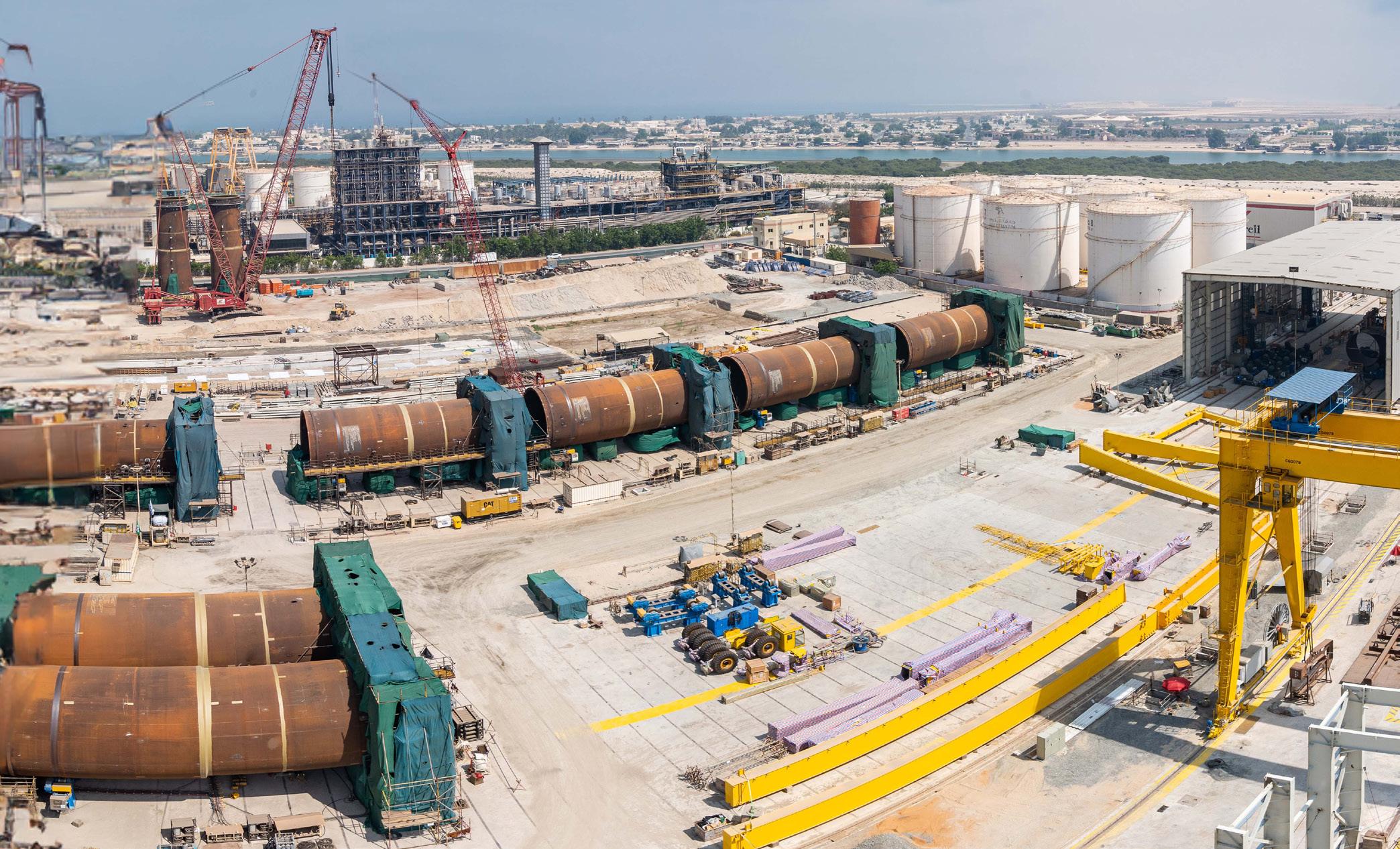
Lamprell was only too happy to assist. “We had the capacity, and were delighted to support this significant project. We are well underway with the engineering and have already done the first steel cut on the jackets; progress has been quite positive.”
Lamprell has in fact been a pioneer company in the renewables arena since the award in 2007 to build its first self-propelled multi-purpose vessel. By 2021, a total of 138 wind farm jackets, 90 suction buckets and 180 piles had been delivered for the East Anglia ONE, Moray East and Seagreen wind farms, while Lamprell also received the Middle East’s first green trade finance facility for the Seagreen project in 2021.
The group’s new state-of-the-
art renewables production line was called into service in 2022, this time in connection with Moray West offshore wind farm, to deliver 62 transition pieces, which Lamprell is currently executing. “This project is proceeding really well,” Prescott confirms, “and we are actually on the cusp of delivering the first batch of transition pieces as expected, on budget and with an outstanding health and safety record. We are also on track to meet the various forthcoming deliveries over the remainder of the year, ahead of the final batches within Q1 of next year.”
“Lamprell continues to actively target the growing renewables industry in its traditional European and UK markets as well as new geographies, including the USA, which continues to gain traction,” Prescott continues. “What sets us apart in particular is
the knowledge transfer that has taken place as we have redefined the business; everybody working on our renewables project and the production line today is a long-term Lamprell employee, employing the precision engineering which has always been our business and growing the knowledge share within the company.”
This deep well of knowledge and experience is part of what truly sets Lamprell apart, Prescott adds. “I have been hugely impressed by the people who we have within our business,” he beams. “This is the number one asset in any company like ours, and we have some incredible people. Over 1,000 of our total staff have been with Lamprell in excess of 15 years, a massive figure and a dedication which allows us to retain a lot of relevant, valuable experience to allow
us to execute these types of projects.”
A lot has been underway at Lamprell of late, and Prescott as CEO, in post since April this year, has hit the ground running. “I wanted to establish the new strategy for the company going forward,” he says. “We gathered together a broad-base spectrum of 15 employees for a strategy session which took place over two days, and the outcome of that was our key business pillars and fresh strategy to present to the Board. Each business pillar owner has presented a business case for expansion. Targets and goals have been discussed at length and presented. We are in the process of finalising this exercise, which has been the product of many long hours of work by our dedicated team, and getting the green light from the Board to proceed with the selected plans.”
Lamprell’s refreshed and reimagined direction coincides with the tremendous global growth in offshore wind, with an additional 200GW to be brought on stream by 2030 and a further 128GW by 2035. The positivity abounding at Lamprell has been mirrored in the evaluation of its work to date in this burgeoning field, Prescott shares. “The refreshing thing when we meet prospective renewables clients, who are a close knit group, is that when they talk to people who we are currently working with – such as Moray West’s owners, Ocean Winds, for example - the feedback is highly complementary. Now, increasingly, companies in Europe, and in the USA, where we have a number of opportunities, are looking at us to see what we can deliver,” Prescott reveals, and Lamprell
is unequivocally positioned to do so.
“We know that we are commercially competitive, and we have built a farreaching confidence around both the price and the quality of our product, all held together by an outstanding health and safety record - this is borne out of the oil & gas sector and improving day on day through the work with our renewables clients.” Prescott concludes. “We believe we can deliver a compelling offer and we are well placed to benefit from the many new prospects offered by the energy transition.”
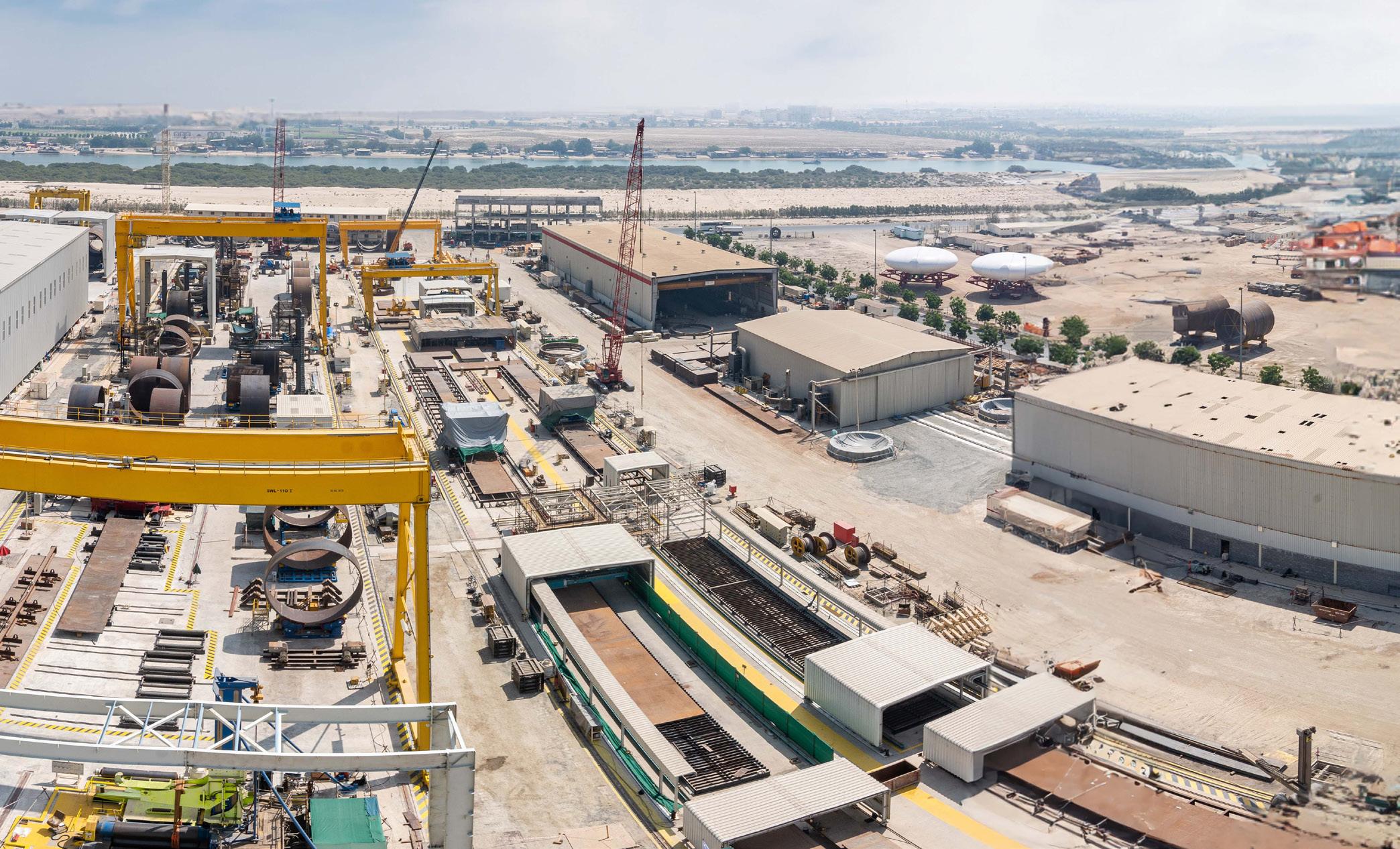
Reflex Marine is the leading designer, manufacturer, and marketer of crane-based crew transfer solutions in the offshore environment. COO Sandra Antonovic tells Energy Focus that the unending focus on safety will continue as the latest product updates are launched while the business looks to continue growing globally.
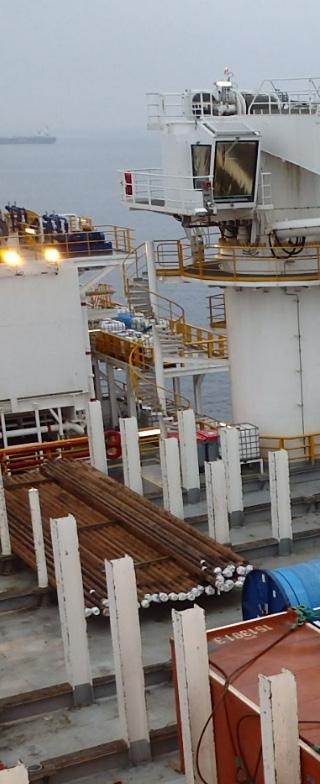 PRODUCTION: Tommy Atkinson
PRODUCTION: Tommy Atkinson

The perils of offshore work are well-documented. Waves, heat, cold, noise, hazardous materials, industrial equipment etc –the job is fraught with risk. But getting offshore to a vessel or rig should not be a threat. In few other careers is transport to work such a concern. But in the harsh offshore environment,
safety is always the priority as a commute is far from ordinary.
Typically, to get offshore for work on various energy installations or other sea-based infrastructure, helicopters of specially-designed crew transfer vessels are utilised. In deep water, far from shore this is often the only option. But when offshore, at an oil
field in the North Sea or at a windfarm in the Baltic Sea or at a gas well in the Persian Gulf, multiple installations make up the larger project and transfer or crew between platforms and vessels is essential. Helicopters are too expensive, and boats not logistically possible.
Reflex Marine, the Aberdeenheadquartered provider of crew transfer solutions, has designed and refined units for safe movement of people without the need for choppers or boats, and with human-wellbeing at the core. By utilising cranes to quickly and cost-effectively move people, clients can make significant savings while ensuring safety at all times.

“Most crew transfers are still done by crane,” explains Reflex Marine COO Sandra Antonovic. “Until fairly recently, crew would grab a rope hanging from a crane while the crane moves them across to another platform, hoping that they don’t let go and drop. The other option was a collapsible

basket which is a rope frame that hangs from a rope on a crane, again hoping that no one let’s go or slips.”
She highlights the scary scenes across offshore operations around the world where crew transfer was literally putting lives at risk. Employees would sometimes jump from the back of a vessel to a jetty at the base of a rig, with the waves pushing the vessel back and forward, bumping into the side of the structure. Scenes like this are not illegal but they are certainly not encouraged. This was the reason for the establishment of Reflex Marine in 1992.
“Statistically, helicopters are safe and there are very few accidents each year,” says Antonovic. “But it doesn’t seem like ‘very few’ if someone you know is in one of those accidents. We have not had a lost time incident, let alone a fatality, in 12 years. We are the only crew transfer option in the world
that has this safety track record.”
She adds that safety is the ultimate priority and everything else comes a distant second. For this reason, Reflex Marine has grown to become a global partner across multiple industry sectors, supporting more than 300 companies in 85 countries.
The product range is made up of the FROG, WAVE, STORM WORK, and other models. Each is a purposebuilt solution to move people and cargo offshore using a crane.
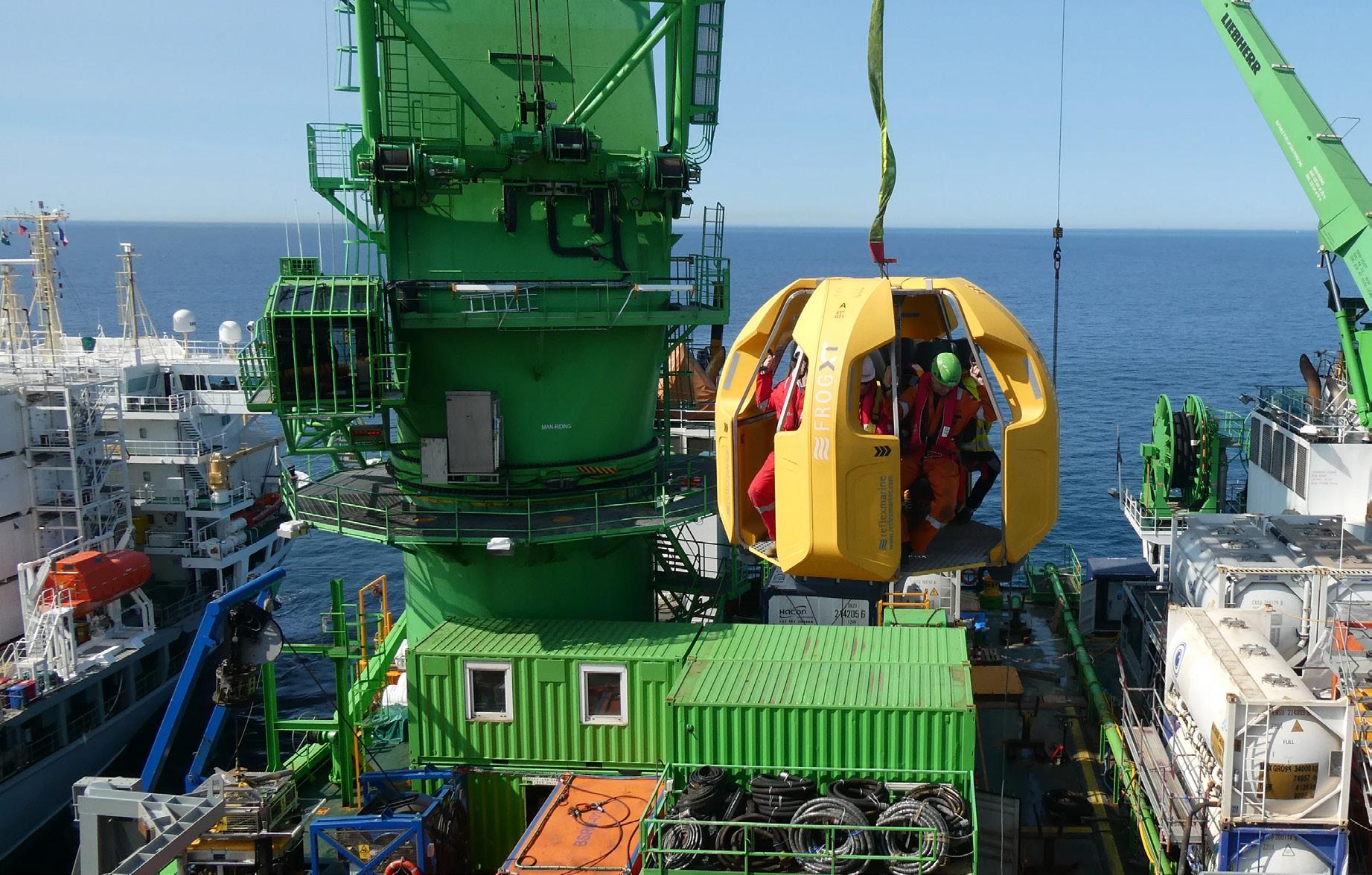
In Abu Dhabi, at ADIPEC, Reflex Marine will launch the latest iteration of one of its core products, especially popular in the Middle East. “We are promoting a new product which is an enhancement of one of our existing products. We are setting up an evening event for our clients and partners
and we are excited to showcase this product,” explains Antonovic.
The FROG, the first product in the company’s portfolio has been updated numerous times over the years. In 2013, a new model was released, capable of carrying four, six, or 10 people. Now, a fresh launch will see better materials and technologies that ensure safety and sustainability, while improving cost efficiency for clients who own.
“Internally, the focus is always innovation, research and development,” reminds Antonovic. “We are a forprofit company and we sell products, but we operate as a research and development department. We use revenue generated from sales to keep working on different new products and different solutions. We are constantly testing materials and theories, and we don’t have a large product portfolio because we spend around
20,000 hours designing and testing anything that goes into production. We particularly test the impact on the human body and the spine. We are always looking to make sure there are no injuries – not even bruises.”
Antonovic has used a Reflex Marine transfer system and likens it to a regular flight. You strap into a harness, you feel little motion, just a bump when the unit hits the deck, just like a plane landing. “It is very stable; you really don’t feel much.”
As well as being incredibly safe and
removing significant risk for operators, Reflex Marine saves cost where it is often unnecessarily be expended. “Helicopters are extremely expensive,” highlights Antonovic. “They make sense in deepwater, far from shore, where you want to take a medium-sized crew in the quickest possible time. Companies can pay tens of millions of dollars per year for helicopter transfer and there are a lot of circumstances where you don’t need helicopters and you can use a vessel and a crane.”
Safety seats, with hydraulic
suspension arms and heavy-duty harness belts, are surrounded by a high-strength buoyancy, supported by a stainless-steel structure. All components are standardised, and put together with ISO 9001:2015 certification.

“Inter-field transfer is difficult and there are often multiple installations where you need to move people. To use a helicopter here is extremely inefficient. Companies want a safe and cost-effective solution and helicopters cannot compete – especially considering weather limitations,” says Antonovic.
In the future, Reflex Marine will remain focussed on its innovative nature by constantly adapting and improving products as demands offshore change, always making the range stronger, safer, and more efficient. But Antonovic is keen on constantly increasing the
// WE ARE CONSTANTLY TESTING MATERIALS AND THEORIES, AND WE DON’T HAVE A LARGE PRODUCT PORTFOLIO BECAUSE WE SPEND AROUND 20,000 HOURS DESIGNING AND TESTING ANYTHING THAT GOES INTO PRODUCTION //
global footprint of the company. The former FMCG executive, with leadership experience in the finance and media worlds, has travelled extensively, understanding more about market potential and how Reflex Marine can support. Splitting the market into geographical segments, different products are in demand in different areas and diversifying risk by opening new sectors has been a key success for Antonovic.
“We have several markets that are equally important, generating equal levels of income - Europe, West Africa, the Middle East, Southeast Asia, and then slightly behind is the Americas,” she says.
“When the company was founded, the focus was only on offshore oil and gas as that was the general focus in the world. That has changed significantly, especially in the last 10 years, and we now have a very segmented market. We are still focussed on oil and gas, but we are now equally focussed on LNG and offshore wind.”
She adds that to mitigate against oil price crashes or energy industry turmoil,
Reflex Marine has differentiated itself to be a partner in industries away from energy. Navy, offshore civil engineering, fishing, marine research, and many more are key markets for the company.
“It has created sustainability for us as a company as it means we don’t depend on factors that we cannot control,” she explains. “Since 2015, we have added 30 more countries to our portfolio and we hope to continue building on this success.”
When Reflex Marine was founded three decades ago, there was an understanding that crew transfer is essential and that it would continue by crane. But the company could never accept that safety was neglected, and that nature has helped it grow to become a globally recognised organisation.
“There is now no need to move people with them hanging from a rope. We designed a product that transfers people by crane in the safest possible way, where they are as protected as possible,” states Antonovic.
The result? “From all the crew transfers that happen in the market
every year 50% is helicopters. We have around 10% of the global market. In offshore crew transfer by crane, you could say we are market leaders.”
Just one piece of the wider crew transfer universe, Reflex Marine’s products are expertly designed, manufactured, and marketed to overcome the challenges of clients. The brand has stood the test of time. The ongoing invention and development makes for a strong pipeline in the future. And the company’s people remain passionate about engineering safety.

To learn more about the newest enhancements in the product range, join Reflex Marine at ADIPEC where Antonovic and colleagues invite the industry to a product explainer, detailing how a partnership can make your operations safer.
Visit Reflex Marine at ADIPEC 2023, stand 8415.

At Unique Group, a spirit of exploration endures after 30 years, as the company develops technology and engineering solutions to complex ocean and subsea challenges. COO Martin Charles tells Energy Focus that the company is expanding with a new facility in Saudi Arabia, supporting the Kingdom’s energy industry, while growing its vast product and service range around the world including an AI solution.
 PRODUCTION: David Hill
PRODUCTION: David Hill
 Martin Charles, COO
Martin Charles, COO
//When COO Martin Charles joined Unique Group 18 months ago, his vision was to build on the stellar reputation of the international subsea technology and engineering business. 18-months into his challenge and he is delighted with progress, amazed at how far the company has come in such a short span of time. Praising the “phenomenal team” for adopting a culture of continuous improvement, Charles is confident that the portfolio on offer will allow Unique Group to embed itself deep within client operations, becoming integral in projects that are so vital.
“We have four core lines of business that have been operating under Unique Group for 30 years, headquartered in the UAE. Those four core lines are Diving and Life Support Products, Survey Equipment, Unmanned Surface Vessels (USVs), and Buoyancy and Water Weights®,” he says.
All globally relevant and accessible, and all supported by strong Research
Gandhi since the establishment of the company in 1993. Initially, he saw the potential to build an electronic equipment company catering to the wider subsea industry with a major focus on oil and gas industry and began with three employees.
Today, the company is home to more than 600 experts and is certified by multiple global standards agencies.
“We have manufacturing sites in Cape Town and Sharjah for the diving business, and our Buoyancy and Water Weights® manufacturing site is in the Isle of Wight, UK. We operate out of four global regions, with 18 operational bases within these regions, and we are growing aggressively,” says Charles.
He highlights Saudi Arabia as a key market. “We are increasing our footprint by two thirds and looking to double the workforce.
“We moved into a new facility in August and that will support all four of our product lines which are growing in this region. From here, we will support
Unique Group acquired the facility in January and has spent time perfecting the space. A brand-new workshop area is complemented by state-of-the-art facilities, and Charles expects further investment as interest across the company’s products and services range booms.


“We will have a number of our USVs and a large survey division there. Buoyancy and Water Weights® is very active in Saudi Arabia, as is the diving division. We have secured a number of contracts recently and, as such, we need to invest in our diving facilities and stock holdings further,” he says, adding that Saudi Arabia and the Middle East are the strongest growth regions for the company right now.
Unique’s founder, Harry Gandhi, has always been keen on the region, seeing the growth potential and establishing the company in Hamriyah Free Zone, Sharjah, to take advantage of the major opportunities. “The Middle East represented the perfect place to set up an organisation. We started building the business in the Middle East, as we grew over time and became more successful, we started expanding to other global markets implementing the same business model,” he says.
Recent case studies prove the value of Unique Group products and services. The company was established to bring about change in the industry through excellence. “I envisioned a company that would stand out for its commitment to excellence, innovative products, and long-term client relationships.” says Gandhi.
In Qatar, during the pandemic, Unique Group was on hand to perform recertification and preventative maintenance operations on lifeboats. Performing in an offshore environment and requiring bespoke engineered solutions to make the recertification possible, Unique Group utilised a range of skills in its portfolio to delight the client, a large petroleum company.
Uni-Pact, one of Unique Group’s leading USVs, is a small and light unmanned solution (length 3 m, beam 1.6 m, draft 0.45 m and weight 412 kg) that is adaptable for various applications. It can be used to support a wide variety of nearshore projects, such as hydrographic surveys, data harvesting, UXO (unexploded ordnance) surveys, coastal and harbour monitoring and mapping, habitat mapping, seabed mapping and classification, data harvesting and survey of freshwater reservoirs where the use of petrol and diesel engines is prohibited.
The Australian Institute of Marine Science (AIMS) partnered with Unique Group to perform a carbon-conscious bathymetric survey at Cape Ferguson in April 2022 for an upcoming jetty extension project. The goal was to acquire bathymetry data for seabed modelling. Unique Group’s Uni-Pact USV was selected as the autonomous survey vessel to meet the client’s requirements.
In Dubai, Unique Group worked on the deepest dive pool in the world, supplying two 316L stainless steel
static wet bells – comprising a pressure vessel, a control panel and supply and monitoring umbilicals – and installing underwater. The company also completed the surface control system, with everything completed to IMCA and ASME standards. The company’s Buoyancy and Water Weights® division recently completed a 1760 MT load test on a derrick crane in the UAE, using 18 Water Weights® and Seaflex WaterLoad bags of capacity 35t, 100t and 110t - the largest water bag available on the market. Another UAE project saw Unique group safely place 1200m HDPE piping on the seabed composed of silt, gravels sand, and sandstones using concrete sinkers. The cost savings and efficiency provided by an integrated approach from the Unique Group buoyancy and Water Weights division and engineering personnel left the client delighted.
“The solutions we can achieve for our clients by delivering synergy and turnkey solutions, looking at cost and environmental impact, are remarkable. We have that global

footprint, and we are well-positioned to tap into resources and strong intelligence-base,” says Charles.
“Seeing our products and services make a significant impact in the industry brings immense satisfaction,” adds Harry Gandhi.
Expertise across multiple sectors is a key strength for Unique Group. Charles – a mechanical engineer with history in executive management, and subsea products and services across offshore wind and oil and gas - is eager for the company to further entrench cross-division projects activity and knowledge sharing in a bid to offer more to customers.
“Our distinct lines of business and the synergies we can leverage across those lines is a differentiator,” he says. “We have very different, bespoke expertise to tap into across the range. Our agility around that – all inhouse capability – combined with our decision making is exceptional.
“We are driving mobility through


our HR teams,” he adds. “With the advent of improved communications, and a transparent approach, we are moving people around different parts of the world, maintaining their work environment with Unique while being linked into various initiatives and progress plans, we have in place.”
For Harry Gandhi, creating an environment where people can thrive and deliver their best work has always been a core focus. When he started the company alongside just two colleagues, his approach was to create a culture of loyalty which in turn has led to substantial growth and client satisfaction.
“We have always strived to provide the best, and the continued support of our team has been instrumental in helping us achieve our goals. Together, we have overcome challenges and celebrated victories, and I am truly grateful for the strong
bond we share as a team.” he says.
There have been challenges along the way, he says. “We navigated the complexities of regional legislations and regulations, ensuring compliance and maintaining a knowledgeable team to support operations across multiple countries. Finding the right talent has been another hurdle, but through investment, acquisitions, training, and fostering a positive work culture, Unique Group has attracted top talent and ensured a commitment to quality and technical expertise.”
This expertise is helping the company to continue on its growth path, with multiple sectors now recovering following a Covid-slump. Diving and Life Support related products and services, and the medical technology Hyperbaric Oxygen Treatment Chambers have been particularly strong, and Charles is happy with the way forward in
these two industries where Unique Group provides products that truly live up to the company name.
“Diving and Life Support is an interesting division right now,” he says. “Since the pandemic, we have seen some excellent growth and lots of opportunities in traditional oil and gas, renewables, and defence. We have seen this market come back very strongly. We are in the middle of development of a significant project for the Indian navy with built-in-India dive support vessels where we are delivering the full saturation dive system. We are using lots of new technologies and new developments on this project and for this market. There is a lot of IP around that which we expect to leverage across global markets.”
The company’s order book in the medical technology space is also
Continues on page 40

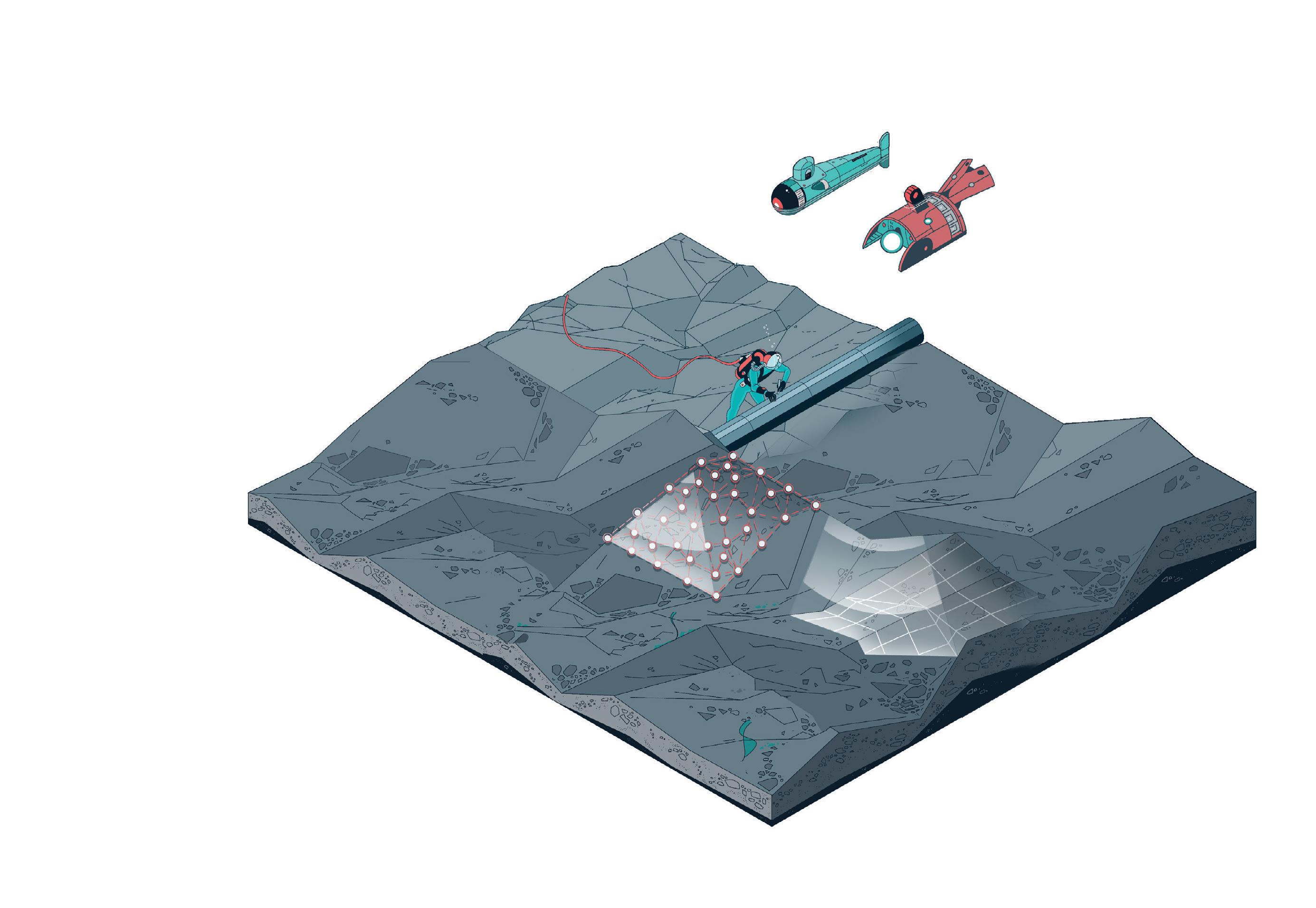
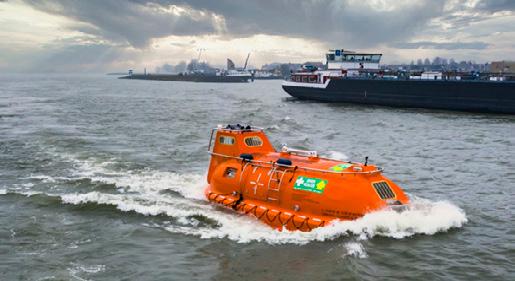




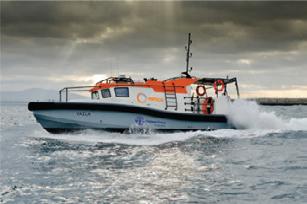


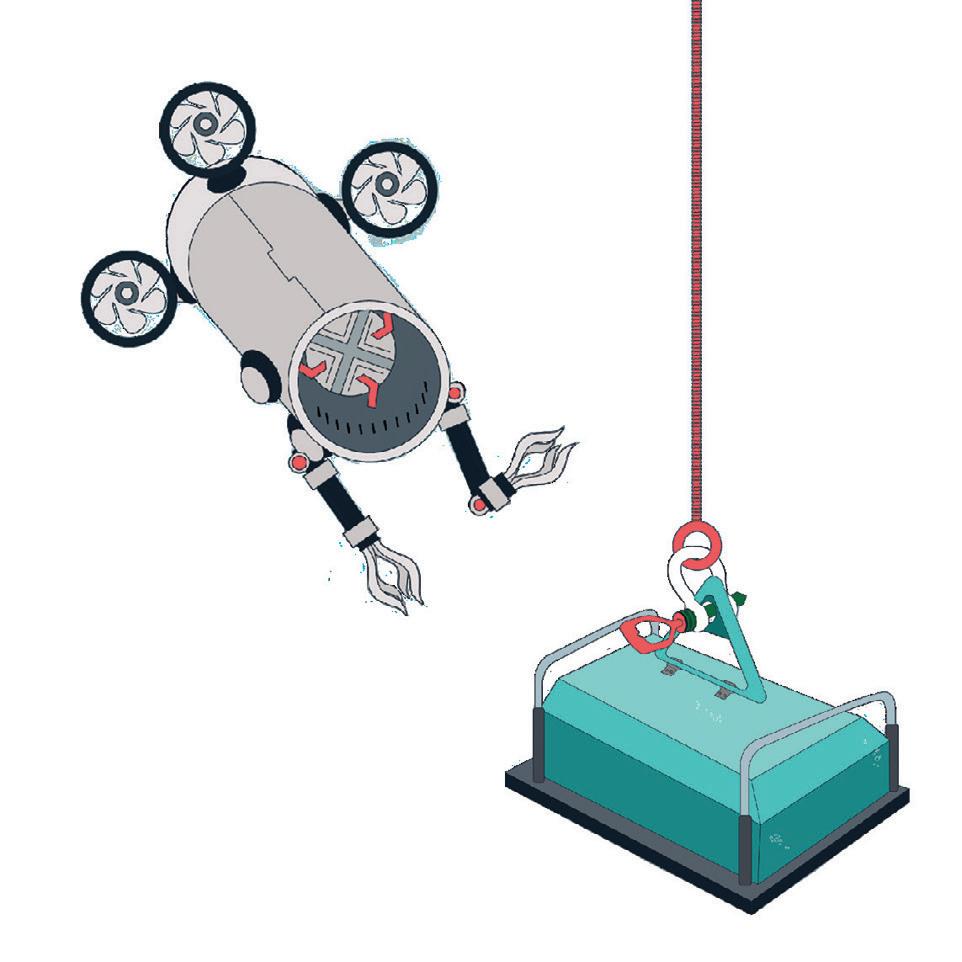







Continued from page 38
exciting with multiple applications for medicinal enhancement using Unique Group dive chambers. “That market was really challenged through the Covid period, but we are seeing it come back with strength across all our sectors,” says Charles.
“We have a number of product developments and solutions that will be taken to the market later this year. In September, we have launched a state-of-the-art generative AI chat solution – Aquila Subsea, which is set to revolutionise the industry by providing instant and accurate responses to a wide range of queries related to marine survey, empowering survey engineers and researchers to swiftly understand manuals, troubleshoot issues, and access critical information.”
Aquila Subsea marks a monumental leap forward as the first-ever generative AI chat solution tailored specifically
for the subsea survey industry. By harnessing the power of artificial intelligence, Unique Group is delivering an unparalleled value addition to survey engineers and researchers, facilitating rapid resolution of technical challenges. With its comprehensive repository of manuals, data sheets, and manufacturer’s information, the AI platform guarantees precise and reliable solutions for queries of all complexities, providing access to a Knowledge Repository with over 10,000 Survey Equipment solutions. Unique Group is excited to announce that limited signups to access Aquila Subsea are now open.
Success in supporting these varied industry sectors sees Unique Group rely on a diverse and widespread supply chain which is thoroughly vetted and examined to ensure efficiency as well as environmental impact. The company is
ambitious for continuous improvement and has adopted consciousness of environmental impact as a core value.
“We take it seriously,” confirms Charles, referring to the nature of the company’s work and its environmental effect. “Our focus on products and services such as unmanned surface vessels support our aims of delivering environmental enhancements to support turning our industry greener than it has been.”
He says that the supply chain spend is “enormous” and this is part of the driver behind an enhanced quality management system focus. Ultimately, Unique Group must deliver cost effective solutions for projects and clients, and this is not about being low cost – “It’s about quality and timing,” says Charles.
“We are looking at expanding our supply chain and elevating it within the group to drive focus and visibility,” he adds. “We want to improve terms
and deliverables to be lean across the business. We have a range of initiatives going on and we are always focused on continuous improvement.”
The enhanced quality management system, which Charles champions as game changing within UG, is encouraging efficiency with every decision. “We are delighted at the uptake and the trend identification and outputs from the system that is supporting driving change,” he says. “It’s all about operational excellence – improving schedules and terms,
driving out waste, enhancing quality, and improving solutions and cost for our clients is a significant step change that will deliver real improvements through 2023 and beyond.”
In the Buoyancy and Water Weights® division, supporting green energy is a key focus and innovation is underway to ensure the company is a strong partner to the wind energy industry. By providing floatation devices for power cables and floating wind facilities, Unique Group calls on its core competencies but is adapting for new scenarios. As well as building on the green energy effort, these initiatives also support efficiency and risk reduction strategies.

“We have some solutions that we are really eager to present to the market. It is a genuine attempt to be part of the energy transition through the products and services that we have right now, with a step change.” says Charles.
In just 18 months, the COO has enjoyed a fast pace and an agile environment as well as embracing the clear opportunity for synergy across the group. Through this, clients have
been delighted and the company’s reputation – started by Harry Gandhi in 1993 – has been advanced. Earlier this year, the company also announced the appointment of Sahil Gandhi to the position of Chief Executive Officer (CEO), succeeding Harry Gandhi, who will now assume the position of Chairman of the Group. With Sahil at the helm, Unique Group is poised to achieve even greater success and drive innovation in the subsea technology sector. The future is equally as exciting as the past 30 years.
“We are still looking at organic developments, and we have some great innovations underway right now, but we also have an eye on the M&A marketplace to complement our existing services and platforms,” Martin Charles concludes, adding that Unique Group will always go beyond the conventional to deliver for clients and create a positive impact.
// WE HAVE SECURED A NUMBER OF CONTRACTS RECENTLY AND, AS SUCH, WE NEED TO INVEST IN OUR DIVING FACILITIES AND STOCK HOLDINGS FURTHER //
Qatar-based New Oil Generation, a joint venture between a Czech R&D company specializing in ground-breaking Exothermic Chemical Treatment (ECT) technology and industrial visionary Muhammad al-Misned, is spearheading a transformative approach to sustainable and efficient heavy oil extraction. Their mission is to revolutionize the oil industry by emphasizing profitability and sustainability through the implementation of advanced ECT technology.
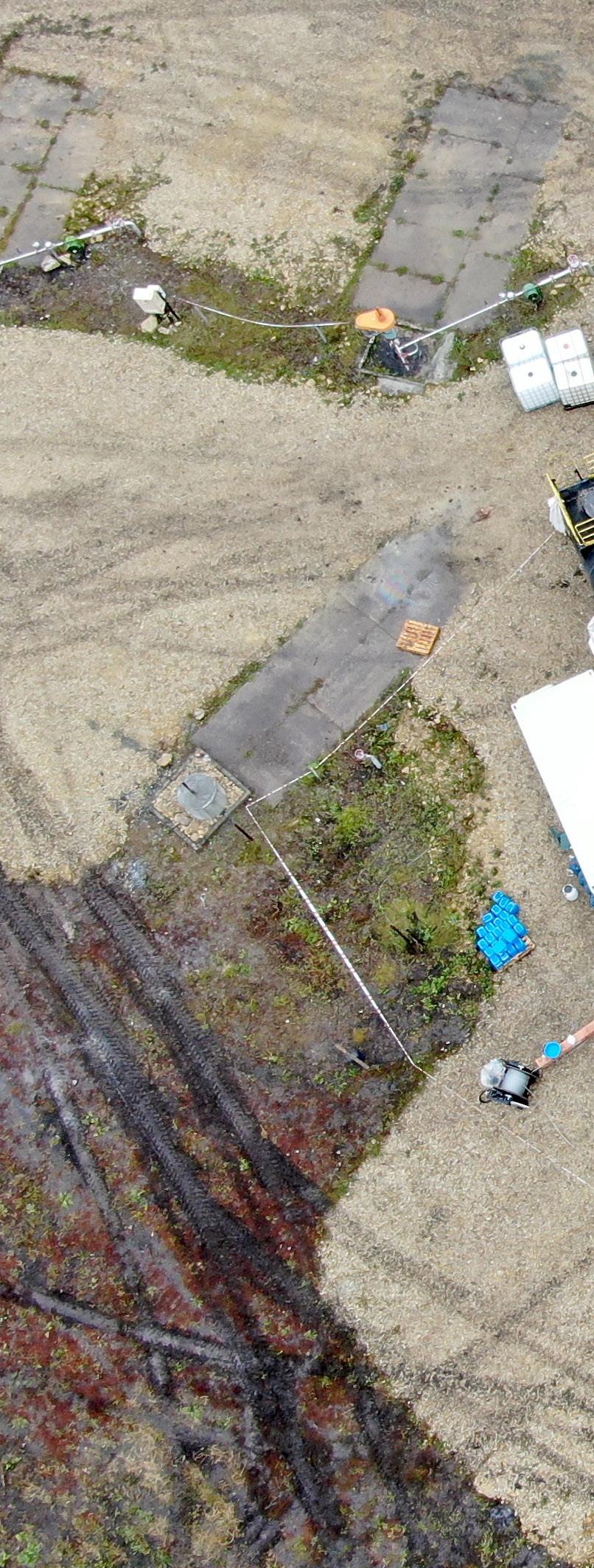 PRODUCTION: Tommy Atkinson & New Oil Generation
PRODUCTION: Tommy Atkinson & New Oil Generation

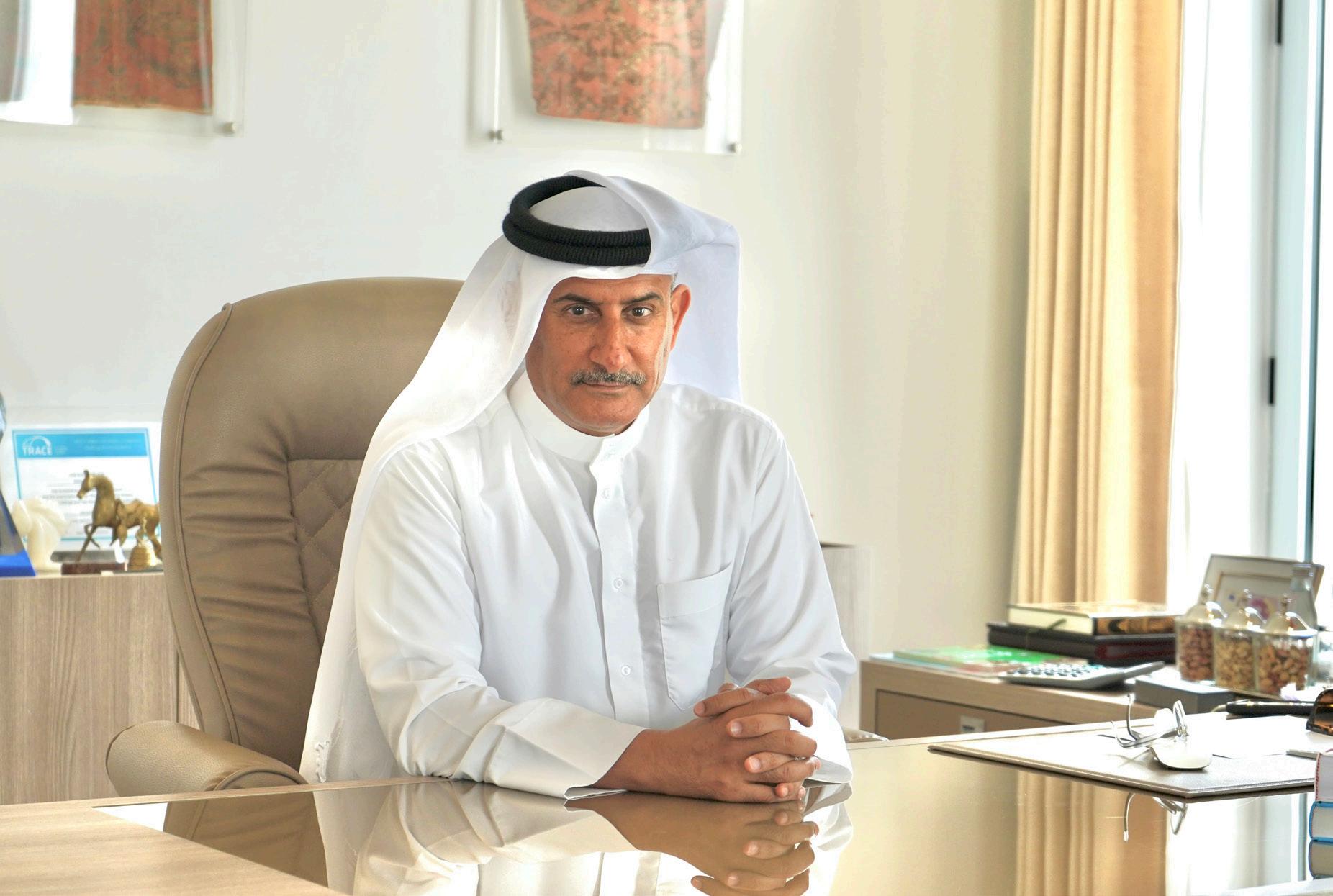
As conventional oil resources diminish worldwide, the significance of vast heavy oil reserves as a future energy source is escalating. Heavy oils now account for approximately 70% of all liquid oil estimates. With conventional Enhanced Oil Recovery (EOR) methods, extraction of these resources has been a challenge, if not a hindrance in terms of profitability, efficiency
and sustainability. Most of the EOR methods increment the environmental footprint, rendering entire extraction operations questionable. Despite the odds, New Oil Generation is introducing a game-changer.
The underlying principle behind thermal EOR methods is to reduce viscosity by introducing heat into the reservoir. However, these methods typically require steam generation on the surface and subsequent injection into the reservoir, resulting in significant energy consumption. Furthermore, they entail high capital investments in steam generation infrastructure, specialized well completion, and terrestrial steam pipelines with heat insulation. This accumulates not only costs, but also carbon footprint with all the necessary construction.
Enter New Oil Generation—a research and development and oilfield service company specializing in innovative EOR technologies. Their ground-breaking ECT technology offers an alternative solution that eliminates the need for further infrastructure development, minimizing the environmental footprint while maximizing profitability. As co-founder, Muhammad al-Misned explains, “ECT provides a comprehensive solution for oil producers facing economic, technological, and environmental feasibility challenges in heavy oil extraction.”
“We use our own in-house developed technology that utilizes binary mixtures of chemicals injected into the wellbore. This thermochemical stimulation generates heat, nitrogen
// HEAVY OILS NOW ACCOUNT FOR APPROXIMATELY 70% OF ALL LIQUID OIL ESTIMATES //Muhammad al-Misned, Co-founder
gas, and pressure in the reservoir, thereby reducing oil viscosity and increasing reservoir pressure,” Jakub Hodinář, the Czech co-founder and brain of the operations details. “Unlike conventional EOR technologies, ECT employs chemicals that generate substantial heat directly within the

reservoir, resulting in minimal energy losses and a reduced carbon footprint in terms of energy and water usage. One of the key advantages of ECT technology is its elimination of the need for surface facilities and steam generation, leading to improved energy efficiency, cost-effectiveness,
and reduced environmental impact.”
New Oil Generation uses a computer-driven modular platform with surface pumping system and command and control unit with integrated sensors on the bottom hole assembly. This technology set-up is mobile, easily and rapidly deployable anywhere, thus not aggravating environmental impact of the upstream operations.
ECT technology aligns perfectly with the oil sector’s increasing focus on sustainability and environmental protection. As Jakub Hodinář highlights, the industry faces growing pressure to adopt cleaner technologies and address greenhouse gas emissions and water scarcity concerns. ECT meets these challenges head-on by
// ONE OF THE KEY ADVANTAGES OF ECT TECHNOLOGY IS ITS ELIMINATION OF THE NEED FOR SURFACE FACILITIES AND STEAM GENERATION, LEADING TO IMPROVED ENERGY EFFICIENCY, COST-EFFECTIVENESS, AND REDUCED ENVIRONMENTAL IMPACT //
providing a high level of environmental protection without further depleting water resources. The binary mixture used in ECT is specifically designed to be environmentally safe, without any dangerous chemicals or residues.
ECT represents the new generation of Enhanced Oil Recovery methods—a green technology
combining environmental responsibility with technological advancements and robust production impact.
The overall efficacy of ECT has quickly gained recognition, challenging established steam-based thermal EOR methods such as SAGD and CSS.
ECT technology has garnered interest from National and International Oil Companies (NOCs and IOCs) across various territories. Its applicability is not limited by technical constraints, allowing for implementation anywhere in the world where heavy-oil extraction, low recovery factor and decreasing production is an issue.
New Oil Generation has dedicated significant efforts and expertise to advance ECT technology, transforming it into the preeminent state-of-the-art tool for EOR of heavy crude oil reservoirs. With more than 15 years of research, development, and field-testing, ECT has proven its efficacy and safety. They offer comprehensive EOR services, including reservoir and well analysis,

// LIKE IN PRECISION AGRICULTURE, YOU HAVE TO KNOW WHERE, WHEN AND HOW YOU NEED TO USE YOUR LIMITED RESOURCES TO KEEP YOUR REQUESTED PRODUCTION RATE WITH LOWEST COSTS //
field deployment of ECT technology and operational management, posttreatment monitoring, consulting, and evaluation. The latest SmartFieldTM ECT solution enables even a long-term technology deployment combined with subsurface data collection, evaluation and more precise EOR operation planning. “Like in precision agriculture, you have to know where, when and how you need to use your limited resources to keep your requested production rate with lowest costs. SmartFieldTM ECT gives you both the knowledge and capability to plan costs, act just-in-time and effectively,” sums co-founder Muhammad Al-Misned.
ECT provides a compelling alternative to traditional thermal
EOR methods, ensuring the highest possible recovery factor sustainably. Muhammad al-Misned encapsulates its value, stating, “ECT offers heavy oil producers using simple, unsophisticated extraction technologies the opportunity to improve efficiencies across the board. High level of mobility of our technology means low and flexible operational costs for our clients. Removing the steam from the stimulation process brings long term sustainability and effectivity of production even in regions with extreme lack of water resources. No waste of water, no greenhouse gas emissions during operations anymore. This is exactly what the world public, company
shareholders and investors expect from the new generation of upstream technologies. We did our job well.”
ECT technology is set to reshape the heavy oil extraction landscape, providing a sustainable, cost-effective, and environmentally friendly solution for maximizing production and minimizing the industry’s environmental footprint. New Oil Generation’s commitment to innovation and efficiency makes ECT the optimal choice for heavy oil extraction in the 21st century.
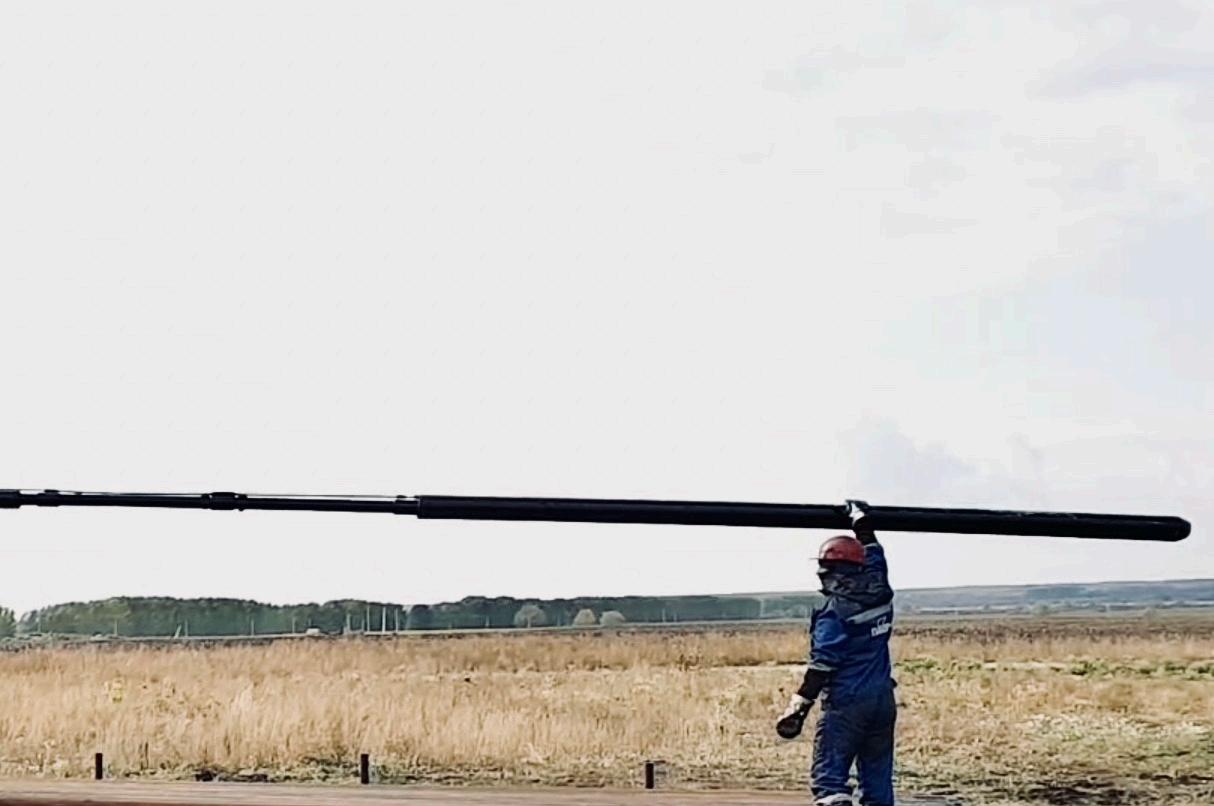
‘The power of tomorrow, today’ is being delivered by European Energy, as it continues on its longstanding mission of bringing clean, green energy to various global markets with a turnkey project approach. Director and Country Manager for Iberia, Enrique Galdos talks to Energy Focus about this unique and exciting business that is already ahead of the pack in the energy transition.
 PRODUCTION: James Davey
PRODUCTION: James Davey

Enabling the green transition is the core vision and purpose of many companies, and many make an impact. But few have the credentials of European Energy, and few can claim to have made an impact on the same scale.
Headquartered in Denmark, but with offices around the world, European Energy is a developer of renewable energy projects, focussing specifically on solar, onshore wind, offshore wind, and power-to-x technologies.
Established in 2004, the company is heading into the year of its 20th anniversary in great shape, posting record results including revenue of €438 million and profit of €110 million in 2022.
When Erik Andersen and Mikael Pedersen founded the business, the idea was to bring alternative energy solutions to markets in Europe dominated by coal, oil, and nuclear. While progress has been made in the
renewable rollout, much remains to be done as European markets remain heavily exposed to fossil fuels and reliant on unsustainable sources.
Europe’s big energy sources (according to the IEA) remain coal, gas, nuclear, and oil. Wind, solar, biofuels, and waste make up a small percentage, with modest progress since 1990.
To succeed in its vision to be a major global force in driving the green transition, European Energy has had to convince investors of the returns available in renewable energy and then demonstrate the effectiveness of generating capacity in a time when every megawatt counts. By handling the entire value chain from concept generation and planning through to design, construction, development, financing, and ongoing maintenance and asset management, European Energy is perfectly placed to take on this tough task.
In Italy, the company recently sold a 103 MW solar farm (Troia), home to 275,000 solar panels. “We can see from this divestment that demand for more renewable energy is high, and we will continue to be at the forefront of green investments in both Italy and the rest of the world to accelerate the green transition,” said CEO Erik Andersen.
In Denmark, the company recently commissioned the 101 MW Kvosted solar farm, capable of producing enough energy to supply 22,000 households.
Earlier this year, in Brazil, European Energy connected the 36MW Ouro Branco I wind farm, with a large pipeline of further development in the country.
In Lithuania, where the energy mix is quickly changing, the Anykščiai wind farm provides power to 73,000 households and European Energy has a strong team in place to take advantage of opportunities. “This project in Anykščiai is our first wind farm project in the country, and I hope that we can contribute even more to the high green ambitions that the Lithuanian government has set,” said Andersen.
Across the Iberian peninsula, renewable energy is an obvious solution, with significant sunshine hours each year, and a long coastline suited to wind energy activity. European Energy has an office in Barcelona from which several projects are overseen, and Spain is a great example of where government policy, population ambition, and common sense have come together to transform the energy mix, growing from around 20% to more than 40% generation between 2008 and 2022.
Enrique Galdos is the County Manager and Director for European Energy in Iberia and he explains that power-to-x (PtX) will be game changing in his territory and beyond.
“Our core business is as developers, but we do the full chain. We develop our own projects, provide our own equity, and source the short- and long-term finance internally and with external

partners. When it comes to construction we try as much as possible to be our own EPC. In terms of strategy around saving energy, we have had good success with BPA with Nissan, Google, Apple and more,” he says of the group.
“The company has grown a lot. I started 15 years ago as employee number 12. Three years ago, we had 200 people, and now we have 650 people, active in 25 countries with 22 offices, mostly in Europe but with presence in Australia, America, and Brazil,” he adds.
KASSØ PTX
PtX projects are already confirmed for 2023, with Denmark home to the first for European Energy. The concept involves using renewable energy to create electricity which is combined with water for the production of green hydrogen. This can then be engineered with biogenic CO2 to produce e-methanol.

“We are making the biggest e-methanol and hydrogen power plant right now which consists of 300MW of
wind, 50MW from an electrolyser, CO2 capture, with a e-methanol facility. We have already signed agreements with companies including Maersk, Novo Nordisk, LEGO Group, Circle K and more.
“We believe in renewables but we are pioneers in PtX,” says Galdos. “We are amongst the first companies in the world to invest in this at scale and so we are providing practical knowledge on
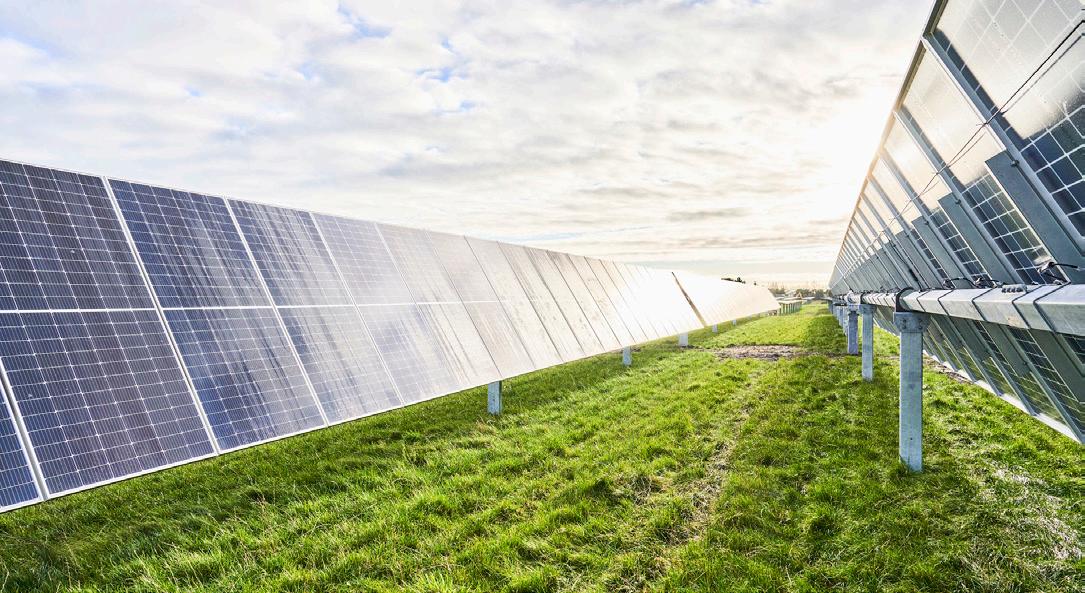
how to do things. While I’m sure there is theoretical knowledge, we are pioneers to complete a project on this scale.”
By creating e-methanol, described by European Energy as a fuel of tomorrow, the company believes it can gain a first-mover advantage as a lead supplier of a reliable alternative to fossil fuels used in shipping and other transport today.
“E-methanol is 100% renewable and combustible, and a direct alternative for diesel. Maersk has already committed by 2030 to use e-methanol to lower their carbon footprint,” confirms Galdos. “They have already ordered new vessels that will run on e-methanol. If e-methanol becomes as big as many players think it will then it could become a global alternative for diesel. That is where we are aiming, and we see big facilities making e-methanol in different areas around the world. In the future or mid-term it could be traded in the same way we trade oil.”
Spain and Portugal are tactically placed on the world map for shipping companies, and have green energy production in abundance making them preferable nations for the process of creating e-methanol.
“These were some of the first countries in which you could develop without subsidies,” explains Galdos. “Now, renewables might become
less profitable because interest rates are rising and returns for investors go down, and that means we have to reinvent ourselves. But if you have cheap water and cheap power, you can make the cheapest hydrogen. If you make cheap hydrogen with biogenic CO2, then you can make the best priced e-methanol compared to other places in the world. Spain and Portugal can potentially be a big hub for e-methanol as they are strategically positioned and have the best resource. As long as we bring the cheapest price, it will bring a lot of investment in industry.”
At the Kassø solar farm in Denmark – European Energy’s 300MW PV plant in the south of the country – a 32,000 metric tonne, carbon neutral, PtX facility is nearing completion. The largest commercial e-methanol plant in the world, this is a major step forward in the decarbonisation of global freight. The project involves 900 pipe spools, 17 km of underground

pipes and 2,200 valves. More than 100 larger procurement agreements have been facilitated for the project.
“It is opening so many doors for us to partner with new players. Many companies are interested in partnering with us,” says Galdos.
In traditional renewable energy projects, European Energy remains focussed on the ever-reliable sun and wind.
In Madrid, in October, an international energy summit will host delegates from around the world, just before the COP28 Climate Change Conference. The urgency of accelerating the clean energy transition will be discussed and the priority of limiting global warming to 1.5°C will be readdressed. At the same time, European Energy will be busy with around 50 projects across Spain and Portugal, with just over 3GW in various stages of development
across different technologies.
“We are making a difference. We have been active in Spain since 2007. In the first round of renewables we did around 14 projects with an investment of €65 million,” highlights Galdos. “The capacity that has been installed in Spain for PV and wind in the past three years is very good and one of the highest in Europe.”
Typically, the company takes a strategy of owning the entire project and bringing it to fruition, before selling 50% to release funding for organic growth. This model has been highly successful and has fuelled European energy’s rapid expansion.
“This year, we have more than 1GW in construction in six different countries, and we have reached the milestone of having more than 1GW of projects in operation. Our turnover comes from two sources – selling power but also selling projects,” details Galdos.
“Every year has been better than the previous, and last year was our record yea. We have always reinvested profits and we want to continue to grow the company with entrepreneurial spirit, even though we have grown so much. We like to be a part of the green transition – we want to be a part of the change and that is why we are working with all the technologies that we are.”
In Q2 2023, European Energy continued to display strong financial performance, highlighting exactly what is possible for effective renewable
Vertimass LLC is advancing a novel catalyst technology for the conversion of alcohols (methanol, ethanol, butanol and others) into low-carbon biofuels, including:
• Sustainable Aviation Fuels (SAFs)
• High-octane gasoline blend stocks
• Propane and butane liquefied petroleum gas (LPG)
• Benzene, toluene, ethylbenzene and xylene (BTEX) plastic building block chemicals
Contact investmentservices@vertimass.com
energy project businesses. Q2 EBITDA and profit before tax both grew by more than 200% to €36.1 million and €21.7 million respectively.
Key in sustaining this impressive growth is agility and entrepreneurial spirit. “That differentiates us from other players,” says Galdos. “We all want to be enablers of the green transition but each company has their own way. We must keep our DNA and value and culture. We must focus on the markets where we are now as there are a lot of chances to keep growing in all of them.”
European Energy aims to grow into a global force that champions the green transition, develops green energy solutions and encourages the world to join the movement towards a fossil free society. Galdos and the rest of the team are driven by the enthusiasm and passion of the
senior management, which retains ownership to ensure nurturing of that entrepreneurial attitude.
“The owners are the management and they are very inspiring leaders. It is fantastic to work with people like this and they bring energy to the company. We have strong values, we really believe in the green transition, we want to be enablers for other companies to do things with us, and we want to make changes for the better,” says Galdos.
With 987 MW under construction at the end of Q2 2023, and a significant potion set to be ready by year-end, European Energy is truly enabling the transition and creating a lasting impact.
// THIS YEAR, WE HAVE MORE THAN 1GW IN CONSTRUCTION IN SIX DIFFERENT COUNTRIES, AND WE HAVE REACHED THE MILESTONE OF HAVING MORE THAN 1GW OF PROJECTS IN OPERATION //

Financing and building energy projects for large manufacturing corporates, On Site Energy has found its niche in the market. As companies strive for net zero, On Site Energy helps with a fully funded structure to unlock the full sustainability potential of each site, using innovative energy efficiency and onsite generation technologies. Founder David Kipling tells Energy Focus more about this exciting, powerful young business.
PRODUCTION: David Hill

The team at On Site Energy is driving a fresh new strategy for net zero attainment. Most large companies are onboard with the idea of reducing emissions by 2030 and then cutting all possible emissions completely by 2050. Corporate targets are ambitious but full of opportunity.
However, the true cost of achieving the required reductions is vast – in some cases all-new technologies are required,
and complete overhaul of existing operations presents many hurdles.
On Site Energy, the Liverpool headquartered energy solutions provider, is helping clients to achieve sustainability goals while minimising energy costs and doing so without major upfront capital expenditure.
Prior to founding On-Site Energy in 2021, David Kipling had been Vice President at a NYSE-listed manufacturing corporate with a leading role in corporate venturing in distributed commercial energy technologies. He led a team rollingout an innovative energy savings process across the business’ factories globally. In that role he identified the issues preventing listed companies from more widely adopting energy savings opportunities and sustainability measures, which has been a key learning in On-Site Energy’s business model.
Using solutions such as combined heat and power systems, solar PV, onsite wind generation, waste heat to

energy, gasification to energy, energy storage systems, and much more, Kipling had witnessed significant cost saving results and efficiency improvements earlier in his career. Employing these technologies in a fully funded structure at manufacturing sites in the UK made sense.
To date with On Site Energy, the journey has been exciting, and Kipling is now looking at fresh horizons for new opportunity.
“We focus solely on private sector manufacturing companies, typically those spending over £1 million on their energy costs annually,” he tells Energy Focus. “We are completely agnostic to any technology or supplier, and will always take a data-led, holistic approach to analysing a site’s energy performance and designing a solution. We are different from a solar company – we are not a single product vendor. We come as a problem solver and offer a solution for those trying to drive towards net zero within certain parameters. We
enable that action through human and financial resourcing options when companies don’t have the resources needed to deliver sustainable energy projects. We fund projects and deliver them with a zero-capex energy supply agreement model. At our core, we are all about making things happen.”
An expert understanding of identifying the suitable solution, and a very strong background in accountancy, the On-Site Energy team have sparked a revolution for manufacturing companies, allowing them to unlock potential that would otherwise be unachievable.
The idea to bring the entire suite of products comes from Kipling’s experience in the industry where he saw companies either able to afford new systems but not sure how to best implement, or companies with a clear understanding of what they need but no money to complete the rollout.
Now, any sizeable manufacturing company with environmental ambitions can change their energy consumption for the better, using a finance model that provides flexibility.

“Our core business is developing a concept solution to a customer’s energy needs based on their data,” says Kipling. “We come up with a plan that includes one or more measures to achieve their goals while improving cost and carbon position. We present that to the client with two options. Firstly, where they fund the capex, or secondly where we fund the capex, and
we set out the benefits of each route. Our preferred model is the zero-capex model where we fund everything. We would then pay for everything that is involved in the project. We charge customers for the electrical or thermal energy generated at a pre-agreed price – a discount to what they’re currently paying to the grid.”

After just two years in business, On Site has around £20 million of zero-capex assets operating, with another £80 million in development or construction right now. The company has grown to become a thriving home of 15 people with a robust supply chain, and revenue is expected to more than triple by the end of 2025.
“We started with one technology, and we are expanding with three other technologies to add to the original. That means we will start to form a
microgrid onsite and look at things like inter-seasonal heat storage to move load shift around,” suggest Kipling. He highlights a current project where a large, national automotive manufacturer that uses around 200,000 MWh of electricity and thermal on site annually as a great example of what can be achieved. “We have developed a three-step approach to get them down to net zero on site by 2030 – ahead of targets. We’re in the process of implementing that with things like heating demand reduction and overhauling controls in the air handling units to installing generation on site while adapting to hydrogen.”
To deliver such an offering with such a small team, On Site outsources much of the engineering, construction, and
Decentralised generation and supply of electricity and heat for operation with natural gas, biogas, other lean gases, biomethane, and hydrogen

// WE COME AS A PROBLEM SOLVER AN OFFER A SOLUTION FOR THOSE TRYING TO DRIVE TOWARDS NET ZERO WITHIN CERTAIN PARAMETERS //
connection activity, handling all of the financial structuring internally. To ensure quality at all times, the company is hands on with the supply chain, vetting and reviewing to deliver best-in-class.
“Supply chain falls into two main categories – equipment suppliers, and mechanical and electrical consultants and contractors (including CDM),” says Kipling. “We’re in a position to fund the right projects up to a large scale. We have third parties who like what we do and can come in and refinance projects when they’re operational. Our current strategy is to build with our own money and then refinance to bring in dept and release equity to go again. We’re not linked to a financial institution and we’re very flexible in the terms and structure we can put together,” he adds.

A dedicated team prepares supplier evaluation when putting
contracts out for tender. To provide continuity on site, the team will look at incumbent suppliers already active with a specific client and try to work with them to make any process as seamless as possible. “Providing they are competitive and of the right quality, we will always get the incumbent a chance. Often, they are the right fit and they improve on quotes compared to others,” says Kipling.
Growing quickly, buoyed by legislative requirements for decarbonisation combined with strict ESG obligations, On Site Energy has a number of companies hoping to put its ISO 14001-accredited influence to work. Kipling details that the pull from Europe is also being felt as existing clients look to replicate success achieved in the UK.
“We are 95% in the UK and we have agreed our first project in the Netherlands,” he states. “We are also in the early stages of looking at project in Germany and Serbia. The plan is to expand into Western Europe, but we will follow our customers wherever they want to go with us. Our customers tend to be multi-site operations and we often strike relationships on the core site before following around different jurisdictions.”
He explains that, as success continues both at home and abroad, the company will set up satellite offices to support operations on the continent. The first will likely be in the Netherlands to service the Netherlands, Germany, and Belgium.
The important issue, Kipling says, is that clients consider grid access early in their planning process. Grid
congestion has long been overlooked and is a source of regular frustration for project developers, especially in the UK. In 2021 alone, the country wasted 7TWh because of congestion.
“A number of people are
blindly planning their net zero or decarbonisation targets assuming they can connect a solar array here and a wind turbine there. The reality is different, there are long delays and we try to educate clients while helping them to negotiate their way through the grid application process,” he says.

But On-Site Energy has built a team of people able to address most questions from clients, including those about grid access, complex technology rollout amidst a global logistics challenge, and unpredictable economic climate. “We have assembled a really good team. We are starting to get companies talking about us and companies approaching us for repeat business. These are large blue-chip customers, and that feels really good. We are creating something a bit different, and that is enjoyable,” Kipling beams.
By addressing both the need for
inventive thinking as well as financing solutions, On Site Energy is brining true solutions to the problems of clients. Not a one size fits all approach, each project is different and each solution is tailor-made. For those large manufacturers serious about net zero, a partnership with On Site could be the answer to multiple questions all in one.
“Innovation sets us apart. We don’t boast that – people tell us that,” concludes Kipling. “We develop more innovative solutions, and we are prepared to take a wider technology brief than others. We will take on projects that others will see as too challenging - we not afraid of technical challenges.”
// A NUMBER OF PEOPLE ARE BLINDLY PLANNING THEIR NET ZERO OR DECARBONISATION TARGETS ASSUMING THEY CAN CONNECT A SOLAR ARRAY HERE AND A WIND TURBINE THERE //
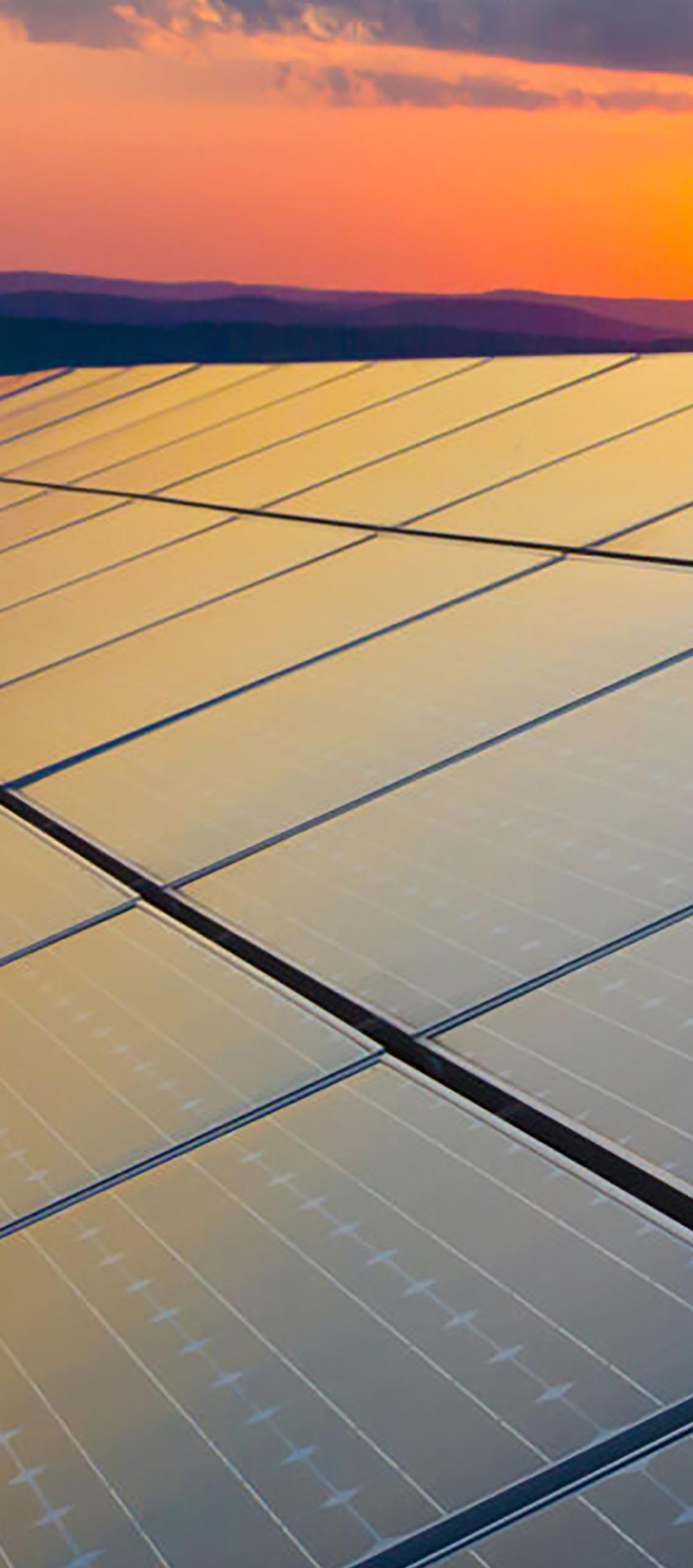
PRODUCTION: David Hill
Solarsense is a leader in design, supply, installation and maintenance of solar panels and other renewable energy technologies in the UK. Hoping to green the energy system by helping to upgrade infrastructure, the company is looking into new opportunities where its experience can be deployed. Founder and MD Stephen Barrett talks to Energy Focus about the bright expertise within Solarsense.
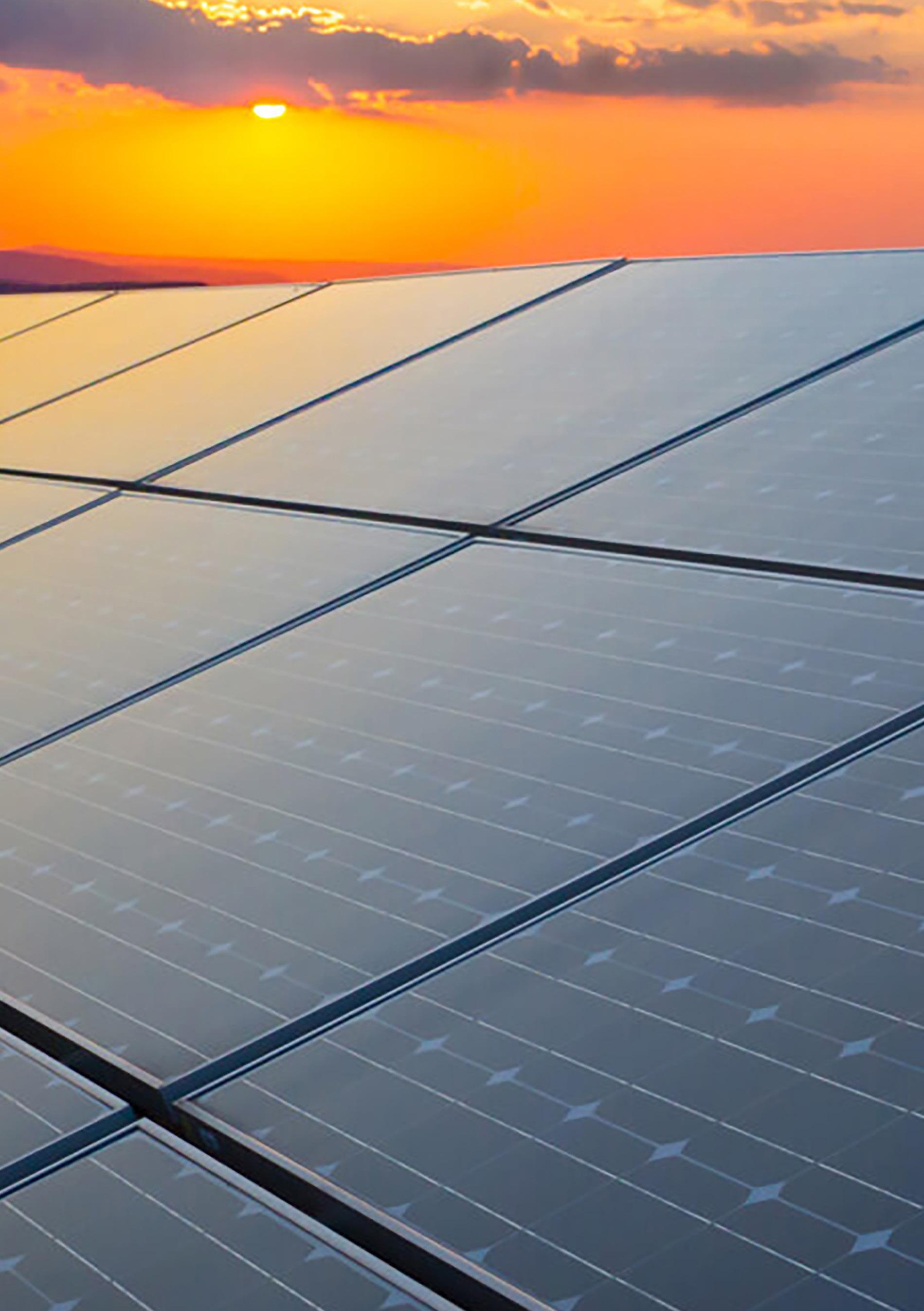
Installing solar panels on rooftops around the UK is no new phenomenon, but doing so en masse is a challenge that has yet to be overcome. Today, solar panels are cheaper than ever before and solar power remains one of the most affordable green energies to rollout for domestic or commercial applications. But just 3.9% of homes have solar panels installed. The UK government

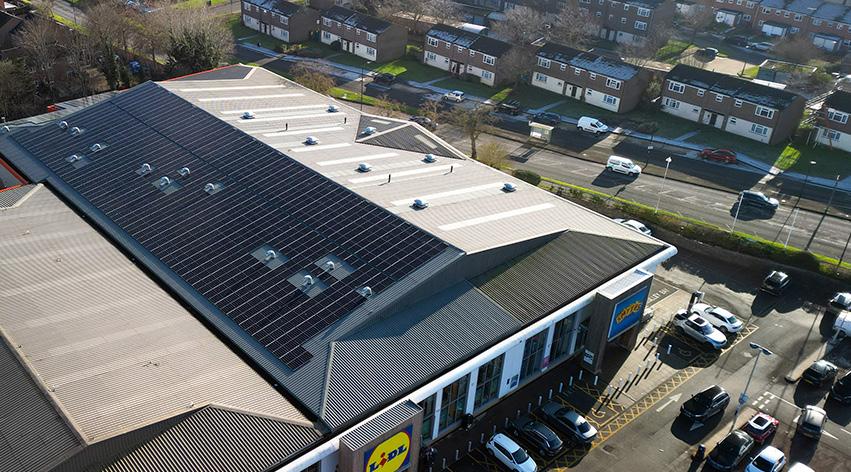
has labelled the industry one with ‘untapped potential’, highlighting commercial rooftops in particular as an area of major opportunity.
The hurdle is designing, procuring, and installing generating capacity in a cost-effective manner. At the same time, alternative solutions are required to complete a system that will protect home or commercial sites from price and supply issues.
To make the most of the potential, expert companies with a deep understanding of this hot market are required. Some reports suggest that existing rooftops and other land, such as car parks, could provide 50GW of energy for the UK market by 2035. One of the leaders in the UK is Solarsense, a rooftop PV specialist with expertise across multiple technologies.
Established 27 years ago by Managing Director Stephen Barrett, Solarsense became a ltd company in 2000. Early in its life, Solarsense was a solar thermal company, using solar panels to create energy for the heating of water. Typically, this reduced electricity costs for property owners. When the obvious success of the solar industry was becoming apparent, Barrett and team adopted the technology, as well as off-grid solar solutions, to create microgrid systems for clients. From there, Solarsense exploded in popularity, growing to become
recognised as an industry leader, carrying out projects all over the UK.
For Barrett, the advantage is being able to build a successful business while contributing to the energy transition, and helping property owners to reduce their bills. Since its establishment, the company has completed more than 15,000 residential, commercial, and industrial renewable energy projects.
“We’re mainly an on-roof commercial PV designer and installer,” he tells Energy Focus. “We are focused on carports, batteries, heat pumps, and solar thermal, and we also do larger ground mounts, up to about 5MW. We undertake both commercial and domestic work. We work nationwide but we have a particular focus on the South and Midlands. We certainly want to expand more into the northern area, and into Wales.”
Solarsense infrastructure generates around 80,000MW of clean energy annually, offsetting around 22,500 tonnes of carbon emissions.
The company’s portfolio is littered with examples of prestige work for clients big and small. At St Mary’s Rugby Club, close to Bristol, Solarsense installed a 42kWp solar panel and battery storage system, helping to secure cheaper energy bills and cleaner supply, even in the winter months. In Somerset and Gloucestershire, Solarsense installed a range of technology across five sites for the regional fire and rescue service. The results was a saving of more than 127,000kg of carbon per year, scooping Solarsense a Clean Energy Scheme of the Year award at the Regen Green Energy Awards in 2022. At the Dorset manufacturing site of the Lush Cosmetics – a highstreet cosmetic and beauty brand – Solarsense put in a 127kWp solar installation with 378 panels that mitigates more than 36,000kg of carbon emissions annually. At the top end of the scale, Solarsense was called on to install a 171,930kWh system atop the Lidl supermarket in Slough, west
of London. More than 47 tonnes of CO2 emissions are mitigated annually thanks to a 550-module solar project. “Solar PV commercially, for landlords, is a market that is quite young. They are now seeing it as a source of extra income,” explains Barrett. “A lot of tenants are interested but they don’t own the buildings. Bringing that in makes a big difference. We are working with a major landlord who has changed their policy and is now very open to the idea. They have a tenant that wants solar on the roof, we can put that in, and the tenant takes the power – it’s all remotely monitored so everyone knows how much they are paying. The tenant gets green power and it’s a nice model. That engagement from landlords is what was missing previously.”
Barrett puts the company’s success down to its experience. “Very few companies go back 20 years in this field,” he says. “We are probably the most
experienced installation company out there and we have completed a lot of the ‘firsts’. We did the first scheme under the government feed in tariff. We did the first large scale roof at Glastonbury festival site, Worthy Farm. We did the first large scale solar car port.”
He is ambitious about the future and has set out a clear growth path for Solarsense to continue building on the success it has achieved to date. Traditional solar systems will be rolled out, but Barrett says solar carports are set to become very popular in the future.

“As roofs get filled up with solar, and as the demand grows –particularly with electric car charging coming in – we do expect to see growth. It makes sense to cover car parks with solar carports and it can generate a lot of power.”
Solar carports create additional space for PV panels and create investable space from what would otherwise be unproductive. They
can protect vehicles, keeping them cool in the summer and charged (for EVs with relevant charging connectivity). They also help to make a clear and obvious statement about environmental ambitions to employees and external stakeholders. There are also incentives and schemes in place to assist companies to
rollout carports where applicable.
“Our expansion into solar carports is something we are particularly excited about,” Barrett says.
As the company’s reputation and service portfolio grows, so will its engagement within the communities where it operates. Barrett and team of 45 people have long followed the belief that giving back is an essential criterion for successful businesses. A robust corporate responsibility culture sees Solarsense the recipient of many awards and, longer-term, advancing the goals of the business – to drive the uptake of clean energy in the UK.
“We work a lot with charities and we are installing systems on a number of charity buildings and hospices,” says Barrett. “We have also partnered with Rainforest Concern and donate a percentage of income from every large-scale installation to the charity, helping to protect rare rainforest habitat in the Tropical
Andes, one of the most biodiverse but threatened regions on the planet.”
Helios House, the company’s HQ, is a centre of excellence for renewable energy, sustainability, and biodiversity, where seminars and demonstrations are held to showcase possibilities.

“We are proud of the ‘firsts’ we have completed and we were happy to win ‘Clean Energy Contractor of the Year’ for the second time at the Solar & Storage Awards. We’ve won more than 20 industry awards now and we try to win something each year
– we’re very proud of that,” smiles Barrett. “Our focus is very specialist - we do a lot for Duchy of Cornwall and the Windsor Crown Estates.”
To ensure longevity and resilience in the systems it installs, Solarsense looks to work alongside the world’s best equipment suppliers. Innovative and known for quality, but also able
// AS ROOFS GET FILLED UP WITH SOLAR, AND AS THE DEMAND GROWS – PARTICULARLY WITH ELECTRIC CAR CHARGING COMING IN – WE DO EXPECT TO SEE GROWTH //
to supply in the right quantities at the right time, are the key elements Barrett looks for in a partner.
“We procure on a case-by-case basis and we always look for Tier 1 suppliers. We work with companies from all over the world, especially the UK, South Korea, Japan, Singapore, Norway, and elsewhere across Europe.
“We did face big shortages and we did have to bulk buy, but it has settled down,” he says of the supply chain turbulence felt postCovid. “Right now, we don’t face any major stock challenges.”
In the UK, CoolSky is a partner for Solarsense, offering a wide range of products, including control systems, hot water systems, and solar accessories. As official distributor of the Apricus Solar Collector equipment, CoolSky is a vital connector of

technologies on the sites where Solarsense delivers infrastructure. Going forward, the business – which has been growing 30% y-o-y for the past three years – is looking to use its expertise to solve problems in public infrastructure.
“Solar carports, heat pumps, and EV charging industries are set to boom,” says Barrett. “But we are also looking at solar thermal for swimming pools - solar thermal was our original background. Many public pools are being forced to close because of the energy costs required to run. It has been forgotten that solar thermal can be added to PV to create a thorough system that can heat water with much less carbon emissions and less expensive gas. It’s an opportunity that we feel is being missed and one we hope to
take advantage of. The government is now giving support to save energy in these pools, and that is key.”
With so much potential across so many different areas, the future is certainly bright for Solarsense. This energy expert is growing quickly, not only because of demand in the industry but because it has a reputation for quality unmatched by others. Reducing costs and going green has never been easier, and Solarsense is the proven and open provider, powering the UK towards a clean energy future.

The curious minds at Glen Dimplex continue to invent and innovate to bring more green, environmentally friendly product solutions to consumers around the world. By investing in new ideas and enhancing connections in the supply chain, the group is expecting further progress in its mission around sustainability. CTO Dr Elaine Lancaster talks to Energy Focus about ambition in the business.
PRODUCTION: David Hill © Glen Dimplex
© Glen Dimplex
and ventilation is one of our biggest segments and we handle all electric solutions for a sustainable and decarbonised future world. We have a mixture of both electric heating, heat pumps and ventilation products. We are able to offer the right low carbon heating and cooling solutions depending on building architecture.”
A metallurgist and materials scientist of the University of Oxford, with experience across the steel industry and multiple executive positions in the heating industry, Lancaster is confident with the Glen Dimplex strategy and tells Energy Focus that few others can offer a similar range of products and services.
“We have been making heat pumps for decades and where other companies in Europe are coming into heat pumps, we already have longevity. In our markets, we are well ahead in the manufacturer of a wide range of heat pumps, including propane which we started first in France in 2009,” she says.
//Business is booming for innovative engineering firm, Glen Dimplex. Founded by Martin Naughton in 1973, the company has grown to become an international major in the design and manufacture of energy saving equipment used in various domestic and commercial appliances. A recent spate of acquisitive activity has helped to push profits to €42.8 million for the year to 30 September 2022 for Glen Dimplex European Holdings, which makes up 60% of total group operations.
A key driver of the improvement was the heating and ventilation division which was buoyed by demand for
new products as a result of energy efficiency policy within business and government across Europe.
Dr Elaine Lancaster is Chief Technical Officer for Glen Dimplex Heating and Ventilation and she explains that research and development into new products is helping the business to offer clients what others cannot – genuine, easily accessible solutions to climate change problems.

“Our mission is to lead into a sustainable world for all of our customers,” she says. “We do that across heating, ventilation and cooling, flame, precision cooling, and consumer appliances. Heating
“Our electric portfolio has a strong presence in the electric resistance heating market. Combining that with being able to offer full solutions for electric heating is where we are stronger than others in terms of the breadth of our portfolio. Our electric home, where we offer electric heating with heat pump hot water heating and ventilation heat recovery, is a standout area compared to our competition.”
The genesis of the company came with now-Chairman Martin Naughton manufacturing oil-filled radiators. Today, Glen Dimplex owns a number of international brands across various sectors, but energy efficiency is at the heart of everything it does. Recent acquisitions of companies including Hyfra Process Cooling, Adax, the outstanding 30% share in the Muller Group, now Intuis Group, and a minority stake in Wener Finlay are helping Glen Dimplex to build a comprehensive powerhouse, capable of servicing clients across the globe.
// OUR ELECTRIC HOME, WHERE WE OFFER ELECTRIC HEATING WITH HEAT PUMP HOT WATER HEATING AND VENTILATION HEAT RECOVERY, IS A STANDOUT AREA COMPARED TO OUR COMPETITION //
Lancaster highlights supporting connected products as outstanding and an area of obvious growth for the business as consumers search for convenience, efficiency, and reliability.
“We are working strongly on IoT solutions and, compared to others, we have some really strong packages and solutions in energy management and demand side response,” explains Lancaster. “We are looking to expand further, particularly with our thermal battery heating technology. We are keen to make sure we get the full benefits of those storage products within flexible, grid-balancing models.
“We’re really looking to ensure that we continue to lead in electric heating products, and we have some exciting new product coming in the next 18-months, focused further on flexible heating.”
According to the European Environment Agency, heating and cooling still accounts for half of all energy usage in the EU. Decarbonisation in this sector is now taking the spotlight
for both the private and public sector, with fresh legislation and innovation rife across the industry. For Glen Dimplex, the removal of fossil fuels and harmful gases is essential in decarbonising. The bans on use of ozone harming fluorinated gas in products has encouraged change across the industry and using electric technology, fuelled by renewable energy where possible, is essential in future rollout.
“We are working with partners to improve the opportunities for home energy management with our heating products within larger IoT eco-systems,” confirms Lancaster. “We are getting ready for the F-gas bans, transitioning to make sure our customers are ready for that regulation when it comes in. We are looking to bring online a demand-side management response system with our utility partner – British Gas – this year.” Glen Dimplex’s Quantum heat batteries will be available to customers to access favourable time tariffs following the virtual power plant system two-year trial that sought to understand how this
type of heat energy storage product can help to minimise fuel bills, drive efficiency, and balance grids. That project followed on from a partnership with EDF and Kaluza in 2020 where Glen Dimplex provided digitallyconnected heat batteries, supported by an intelligent energy software, to test cost reduction strategies and demonstrate technical capability.
Key customers - wholesalers, installers, OEMs and more – are excited about the pioneering spirit at Glen Dimplex and are already setting up trials and tests for various new digital solutions alongside physical products.
Lancaster, who has been working with solar thermal technology and heat pumps since 2003, explains that everything the company does falls under its wider ambition of driving positive environmental change across the industry.
“I am strongly passionate about the climate change challenge and I want to make sure we can deliver the right products. We are here as

a company to deliver a full breadth of net zero, low carbon electrical heating and cooling and ventilation products, for a sustainable world, to meet the challenges of net zero.”

With 8000 people across €1 billion revenue global operations , the Glen Dimplex umbrella is vast. Key territorial markets for the heating and ventilation business are the UK, DACH markets, and the Nordics. Group activities are also prevalent in Poland, Hungary, Czech Republic, and the name is also established in Australia, New Zealand, and America. “In precision cooling, we have interests in China, America, and Europe. We have a dedicated sales organisation for Ireland and
Northern Ireland, and our division Intuis Group in the French and export market,” adds Lancaster. “We are truly global, and we are well connected in all key markets. We work very closely together on all innovations around heating and ventilation and cooling.”
But externally, the company relies on a large supply chain to progress at pace. Lancaster describes the immense spread of knowledge required across the supply chain, from niche products through to digital solutions, and she is clear that value creation is key as all partners are heavily vetted for quality purposes. Currently, a push to bring suppliers closer together, creating unique expertise bases, and driving efficiency is underway.
“We are bringing our R&D,
technology, engineering and purchasing teams closer and we are busy developing five and 10 year strategies right now,” says Lancaster.
“We are doing a lot of investment in working a lot closer with our suppliers, building strong relationships and exploring ways to add value together. We want to improve our supplier collaborations, so we are not only thinking about current supply but also about strategic development, bringing our suppliers closer to the ideation in our roadmap so that they can be a part of the innovation that we can deliver. We want them involved with our challenges and our customer’s challenges.
“Develop further in areas like data monitoring, is where we can create real benefit for our customers, and using feedback to help inform product development and service delivery are essential,” she adds.
Glen Dimplex is set to take a deliberate approach to supply chain management to protect the
// WE KNOW THE DIRECTION OF TRAVEL AND WE WILL CONTINUE MAKING PRODUCTS BETTER AND BETTER TO GIVE MARKETS WHAT THEY NEED //© Glen Dimplex
local regions where it is strong, while benefitting from globalisation that has provided flexibility.
“We need resilience and we are doing a lot of work to sure up supply areas, like electronics. From a sustainability point of view, we have F-Gas and per- and polyfluoroalkyl (PFAS) substance regulations to consider, around the refrigerant and chemicals contained in some of the products. Pivoting heat pumps to low global warming potential refrigerants in the proposed timeframe is a challenge for us and our suppliers and so close collaboration is key.”
The fast-paced market, and the everchanging demand from consumers, is an exciting and energetic space for business. Glen Dimplex has always
looked to retain an entrepreneurial reputation, taking responsible chances to achieve goals.
“The group comes from many smaller, more autonomous companies, and we don’t want to lose that agility,” says Lancaster. “We want to be agile and empower with fast decision making, but at the same time we want leverage for innovation, investment, and collaboration where it is necessary.
“We, like any company, have challenges around keeping up with regulation – it’s a fast moving, dynamic geopolitical environment and we know it’s hard to give certainty, but we know the direction of travel and we will continue making products better and better to give markets what they need.”
When she joined the company in April 2022, the innovative nature of the business was a key draw. Impressed
with the ambition on show, and excited to put her knowledge to use, especially in the heat pump market, the fit for Dr Lancaster has been perfect.
On the back of great financial performance and with an unwavering commitment to sustainability, Glen Dimplex is on track to achieve its mission. “We have a great opportunity,” she concludes.
A constant desire to find a better way sees the company, after 50 years, stronger and better balanced than ever before.

‘Business as usual’ sees Alba Power continue as the go-to name in gas turbine overhaul and refurbishment for power generation plants and associated infrastructure. Over the past 12 months, the company has focussed on a its core to ensure it consistently delivers excellence and fuels growth for the future.
 PRODUCTION: Eleanor Sarbutt-King
PRODUCTION: Eleanor Sarbutt-King
 Neil Mckenzie, Managing Director
Neil Mckenzie, Managing Director
//“We’ve expanded our headcount by 15%,” says Alba Power MD Neil Mckenzie, talking about the ongoing growth in the business over the past year.
Alba Power, headquartered in Aberdeen (with offices in the US and Canada), is the leading global independent repair and refurbishment specialist for aeroderivative/industrial gas turbines, power turbines and marine tyne turbines, controls, and rotating equipment. Able to provide support for a range of industrial engines including RB211, Pratt & Whitney, Olympus, Avon, Spey, Tyne and Power Turbines, Alba Power has works with clients to find the best solution. field service, tooling supply and rental, inspection, repair, and overhaul is delivered according to ISO quality standards.
Established in 2000, the company is now widely recognised as an industry leader with an unrivalled team. Recognition of Alba Power’s industry leading status came in 2019

when the company was acquired by the global Sulzer Group, offering access to international expertise and supply chains to support an ever-increasing global client-base.
“It’s business as usual, we’re still extremely busy and that’s nice to see,” Mckenzie tells Energy Focus.
Gas turbines remain a prominent part of the energy generation and supply mix, and Alba Power has sold over 5,200 to more than 500 customers across in excess of 80 countries, accumulating well over 145 million hours of operation.
But Mckenzie says that two new contracts which should be finalised imminently will make up some of the biggest in the company’s history.
“We do still have the standard overhauls that are coming through – that is where we thrive and where customers know they will get worldclass service,” he says. “We have also
just won a large contract with a major transport provider in the UK, and we are expecting to finalise details with a significant foreign navy soon. It’s all package refurbishment for big power generation projects and that is something that excites us.”
To gain such contracts is proof of the reputation held within Alba Power, and Mckenzie highlights a long-held vision for brilliance as the power than runs through the business.
“Our global customer base has been built up through industry track record, exceptional customer relationships and customer referrals, as a result of our continued focus on flexibility and 24-hour service provision. This is achieved through our commitment to pursue operational initiatives that maximise the availability, reliability, and cost-effectiveness of its gas turbine support operations, including exchange and lease options.”
Continues on page 77
Score Group’s Energy division is a leading global provider of complex gas turbine accessory and fuel system repair services and is a premier manufacturer of fuel nozzles and accessories. Its headquarters in Aberdeen boast the largest operational aero derivative engine test cell in the UK.

After investing in new technology and implementing the latest regeneration and upgrades to its test cell, the team provide testing capabilities for a multitude of international clients.
Current work involves the full performance tests of Avon (SGT-A20) and RB211 (SGT-A35) engines with the facility offering the flexibility to test a range of additional aero derivative and industrial engines, such as the LM2500, LM1600, TB5400 and RR Olympus to name a few.
At the facility’s core, the precision calibrated test bed is capable of testing industrial gas turbines up to 60MW on both liquid or gas fuel. The facility is also fitted with sophisticated emissions monitoring equipment enabling a real time comparison against legislative requirements such as ISO 11042-1.
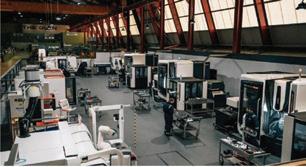
Score has carried out emissions testing for a number of worldwide research institutes and tests can be streamed online, providing web-based remote access is available.

The company also has the ability to service and repair engines through its channel partners and test various gas turbines,


with the aim to minimise customers’ downtime, and provide cost effective, bespoke solutions for industrial gas turbines.
To complement these services Score provides spare parts for various gas turbine applications and supplies a range of gas turbine accessories including actuators, fuel nozzles, lubrication and scavenge pumps, fuel metering valves and bleed valves.

With a series of OEM approvals, capabilities include the manufacture of fuel nozzles, the repair /overhaul of aero derivative engine fuel systems and accessories, on-site support and field services.

The company’s engine test facility has been providing clients in the global power generation and oil and gas industries with a technologically advanced dual fuel gas turbine facility, for more than 20 years.
For more information, contact scoreenergysales@score-group.com

Our expert team pride ourselves on having a partnership approach when working with our customers and offer outstanding product knowledge and technical ability, whilst delivering exceptional service
Andy McLachlan Managing Director +44 7741 666275 andy@hyspec-coatings.co.uk
www.hyspec-coatings.co.uk

Hyspec Coatings is pleased to be supporting Alba Power
HYSPEC COATINGS - HIGHLY SPECIALISED, HIGHLY ADAPTABLE

Contact Hyspec Coatings today for specialised processes in coatings systems and repairs to the industrial gas turbine industry. Hyspec Coatings has built a reputation in the industry around fast response and consistent delivery of the highest standards, working for international experts in the industrial gas turbine industry. Highly experienced and adaptable, this is a business that works hand-in-hand with clients.
Established in 2018, this innovative and ambitious business is nurturing relationships to ensure the best outcomes for all.
“We are a young business, although I have a relationship not only with Alba Power but with many other engine overhaul facilities going back for more than two decades. We work with a range of companies across the industry and all of our clients are very important to us,” says Director, Andy McLachlan.
“Our customers strip down an engine, send us all the engine assembly parts to blast, NDT, recoat, we then return the parts fit for service to the end-user specification.”
ISO 9001 accredited, Hyspec Coatings delivers quality in every element of its process, driving superior standards in the industry.
The company is hungry for growth and has a demonstratable history in the provision of world-class service, on time delivery, and top-tier efficiency.
In November 2022, a research report from Metro Dynamics labelled the UK engineering sector as a ‘hotbed of innovation’, generating around £645 billion and supporting more than eight million jobs (with Aberdeen a particular hotspot).
Alba Power has claimed a Scottish Export Award, SPE Offshore Achievement Award, Manufacturer of the Year Award, alongside many more accolades. The team’s QHSE system has resulted in zero safety or integrity issues over the years. Clearly, engineering here is a major strength.
Aiming to be a part of the energy transition, the company has engineered a unique dry low emission (DLE) offering to reduce NOx releases from gas turbine exhausts. Reducing combustion temperature allows NOx emission to be reduced, and also mitigates the need for water or steam.
“Jet engines are typically not very green,” admits Mckenzie, “but we have developed a DLE modification which cuts down the pollution a lot. We have tested that, and we are working to roll that out into production by the end of the year.”

To undertake research and development and innovation of this nature, Alba Power keeps a strong supply chain, working only with proven, reliable partners that can live up to the reality of delivering world-class product and service.
On the fuel system side, Alba Partners with Score Group for a range of industrial services. Also based in Aberdeen, Score is conveniently located to collaborate with Alba Power and
Mckenzie is highly complementary of the relationship between the pair.
“They’re great partners,” he says. “They supply us with accessories, parts, and knowledge, and they do overhaul contracting with fuel systems. We work very closely with them and it’s all based on quality.”
New team members have been added to ensure transparency and quality throughout the supply chain, and new management and engineering staff have joined the business to help as it grows with new contracts.
New geographies are also on the radar for Mckenzie as he looks to cement Alba Power as an international engineering brand. “We are still growing our marketplace, we are visiting many countries – we have a lot planned for this year,” he says.
“We want to continue our expansion and grow into new markets that we haven’t been in before. Obviously, the impact from the war does affect us. We can’t deal
with Russia now, but there are many opportunities out there. We are very interested in India, and the core focus is to continue our expansion.”
The key to everything that Alba Power does is its independence. “That is what makes us different,” says Mckenzie. Free from interference from OEMs, the company can create its own strategies with the support of the Sulzer Group. What will always remain is an open and honest culture and a responsive nature that is built on solving problems for the customer through excellence. “That is very important for us,” he adds.
In the short, medium, and long-term future, the energy mix around the world is built on highquality functioning turbines. As long as this is the case, Alba Power will keep the blades turning and will remain critical in the life of its clients - a robust position to hold.
// WE HAVE DEVELOPED A DLE MODIFICATION WHICH CUTS DOWN THE POLLUTION A LOT //
As Shell continues to power progress across various energy sectors, its clear goal is to advance the energy transition, shaping the world of tomorrow for the better by investing in low-carbon technologies that drive value and performance. CEO Wael Sawan is confident about the company’s ability and ambition.


//The famous yellow and red of Shell, adorned across energy infrastructure around the world, is perhaps the most recognisable brand in the history of the energy industry. Hailed as an innovator and reliable supplier of liquid fuels for decades, the company was known for world-leading oil, petroleum, and associated chemical products. Where you saw the yellow and red scallop, you knew a premium range was close.
But changes in the world have forced Shell into a fresh manoeuvre. As a globally relevant business, the requirement for addressing climate change, global warming, pollution, and human impact on the planet has ramped up significantly.
Pressure from shareholders, governments, and customers has seen a strategy shift within Shell. Prioritising renewable energy for
the future, and transitioning away from traditional oil and gas, the company is refocusing while ensuring continued value creation. Now, the yellow and red pecten conjures the image of a brand that is integrated, diversified, and active in change.
In September 2022, Ben van Beurden stepped down as Shell CEO, and Wael Sawan former-Director Integrated Gas, Renewables and Energy Solutions took over. Perhaps a symbol from the business around its future intentions, bringing in an executive from a renewables background.
“We want to be a net-zero emissions energy business by 2050,” highlights Sawan.
Employing multiple strategies, the group is looking to reduce its emissions which have been mapped using the Greenhouse Gas Protocol – a globally recognised accounting standard for
measuring emissions. Scope 1, 2 and 3 emissions are problematic, and drivers of climate change, and Shell produces a lot. But the company is reducing its emissions across all areas, with Sawan driving ambitious targets for the coming years.
In 2020, before Sawan took over at the top, the company was busy in the UK market, completing a power purchase agreement (PPA) to supply households with energy from the Dogger Bank wind farm. This power generation monster is located off the coast of Yorkshire and is the world’s largest, with a capacity of 2400MW. Shell’s offtake agreement saw it deploying 480MW.
“Offshore wind will play a key role in the UK’s transition to a low-carbon future,” said Rupen Tanna, Director at Shell Energy Europe. “Power is a growth priority for Shell. This long-term

agreement will enable us to supply more clean power to our customers, while supporting the development of one of the most ambitious renewable power projects in the world.”
Shell was forced to exit the retail energy markets in the UK, Germany, and the Netherlands due to poor returns. But the company’s focus and strategy around renewable energy did not change. “We continue to look at opportunities to invest in offshore wind generation, including innovative wind technologies such as floating wind,” the company states.
With a strong history of managing complex, challenging projects in the North Sea, Shell is perfectly positioned to advance wind energy. MarramWind and CampionWind will be innovative floating offshore wind

farms, delivered by a partnership of Shell and ScottishPower. “This is another step in helping to provide more, cleaner power to homes and businesses,” said Hessel de Jong, former-Shell General Manager Europe for Offshore Wind.

At the end of 2022, Shell
announced that it had, in partnership with Eneco, won a bid to develop a 760MW wind power plant at the Hollandse Kust (west) VI site, 53km off the coast of Ijmuiden. The JV labelled Ecowende will eventually supply 3% of Dutch electricity
demand with green energy.
Sawan was in charge of renewable for the company at the time and highlighted the contribution of offshore wind to the company’s vision. “With Ecowende, we will take a huge step in growing our offshore wind portfolio while making a positive contribution to biodiversity. Through this project we can profitably accelerate the large-scale roll-out of offshore wind in the Netherlands and beyond. This fits well with Shell’s Powering Progress strategy to deliver more and cleaner energy to our customers, at home, on the road and at work.”
Ecowende will take a new approach to wind farm construction and will place towers further apart to allow channels for birds to fly through, innovative foundation techniques to protect marine wildlife, and encouraging natural reefs on the seabed to promote biodiversity.
Adding further diversity to the portfolio, Shell has made acquisitions that have bolstered its exposure to multiple alternative energies. In August 2022, the company announced completion of its acquisition of Sprng Energy, a solar and wind supplier to distribution companies in India. With significant GW under management, and more in the pipeline, the company was a perfect fit for Shell as it tripled its renewable capacity.
“This deal positions Shell as one of the first movers in building a truly integrated energy transition business in India,” said Sawan at the time. “I believe it will enable Shell to become a leader across the power value chain in a rapidly growing market where electrification on a massive scale and strong demand for renewables are driving the energy transition. Sprng Energy generates cash, has an excellent team, strong and proven development track record and a
healthy growth pipeline. Sprng Energy’s strengths can combine with Shell India’s thriving customer-facing gas and downstream businesses to create even more opportunities for growth.”
Shell had more than 11,000 employees in India in March 2023 and it expects to boom with more equipment and revenue coming from India in the next five years.
In February 2023, the acquisition of Nature Energy was finalised. This Danish producer of renewable natural gas from waste appealed to Shell because of its remarkable infrastructure and assets, and its value creation potential.

“Shell’s competitiveness in low carbon fuels derives from capabilities across the value chain, combining a world-class Trading and Supply organisation with access to differentiated technology and
Continues on page 84
At Bureau Veritas, each and every one of us is by your side to help you navigate your decarbonization journey.

Supporting you with practical advice, tools and technology for you to make the right decisions for your business.







Learn more at marine-offshore.bureauveritas.com

Shaping a better maritime world.









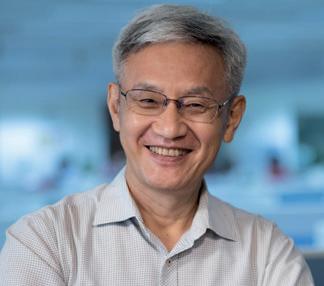

Continued from page 82
production assets,” said Huibert Vigeveno, Shell’s Downstream Director. “Acquiring Nature Energy will add a European production platform and growth pipeline to Shell’s existing RNG projects in the United States. We will use this acquisition to build an integrated RNG value chain at global scale, at a time when energy transition policies and customer preferences are signalling strong growth in demand in the years ahead.”
Planning for the longer-term future, Shell has committed to hydrogen as a clean, abundant fuel that will change the way many people and businesses power their lives. Already invested in hydrogen refuelling for vehicles, and owner of a major amount of hydrogen electrolysers, the company can produce thousands of tonnes every year.
In July 2022, Shell committed to the build of Holland Hydrogen

I – Europe’s largest renewable hydrogen plant, when operational in 2025. At the Port of Rotterdam, the electrolyser will produce 60,000 kg of renewable hydrogen every day. Power for the electrolyser will come from the Hollandse Kust (Noord) onshore wind farm and hydrogen will fuel the Shell Energy and chemicals Park through the HyTransPort pipeline.
“Holland Hydrogen I demonstrates how new energy solutions can work together to meet society’s need for cleaner energy. It is also another example of Shell’s own efforts and commitment to become a net-zero emissions business by 2050. Renewable hydrogen will play a pivotal role in the energy system of the future and this project is an important step in helping hydrogen fulfil that potential,” said Executive Vice President, Emerging Energy Solutions at Shell, Anna Mascolo.
In the same way as Shell leads petroleum fuels now, the group is positioning itself to lead, globally, in hydrogen in the future. Already
confirmed by most major government as a successor to fossil fuels, there is no doubt that hydrogen will be a vital part of the energy mix going forward.
At the same time, the company is taking a managed approach to the transition, not neglecting its customers demand for energy that powers life and keeps people out of poverty. Oil and gas will remain part of the global system for decades and Shell will remain an industry leader. In the UK, the company restarted its Pierce field, previously a major source of oil, upgraded to produce gas. The Haewene Brim FPSO was overhauled to produce 30,000 boe per day. Previously, gas had been reinjected into the reservoir, but a new subsea gas export pipeline, connecting into the SEGAL system, brings gas ashore near Aberdeen.
“The completion of this major project is testament to Shell’s longstanding commitment to the UK North Sea,” said Upstream Director, Zoe
Yujnovich. “We took this investment decision in 2019, and it is now increasing locally produced gas right at the time when this additional
supply is critically important for the UK’s energy security. It’s a source of huge satisfaction when projects like Pierce come to fruition.”

Wael Sawan will speak at ADIPEC – the world’s leading energy exhibition and conference – in Abu Dhabi in October and will make it clear that the challenge of climate change is one we must face together and one which requires innovation, but it is a challenge that can be overcome. “What is certain, is that we have to act together. Significant collaboration between government, industry, customers, and society as a whole is vital in transforming both supply and demand, sector by sector,” he says.
Confident and ambitious, Shell is on target to achieve net-zero emissions by 2050. Global policy positions are structured throughout
the company and its subsidiaries, and the company continues to push others, including government, to advance all transitional activity as fast as possible.
“I’m looking forward to channelling the pioneering spirit and passion of our incredible people to rise to the immense challenges, and grasp the opportunities presented by the energy transition. We will be disciplined and value focused, as we work with our customers and partners to deliver the reliable, affordable and cleaner energy the world needs,” says Sawan, convinced that all in yellow and red, working together, can make changes and progress that shape the world of tomorrow for the better.

// WE WILL BE DISCIPLINED AND VALUE FOCUSED, AS WE WORK WITH OUR CUSTOMERS AND PARTNERS TO DELIVER THE RELIABLE, AFFORDABLE AND CLEANER ENERGY THE WORLD NEEDS //
Secure, simple data sharing with 3rd parties
Buchan Offshore Wind will develop a floating wind energy resource in the North Sea off the Scottish coast, capable of powering hundreds of thousands of households. Leading the way in floating energy infrastructure, the three key partners in the organisation are guaranteeing a lasting impact by investing in a Scottish supply chain and Scottish skills so that Buchan Offshore can be a demonstrator for others around the world.
A By 2030, the Scottish government hopes to achieve 11GW from offshore wind power. But, given the conditions around the coast, and the interest from developers, that vision could be accelerated to 20GW in the same time. Shallow waters, strong winds, fantastic supply chain, and worldleading ambition makes Scotland – the home of energy engineering – the perfect place for wind energy to grow.
One of the key elements that make Scotland perfect for building this
important industry is its history. For many years, Aberdeen has been the oil capital of the world and while extracting oil from the ground is different to utilising the natural energy of wind, the number one priority always has top be safety. In oil and gas, a safety culture has encompassed the industry and is now viewed as the essential criteria for successful projects. Over the years, as energy has changed, this culture has travelled with people into the new industries we know today. Wind, solar, tide, biomass – safety of
people sits above all else as we build the energy network of tomorrow. This will certainly be the case at the Buchan Offshore Wind project. Headed by BayWa r.e., Elicio, and BW Ideol, the project will be a 1GW wind farm, 75km northeast of Fraserburgh, off the Aberdeenshire coast. Importantly, Buchan will be a floating project, one of the largest in the world.
The three companies together make up part of the Floating Energy Allyance (FEA), developed to share knowledge around floating


completed onshore. Efficiency can also be improved as turbines can be hosted in deeper waters and turnaround time from project concept to energy generations can be quicker. Floating turbines are also more efficient in the decommissioning process as they can be moved or dismantled faster when the life at site comes to an end. Combining onshore, offshore, and floating wind will create a power source for Scotland that is clean, green, strong, and ever-lasting. Buchan will also ensure local employment and manufacturing, leaving a lasting legacy on industry in Scotland.
energy assets for the benefit of Scotland’s energy industry.
“Scotland has one of the best wind resources in the whole of Europe. To date it has taken a lead in onshore wind development. We are now preparing to become a leader in floating wind development and deploy GWs of new offshore wind within the next 10 years,” says Project Director, Alasdair MacLeod.
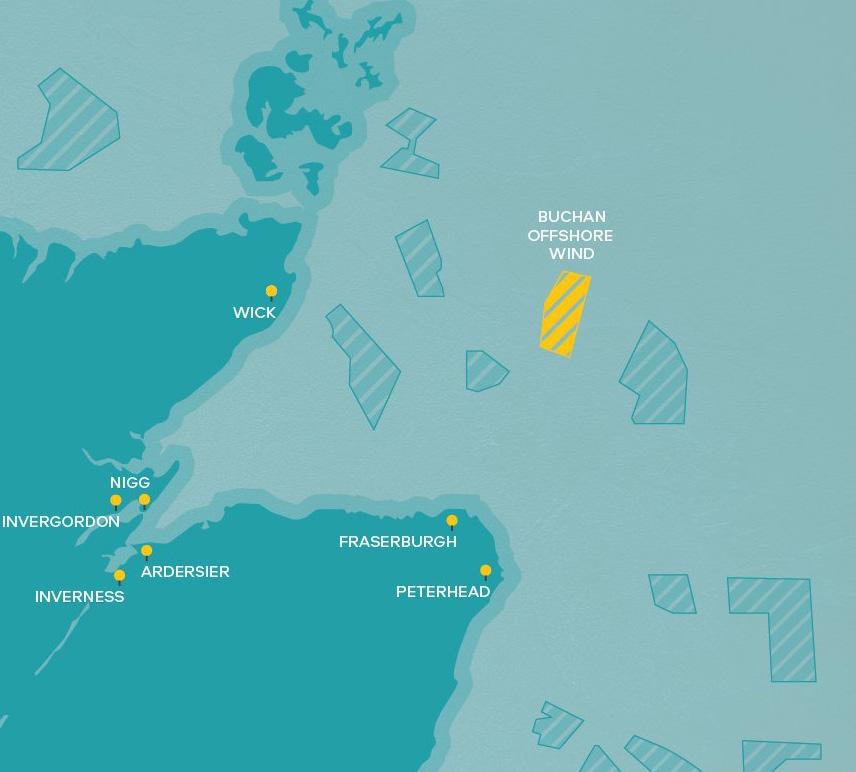
Floating wind works similarly to fixed wind, but instead of towers atop transition pieces, on typical monopile foundations, the floating foundations are anchored to the seabed with mooring lines. Dynamic subsea and inter array cables connect into an offshore substation and from there the process is the same as the traditional with export cables taking power onshore to a substation for transfer to the national grid.
Currently, the team of developers is busy with stakeholder engagement, planning and environmental activity, and supply chain establishment after winning the rights to develop the project in January 2022.
Matthias Taft, CEO at BayWa r.e said: “We are delighted to join forces with Elicio and Ideol, and to jointly drive forward innovation in the Scottish offshore wind sector. Our commitment to growing in the Scottish onshore wind market is clear after our first decade of project realisation. We now look forward to moving into Scottish offshore waters in the next decade and creating further jobs and value for the local supply chain.”
The benefits of floating wind include ease of installation and reduced environmental impact as a result of no foundational drilling. The use of offshore vessels is also reduced with much of the construction work being
In July 2023, Buchan Offshore Wind announced new contract awards as progress continues quickly. Worth more than £1.5 million, the recent wards bring the number of advisory contracts dealt to date to more than £20 million. Three contracts were dished out to Copper Consultancy, Natural Power, and Blackhall & Powis – responsible for property support including land rights. Each supplier was chosen because of unique understanding of the Scottish landscape and renewable industry. Blackhall & Powis has already provided support with fishery liaison and land assembly.
“The Buchan Offshore Wind project team continues to engage with National Grid’s Holistic Network Design process and are committed to rapidly progressing both onshore and offshore elements of the project,” said Alasdair MacLeod. “All three companies bring significant experience and capability to the project team, and we look forward to working with them all as we take the project through to the next stage of development.”
Previously, the company awarded a contract to Ocean Infinity to carry out geophysical and geotechnical site investigations. This was a vital step in securing the site and offering evidence of its aptness for floating wind infrastructure.
“Acquiring seabed data represents an essential part within the project
forward to engaging with our local stakeholders throughout the survey campaign,” said MacLeod.
Investing in local talent and skills, the Buchan team has supported the UHI STEM outreach programme to encourage local students to take up science, technology, engineering, and maths subjects. Investment from Buchan helps to get outreach coordinators into schools and in touch with young people to explain the route into the offshore wind energy market as well as other key sectors.
“It is important to us to inspire the younger generation by providing them with real life examples of how STEM skills can be used to have a lasting impact,” said Supply Chain Manager, Adam Hollis. “Our Buchan Offshore Wind project specifically
Scotland in general will require a skilled workforce to deliver projects in line with our journey towards Net Zero.”

Previously, Buchan Offshore had also joined the PowerHouse, a dedicated skills and innovation accelerator of the Inverness and Cromarty Firth Green Freeport (ICF). The organisation will deliver training modules and seminars to ensure skills required for floating offshore are developed accordingly.
“In order to deliver one of the largest floating offshore wind farms in the world, we will require a strong talent pool in the area,” said Hollis, who sits on the PowerHouse board. “We are therefore delighted to support organisations such as the PowerHouse that encourage young individuals within the Highlands and Islands region to join the renewable
professional development schemes.”
When complete, the project will be able to power 800,000 households with green energy. With Scotland looking to aggressively ramp up its offshore wind capacity and cement its position as a global leader, projects like Buchan Offshore are essential in future strategy.
“At Buchan Offshore Wind, we are passionate about harnessing our combined experience to develop and deliver one of the world’s largest floating offshore wind farms off the northeast coast of Scotland,” said MacLeod, as the last remaining hurdle of consent submission in 2025 draws closer.

PRODUCTION: Eleanor Sarbutt-King
Thor will be the capable of powering one million Danish households when it is fully operational in 2027. The offshore site is suitable and secured. The onshore substation work has started, and a local supply chain is in place. Developer RWE is doing a lot to materialise its ambition of climate neutrality by 2040.

In 2027, the hammer will beat again on the fossil fuel industry. Renewable power is the new rhythm, and the turning of blades on wind turbines will be the tune. In Denmark, where renewable energy is being drummed into the system, the industrial sound of coal, gas, and oil is quieting down and the boom of Thor – an offshore windfarm, 20km from the town of Thorsminde – is amplifying.

Conductors of the new composition are RWE. Headquartered in Essen, Germany, the company has a global footprint and employs around 19,000 people, all tasked with enhancing the volume for renewables as the company phases out coal by 2030 and hits net zero by 2040.
Part of the score is 50GW of planned green generation by 2030, to the tune of €50 billion investment. Clearly, RWE has ambitions beyond the simple, and is challenging itself to do more.
In the North Sea, Thor will become
home to 72 Siemens Gamesa 14-236 DD next-gen turbines, capable of producing 1000MW – enough clean, green energy for one million Danish households. Wind and solar are growing in importance in Demark, and RWE hopes that through Thor it will be able to assist in the transition in a major way.
As the largest offshore wind farm in Denmark, Thor turbines will eventually sit ion water depth of around 27m and each turbine will create 15MW with its 236m diameter rotor. Blades will be 115m long, and utilise IntegralBlade® technology which allows for 30% better efficiency compared to previous models.
In January 2023, RWE announced the partnership with Siemens Gamesa and confirmed that installation would happen from a base at the Port of Esbjerg. Both Siemens Gamesa and RWE have committed upskilling in the local area and 60 permanent jobs will be created at the Port of Thorsminde, supporting the wind farm for 30 years.
“With Thor,” said RWE Offshore Wind CEO, Sven Utermöhlen, “we will massively contribute towards Denmark’s ambitious climate targets. In order to deploy this offshore project, we will rely on our track record of more than 20 years in offshore wind and on experienced suppliers. Based on an extensive procurement process we selected the preferred suppliers and booked the necessary production slots for all main components. This is an important step towards implementing this large-scale project – especially against the backdrop of the current market situation.”
Viewing Denmark as an important country in the clean energy transition, Siemens Gamesa was delighted to be selected as part of the supply chain.
“We’re thrilled to collaborate once more with RWE, and feel particularly encouraged by the signing of the Preferred Supplier Agreement for the Thor project,” said Marc Becker, CEO Siemens Gamesa Offshore. “Our
partnership already encompasses 12 offshore wind projects in both operation and development, totalling over 5.1GW of capacity in several countries. Connecting in Denmark today is a testament to our commitment to the country, and to the benefits we all gain from the Østerild test centre. Governmental support in all aspects of the wind industry – from projects to support schemes to research and development centres like this one – is critical for our future success.”

As seen in various markets around the world, the local impact from large construction projects offshore is immense. Skills are built and lasting legacies are left through the value chain. In Denmark, where there is much room for expansion – especially in offshore wind – RWE has drilled down on local procurement. To date, many contracts have been awarded to local companies for product, services, and consultancy.

International expertise has been sourced where necessary and EEW
SPC will manufacture 36 monopile foundations, Wood Thilsted designed the foundations and Jan De Nul will provide the vessel for installation work, expected next year. Fred. Olsen Windcarrier will provide the vessel for the turbine installation and Hellenic Cables will provide the cable package. Alongside Jan De Nul, 60km of export cables and 200km of inter-array cables will be placed.
MT Højgaard Danmark will carry out construction and civil engineering work for onshore substation alongside Siemens Energy. HSM Offshore Energy is the EPCIC for the substation and will complete in 2026. Partnering with the best has allowed RWE to innovate like never before, making Thor a jewel in the crown of the country’s renewable energy capacity. And its construction
will also allow for new methods, not seen elsewhere. The towers will be made from green steel that uses 63% less CO2 than traditional thanks to the use of green electricity in the furnaces at the steel mills.
“Offshore wind already has one of the lowest life-cycle carbon footprints of power generation technologies,” explains Utermöhlen. “However, tower production accounts for around one third of all wind turbine-related CO2 emissions. So, using greener steel is a significant step towards producing even more sustainable wind power. At RWE we are fully committed to working towards circularity and net-zero emissions. We are already testing the world’s first recyclable wind turbine blades by Siemens Gamesa under real-life conditions. By piloting the GreenerTower at our Thor offshore wind farm, RWE is now once again taking the lead by helping to significantly reduce the carbon footprint of wind turbines.”
RWE has wind farms in the UK, USA, Germany and elsewhere, and solar parks in Canada and Australia, and calls on 125 years of history in power generation to engineer ideas that will help achieve climate neutrality by 2040.
In June 2023, the company announced that it would use world-first recyclable rotor blades from Siemens Gamesa on the Thor offshore wind farm. 40 of the 72 turbines will be equipped with the new blades that are fully recyclable thanks to a new resin with a new, special chemical structure allowing materials to be separated easier. Materials can remain whole and be utilised for fresh applications following wind farm decommissioning.
“At RWE we are fully committed to working towards circularity and net-zero emissions. We are already testing the world’s first recyclable wind turbine blades under real-life conditions at our German offshore wind farm Kaskasi and we have decided to
install them at Sofia. By using these rotor blades at our Thor offshore wind farm, too, RWE continues lead the way towards a circular offshore sector,” said Utermöhlen. “And we are doing even more. We are the first developer in the world to pilot Siemens Gamesa’s CO2-reduced steel towers, which significantly reduce the carbon footprint of wind turbines. This is the right direction for the future of our sector, which has sustainability at its core.”
With more than one million tonnes of turbine expected to be installed each year, this development gives a lot of steel a second life, saving it from rust, decay, and waste.
Onshore, away from the waves and winds, work on the impressive onshore substation - Volder Søndervang - is underway following a groundbreaking ceremony in May. In the Municipality of Lemvig, amongst a number of high-profile dignitaries, the sod was turned as excitement

around Thor was ramped up further.
“We already work closely with the local community, politicians, fishermen and educational institutions,” said Pia Lanken, CEO of RWE Renewables Denmark. “It is crucial that we are in dialogue with these stakeholders because we want to contribute to local development. This is one of the
reasons why we have committed to employing at least 30 vocational trainees for this major project.”
The onshore substation will connect to the Energinet grid and green power will flow across the region, mitigating carbon and advancing Denmark’s goals.
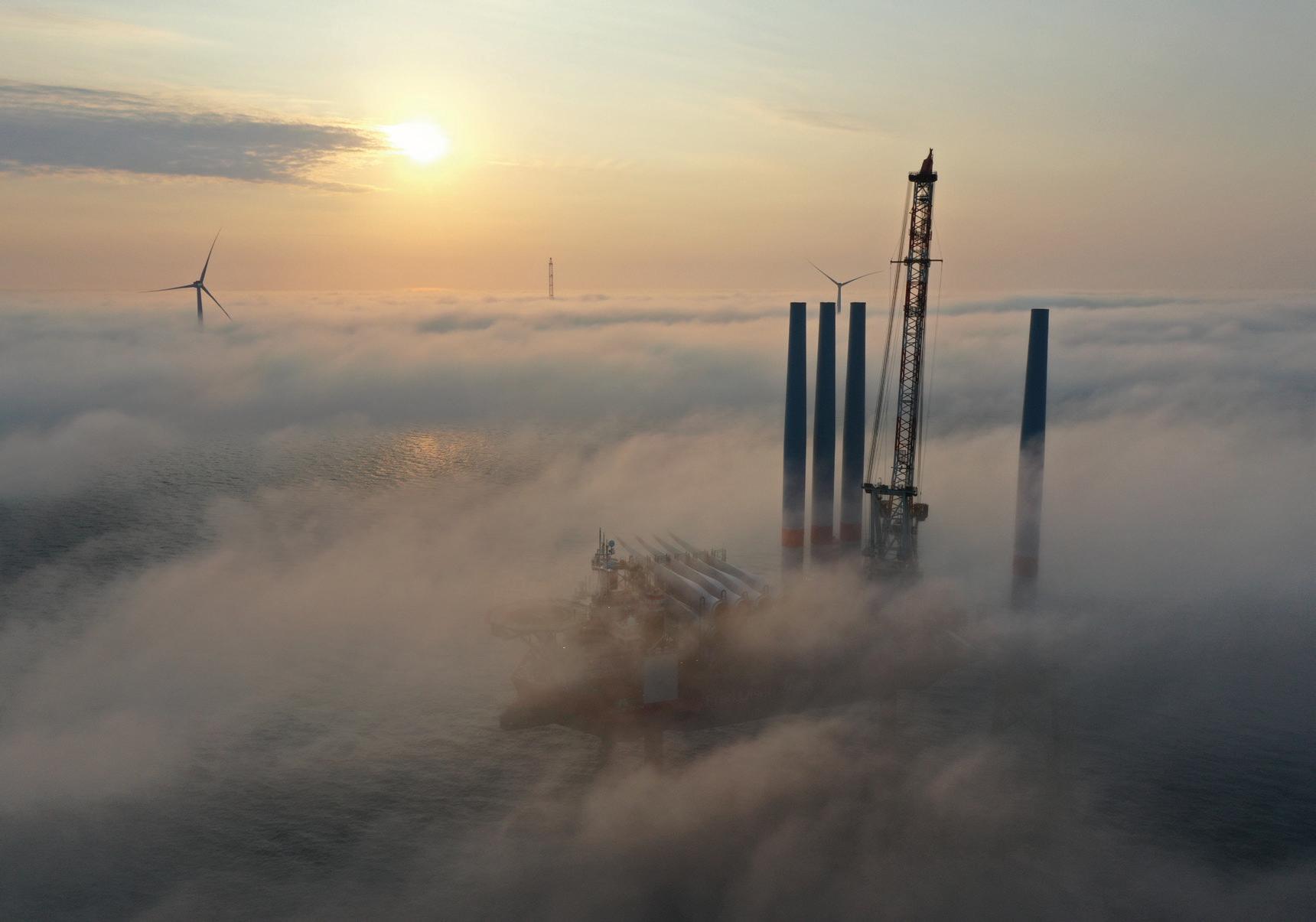
Erik Flyvholm, Mayor of Lemvig said: “This is perhaps one of the most important groundbreaking ceremonies in Lemvig in recent times. It is the beginning of a massive wind project and the beginning of an energy adventure in Northwestern Jutland to the benefit of the climate, the region, and the municipality. I wish for a fruitful partnership with RWE that will benefit both parties.”
RWE focuses on creating energy for a sustainable life. The strategy is ‘growing green’ by investing carefully
but heavily in opportunity-filled projects around the world. And, from 2027, when Thor is fully operational, all the notes in the soundtrack will crack to the beat of a renewable orchestra.
“In order to deploy this offshore project, we will rely on our track record of more than 20 years in offshore wind and on experienced suppliers, like Siemens Gamesa, which are committed to working hand in hand with Danish supply chain companies and the local workforce. As RWE, we want to be one of the key drivers of offshore wind energy in Denmark,” concludes Utermöhlen.
// IT IS CRUCIAL THAT WE ARE IN DIALOGUE WITH THESE STAKEHOLDERS BECAUSE WE WANT TO CONTRIBUTE TO LOCAL DEVELOPMENT //
PRODUCTION: Jamie Waters
Inchcape Shipping has been using its vast network and titanic knowledge of the world’s ports to help companies in the energy industry for decades. By upping its abilities in survey and inspection, and using knowledge to help drive efficiency in port turnaround, the company is trusted by some of the world’s most important organisations.
A Shipping agents are the often-forgotten glue of the energy trade. 80% of goods moved around the world go on ships across the oceans, and 36% of all global seaborne trade was energy products in 2021. Of all the coal produced around the world, 15% was moved by sea in 2021. 17% of natural gas
and 64% of oil was also loaded onto vessels and hauled across water.

Clearly, shipping, and shipping agencies, will play an important role in the energy transition. Simply, over the next few decades, the amount of oil and gas and coal transported by ship will reduce in order to meet the 1.5°C warming targets, but hydrogen,
biomass, and ammonia will increase dramatically. Agencies that have knowledge and experience to keep products moving safely, securely, and quickly will become the trusted partners of the energy companies.
Globally, there are a number of shipping agencies that can deliver quality service, but there are few that
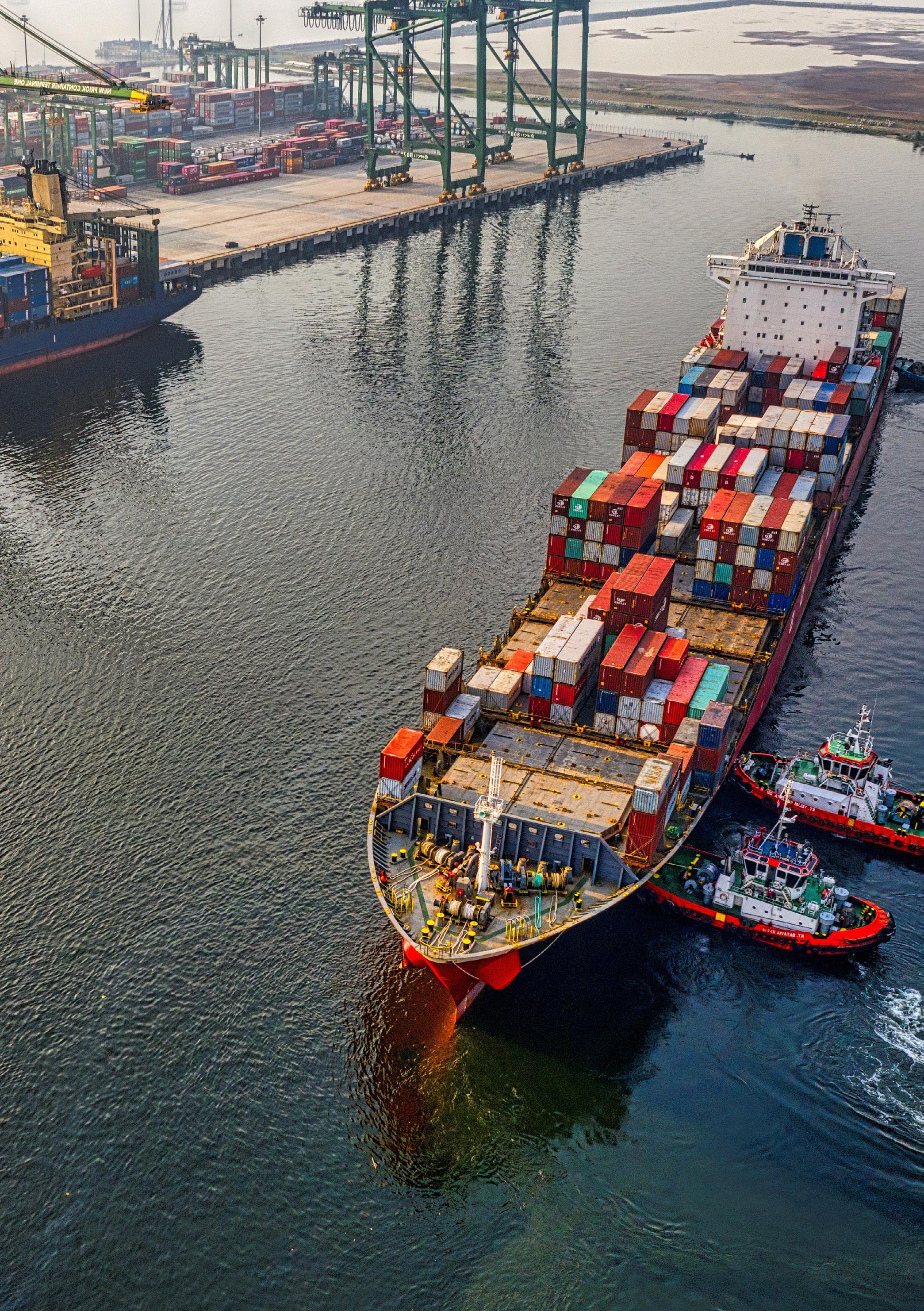
have multi-industry, multi-location, and multi-product know-how. Inchcape Shipping, headquartered in London but with international footprint, has a history stretching back more than 175 years and is a key agency for the energy industry.

Like most, the company has expanded into the renewable energy space and is providing services across its entire network to keep routes flowing. The company is the world’s largest dedicated maritime service provider to bulk chemical, gas, and oil shipping markets. “Our extensive experience in handling such a large array of liquid cargo means we are fully equipped to handle any job, no matter the size or scope, whilst our strict adherence to world-leading practices and compliance values provides a certified level of professionalism and care,” the company says.
In new energy, Inchcape’s enthusiasm is the same: “Whether you require assistance with sub-sea construction, wind farm development,
dredging or seismic marine surveys, you can access high quality agency and logistics with Inchcape.”
Typically, an agent would offer a range of services to ship owners. From travel arrangements, meet and greet, lodging, shore passes, cash to master, spares clearance and delivery, bunker supplies, berth arrangement, piloting and tugs, documentation (customs, harbour services, letter of invitation), ship provisions, medical assistance, repairs, goods handling, storage bunkering, repairs, handovers, freight, cargo collection and more; the shipping agent is vital.
In the energy space, turning around at the port is a complex and risky process. Large vessels enter ports in tight spaces, loaded with high value cargo and tired personnel. The turnaround process must be fast and fuss-free, and this is where Inchcape stands above others.
VP Survey and Inspection
at Inchcape, Chris Greenwood, explains that streamlining survey and inspection in port, using new technology, will streamline the process, improving turnaround times.
“Strategically, we are looking to maintain and develop our existing capabilities and global coverage, while anticipating and proactively addressing the emerging needs of the industry in a dynamic and evolving environment,” he says.
“This involves increasing the use of technology in our activities and having a forward-looking focus on supporting our customers’ safety, environmental and commercial needs. We will also be looking to expand partnerships where appropriate, as well as increase our engagement in the ESG space.”
The company has a presence across 2200 ports, with 245 offices in 60 countries, and survey teams are the best of the best, including master mariners,
Continues on page 100
The leading shipping agency in Libya, Navigator Shipping connects all key players in the energy industry and is the expert partner for all port operations in and out of the country.



Since 1961, when Libya started exporting oil, the country has remained a powerhouse energy nation, home to largest oil reserves on the African continent. Libya exports to Europe and other regions, adding natural gas to its exports in 1971. But moving product to and from the country has been a logistical challenge in recent years with a changing political landscape and multiple regulatory hurdles.
On the ground, the leading shipping agency is helping the world’s largest energy companies to import and export from Libya. Navigator Shipping Company, headed by Captain Tarek Shukri, has been the Libyan partner for international clientele since opening its hatches in 2011.
Shokri has held every position in the industry and has the connections across Libya and further to build a network of reliable and trustworthy partners.
“We are the face of Libya in the energy sector when it comes to loading and discharging shipments.
“Navigator Shipping Company is the number one agency working in oil and energy shipments in and out of Libya,” he says, adding that the company is the oldest agency in Libya since private companies entered the market.
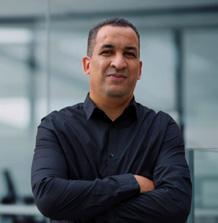
Around 70% of Libya’s export earnings come from oil and 60% of GDP is a result of the oil and gas sector. Navigator is active across the major ports (Tripoli, Benghazi, Marsa-El Brega, Misrata, and Al Khoms) as well as the smaller ports and harbours.
By providing transparency and working to international standards, Navigator has crafted a reputation for excellence. Shukri puts this down to the team and the local knowledge.
Capt. Tarek Shukri General Director“Our staff is highly experienced and available 24 hours a day. Our banking procedures are very easy and we have accounts for safe payments from Europe and the Middle East. We have multiple awards from clients and we have been working with the major oil companies. Navigator is ISO certified and follows all of the latest technology developments from around the world. We always keep our clients in the loop and inform them of all situations in Libya.”
The medium-term goal for Navigator is to be recognised as the industry leader in the energy sector across Libya. Longer-term, the company hopes to be the face of renewable energy as the country broadens its domestic generating mix. “We are a team that has been exposed to many different cultures and regions, and that has expanded our vision. We believe that Navigator can be the face of the renewable rollout here. The world will be changed with green energy and we are following that so that we can provide answers to questions that will come around this sector,” says Capt. Shukri.
As Libya and the energy space changes, Navigator will remain at the heart of all movement, and global energy businesses can be confident of world-class service and a powerful long-term partnership.
chief engineers, and naval architects. All elements of a vessel can be expected and often inspections are required for insurance and legal purposes. When adding this service to Inchcape’s portfolio, clients begin to release significant savings and efficiencies.
“We also have very stringent governance and compliance systems in place to ensure the work is executed correctly, and to the exacting standards Inchcape and our customers rightly expect,” Greenwood says.
“The power of Inchcape, whether it is S&I or any other business line, lies in its global network. Our survey teams are on hand when and wherever our clients need us. This is especially important in the maritime industry, which never sleeps and where delays can have a significant commercial impact on our clients,” Greenwood says.
Currently, inspections around fuel
are becoming increasingly important. IMO MARPOL compliance and adhering to sulphur cap regulations make mandatory inspections more important than ever, but there are basic maintenance functions that can be completed to ensure improved efficiency. Cleaning of the hull and regular underwater surveys can improve fuel efficiency and bunker quantity surveys can guarantee the correct volume of fuel delivered.
“Asset integrity and maintenance is also a huge part of a shipowner’s capex and so it is vital to ensure the appropriate level of oversight is provided to avoid charter party claims, off-hires, and expensive and unplanned dry-docking costs,” says Greenwood.

Robbie Mclellan, Head of Global Marine Supply Chain, is also certain that speedy port turnaround is something that should top the priority list for ship owners.
“Ship owners and managers are facing logistical challenges with rising
costs of procurement and delivery, supply bottlenecks, a lack of capacity to handle increased workload, and a lack of visibility and transparency that have affected port turnaround times.
“We are able to streamline that process by providing a single point of contact for the vessel operators and having a single digital channel of communication through our global offices, which means we can control the cost factor,” he says.
“Cost-efficient port turnarounds are critically dependent on local expertise and voyage intelligence, together with effective communication and vendor collaboration, to avoid unnecessary costs and keep the wheels of supply chain logistics running smoothly,” he adds.
Inchcape has not only the history and expertise, but the network around the world which makes for constant updating of best-in-class practice easier than for others who only operate locally or regionally.
A champion of efficiency across the board, Inchcape Shipping has been taking its laser-focus on best-practice from energy into the cruise sector. Based on high-traffic and high-volume, the industry is littered with inefficiency and it is not uncommon to see cruise ships queued to access ports, wasting energy and fuels. However, Inchcape is redrawing the maps, opening up new destinations, and helping cruise companies to become more efficient.
Global Vice President Cruise Solutions, Grant Holmes says: “We are now engaged in widespread consultations in different parts
// THE POWER OF INCHCAPE, WHETHER IT IS S&I OR ANY OTHER BUSINESS LINE, LIES IN ITS GLOBAL NETWORK //
of the world to develop plans for sustainable ship and passenger capacity for each destination.”
He is particularly keen on opening up markets in Africa and the Middle East where a rebound in the postpandemic world is required. As part of its port agency offering, the company provides husbandry services for cruise ships, tapping into advantageous pricing for supplies with its extensive local networks of approved vendors, along with 24/7 crew logistics, ground handling, bunkering, and surveying.
Marquee destinations in Abu Dhabi, Dubai, and Doha are becoming more attractive and the company is helping to relieve pressure on the ports with effective management.
“Nowhere else in the world is expanding so rapidly,” Holmes says.
“This means that we calculate what should be the limit for the number of ships and passengers calling at a port on any given day to ensure it remains sustainable. In this way, everybody wins: guests have a better
experience, there is less pressure on local resources and tourist attractions, and emissions in port are reduced significantly. The use of electric vehicles also enhances the sustainability of shore excursions,” he adds.
From a fuel perspective, the cruise industry has the potential to make quick changes to become more sustainable. But there is a shortage of LNG bunkering facilities at many cruise ports which will limit the extralarge LNG powered ships. Hybrid ships, or those running on biofuels, will be caught up in congestion as the large vessels wait for capacity around LNG loading. This proves the need to effective management across routes and highlights the need for effective ship agency services.
Highlighting the Inchcape ability to deliver at the top end of the spectrum, the company was trusted by another of the world’s major energy businesses recently when it claimed an agreement with Equinor to handle port agency requirements. From
June 1, Inchcape began the contract and is busy delivering excellence.
“Equinor has a diverse portfolio of projects, including oil and gas, renewables, and low-carbon solutions, with a goal to become a net-zero energy company by 2050. We are honoured to work with such an esteemed company,” said VP Commercial EMEA, Hege Solstad. “We also want to thank the Equinor team for selecting us and for the smooth onboarding process.”
With the changes underway in the energy industry, and the obvious changes that will need to come in shipping to cope with the energy infrastructure of the future, the shipping agencies have a big role to play. Inchcape is happy to bring its range of services wherever required, even as the often-unseen linchpin.
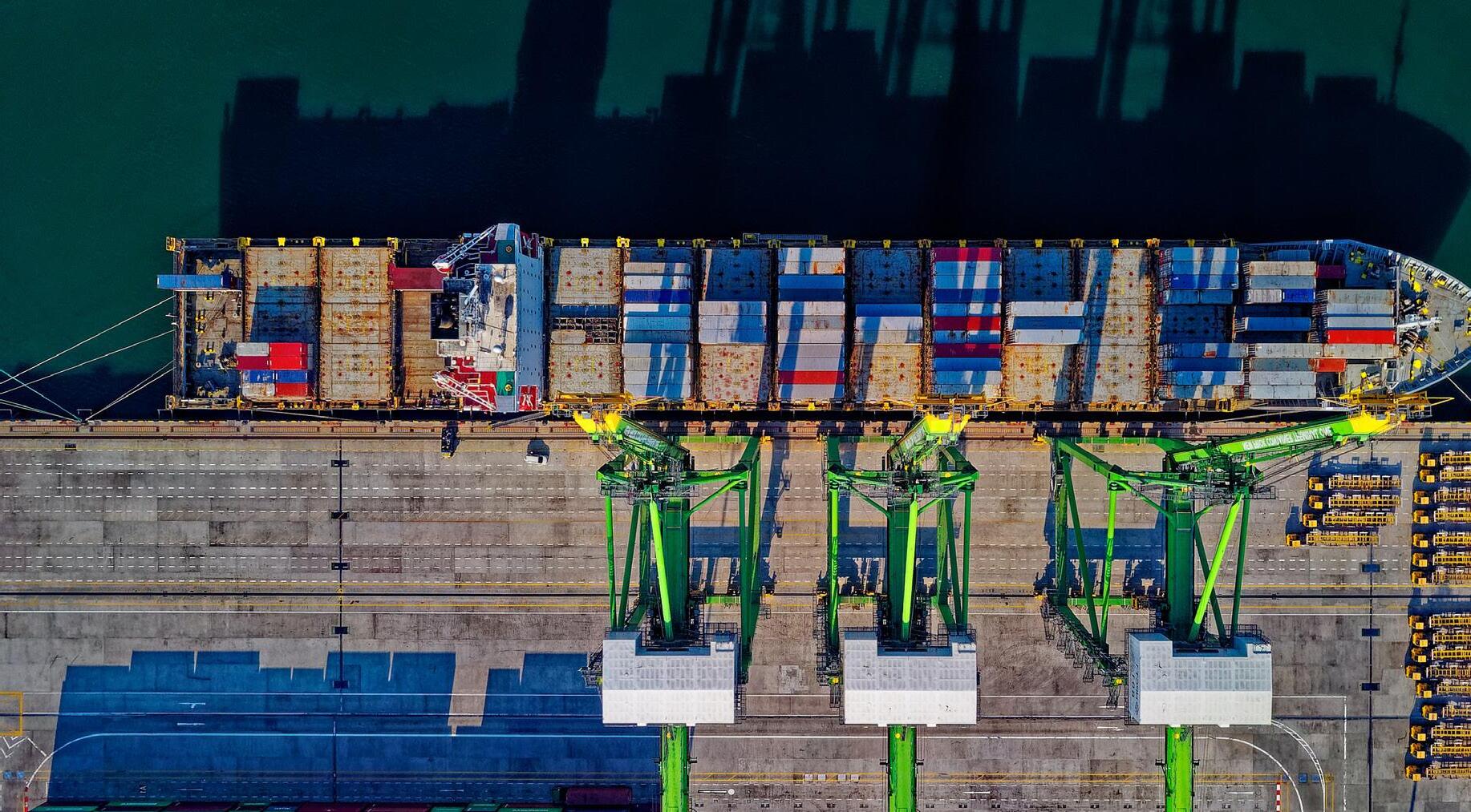

PRODUCTION: Isabel Murphy
With a number of exciting builds underway, and a range of units in action around the world, SBM Offshore continues to secure its position as a leader in the global FPSO market. Focussing on efficiency with its Fast4ward® concept, especially for Brazil and Guyana, is yielding strong results.

A The ocean was, is, and always will be world’s greatest ally in the battle against climate change. Producing 50% of the oxygen we need, absorbing 25% of the CO2 emissions we produce, and capturing 90% of the excess heat that come from these emissions, the oceans are the great balancers of the global ecosystem. But they also generate energy – wind, water, and tide have the power to fuel nations and lift communities out of poverty. They provide economic opportunity, and are key sources of food, entertainment, tourism, and mindfulness – Heraclitean Motion is peaceful and calming.
To harness the immense potential of the blue, expert knowledge is required. To navigate the waves and provide infrastructure that can help us access the world’s natural resources, experience and expertise is essential.
One of the world’s leaders in ocean work is SBM Offshore. The Dutch ocean
goer has made clear its intentions to work on and with the seas to assist in the energy transition. “Supporting this increase in demand while supporting the energy transition is the major twofold challenge of this century. One that SBM Offshore is committed to meeting,” the company says.

“From today’s oil and gas to tomorrow’s wind and wave, SBM Offshore is the deep-water specialist. Our vision is to use our knowledge and experience to unlock the vast energy resource potential of our oceans and seas, in all its forms.”
For decades SBM has been learning how to work on the sea. Starting out with skills from general marine engineering and entering the mooring system industry for buoys, the technology was then developed for use on drill ships and eventually utilised on barges. By the 1980s, the company was a group of
business with expertise across rigs and other offshore structures, servicing the booming oil and gas industries. By the end of 1990s, SBM had cemented its position as an industry leader, calling some of the world’s majors its key clients. Floating Production, Storage and Offloading (FPSO) vessels became the company’s key area of focus because of the unmatched ability to service challenging deepwater oil fields in remote locations. Engineering the complex infrastructure that sees oil and gas onboarded and stored safely, and then pumped out to a transport vessel is one of the most challenging concepts in the sector, but SBM has all the learnings required, and proof of its ability.
Today, the company is a leader in the industry and produces more oil (boepd) than any others with 15 FPSOs and one semi-submersible unit active around the world. SBM designs,
Continues on page 106
Enjoy complete logistics solutions tailored to your project
Blue Water Shipping provides reliable transport and logistics solutions specifically to this fast-paced industry. With our proven track-record, our clients can be assured of excellent customer service from our dedicated subject matter experts.
We offer full carbon accounting and end-to-end visibility on the logistics of your project, providing you with complete transparency all the way. Choose Blue Water for a reliable partner.

Continued from page 104
supplies, installs, operates, and extends the life of FPSOs, focussing on new builds and large conversion projects. Current focus for the oil market is Brazil and Guyana, but SBM is also diversifying and looking to operate more in the renewable energy industry.
In 2016, SBM heard the call of the industry and began development of the Fast4ward® concept – an idea that standardised FPSO design for smooth and understandable manufacture. Based on Group Technical Standards from 2003, the idea came about to help clients through a lower CAPEX
requirement and a shorter cycle from yard to energy production. The supply chain becomes integrated, digitisation is encouraged, execution becomes flawless, and clients receive major benefits. To date, the Fast4ward® model has been a major success allowing production from 300 – 3000 meters, with a 30-year design life, increased deck space, and up to 2.3 million barrels of storage capacity.
Particularly relevant in Guyana, where SBM Offshore works closely with ExxonMobil, the Fast4ward® concept is being rolled out with a lot of success. Guyana’s Stabroek, Canje and Kaieteur Blocks are significant for ExxonMobil but sit in waters hundreds of kilometres off the coast of Guyana, in depths of more than 2000m – it’s challenging but rewarding.

In April 2023, SBM Offshore’s FPSO Prosperity arrived at the Stabroek block in Guyana, travelling 20,000km

from Singapore in just under 50 days. “On track for first oil later this year, Prosperity becomes Guyana’s third FPSO joining Liza Destiny and Liza Unity,” the company said.
Following a naming ceremony that took place in February at the Keppel Shipyard, the Prosperity FPSO is the second Fast4Ward® design and
will production 250,000 barrels per day while moored in water depth of 1900m. “As SBM Offshore’s CEO, I am proud to share in the Prosperity FPSO naming ceremony with you – to celebrate this day which we’ve worked towards relentlessly, together,” said SBM CEO, Bruno Chabas. “On behalf of SBM Offshore, we are extremely honoured to play a part in the shared journey of the nation of Guyana, partnering alongside our client ExxonMobil Guyana. Prosperity FPSO is also privileged to call the First Lady of the Co-operative Republic of Guyana, Her Excellency Mrs Arya Ali, her Godmother.”
May 2023 saw the company sign a 10-year Operations and Maintenance Enabling Agreement in Guyana with ExxonMobil. The company will operate and maintain the Liza Destiny, Liza Unity, Prosperity and ONE
GUYANA FPSOs and will deploy digital tools across the fleet to ensure maximum efficiency.
“We are very pleased with the contract concluded with ExxonMobil Guyana leveraging both companies’ recognised operating excellence,” said Chabas. “This contract capitalises on our developments in Guyana to date, positioning the company for long-term operations in the country. The Integrated Operation Model is the first of its kind in the industry and extends our relationship with ExxonMobil Guyana by integrating further our teams. We believe it is the optimal solution to achieve excellence in the operation of Guyanese assets bringing value to all stakeholders and setting a new performance benchmark for the industry.”
In March, ONE GUYANA entered the drydock at the Keppel yard in
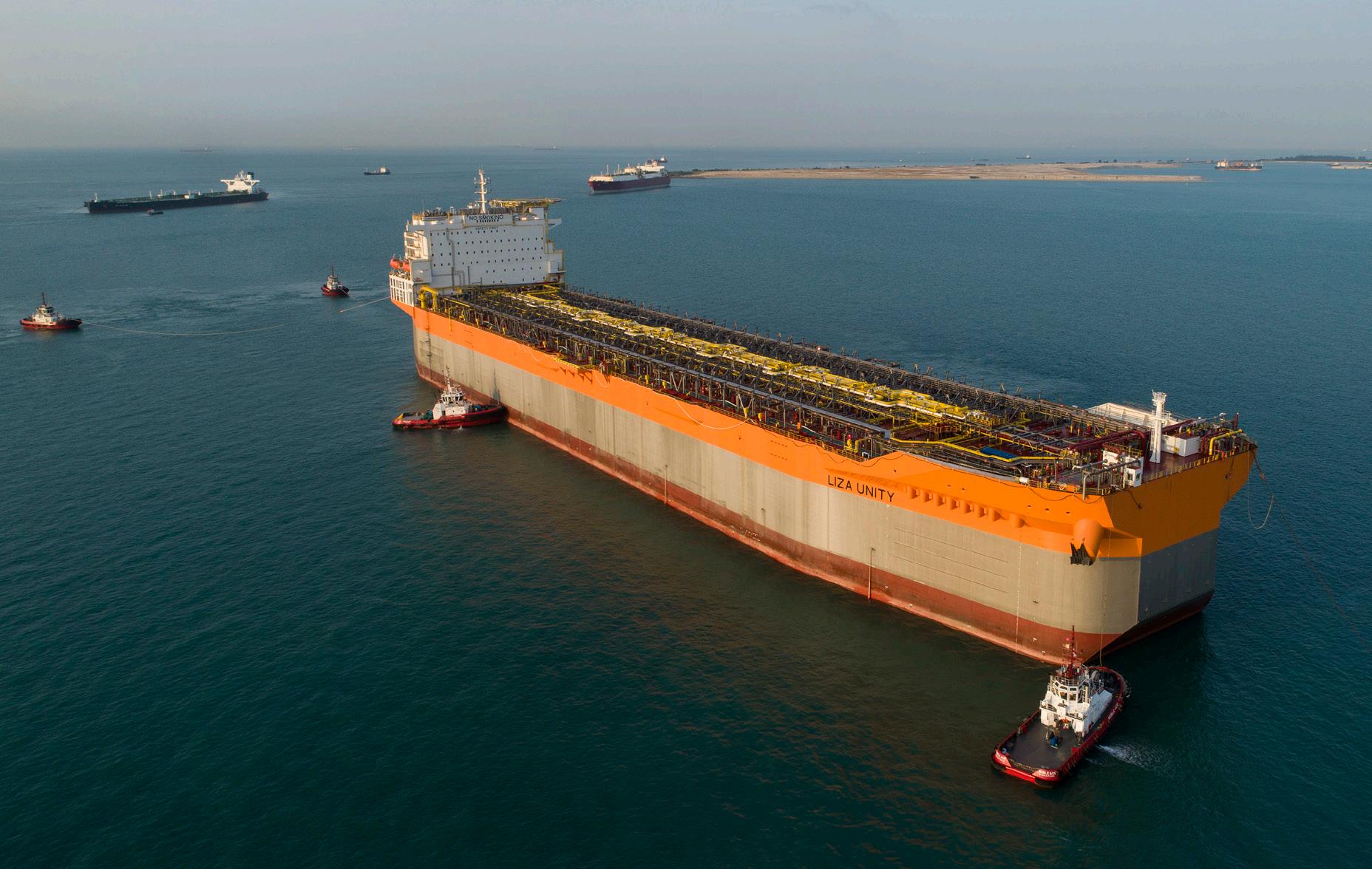
// THIS CONTRACT CAPITALISES ON OUR DEVELOPMENTS IN GUYANA TO DATE, POSITIONING THE COMPANY FOR LONGTERM OPERATIONS IN THE COUNTRY //© SBM Offshore
Singapore where teams are busy completing the mooring structures and riser balconies. Soon, ONE GUYANA will head for the seas and will bring its two million capacity storage, 250,000 barrels per day, and a gas treatment capacity of 450 million ft3 per day to operation on the Stabroek block.
In June 2023, the company construction of its third Fast4Ward® FPSO when topside and commissioning was completed at the BOMESC shipyard in China. Named the Sepetiba, this unit headed straight for Brazil. “The FPSO has commenced its transit to the Mero field in the Santos Basin offshore Brazil, located 180km offshore Rio de Janeiro. SBM Offshore has a contract with Petróleo Brasileiro S.A. (Petrobras) for the 22.5 years lease

and operation of FPSO Sepetiba. First oil is expected in the second half of 2023,” the company said. Sepetiba can produce 180,000 barrels per day and store 1.4 million – an example of SBM delivering value for clients where they need it most.
In the renewables space, SBM recently teamed up with DP Energy to create a JV that will explore floating offshore wind opportunities in Nova Scotia, Canada. Together, the pair will begin to create the foundations for a local, floating offshore space, using their combined experience to ensure the best possible outcomes.
“We are very pleased to announce the formalisation of our partnership
with DP Energy, a well-recognised developer in the renewable energy space,” said SBM Offshore Managing Director New Energies and Services, Severine Baudic. “We believe that Canada’s offshore wind resource is amongst the best in the world. As an offshore energy transition company with proven experience in Nova Scotia, we are excited to expand our partnerships with the local community and write a new chapter, together.”
Nova Scotia aims to bring 5GW of offshore wind power online by 2030, with the country looking for diversification in its renewable energy mix. Currently wind, mainly onshore, contributes around 7.7% of total national capacity.
SBM has already developed
innovative floating offshore structures that can economically produce power. Light, modular, easy to install, the SBM solution has low motions and accelerations at nacelle level, and requires no
construction or port infrastructure.

As new technologies are rolled out, the company is looking forward with ambition. Coming off a strong base, SBM’s half year earnings for the first half of 2023 saw the company boast a US$3.2 billion pro-forma order book and US%9.5 billion pro-forma net cash flow.
“The increase in our order book to a new record level and reiteration of the 2023 guidance underline the fact that our strategy as an Energy Transition Company is delivering results.
We are on track to achieve first oil as planned this year on two major FPSO projects. FPSO Prosperity is already in Guyanese waters and FPSO Sepetiba has started her journey to Brazil from China. While we continue to live with the after-effects of the pandemic plus supply chain and inflationary constraints, we are progressing the
remaining projects under construction and the overall margin remains robust at portfolio level,” said Chabas.
The responsible use of the oceans to help create the energy that we so rely on is where SBM clearly thrives. The systems it creates, combined with the focus its places on environmental wellbeing, are helping to achieve a just energy transition, preparing the company for the markets of tomorrow while securing the supplies of today. For Chabas, this is peaceful and calming, like the enduring waves of the ocean.
// WE ARE VERY PLEASED TO ANNOUNCE THE FORMALISATION OF OUR PARTNERSHIP WITH DP ENERGY, A WELL-RECOGNISED DEVELOPER IN THE RENEWABLE ENERGY SPACE //© SBM Offshore
As one of the world’s most important energy businesses, bp wealds major impact when it comes to developing new technologies and ideas to positively impact the way we live, nurturing our world while advancing society. A quickly changing business, bp is investing in the energy of tomorrow while reducing its emissions to hit net-zero by 2050.

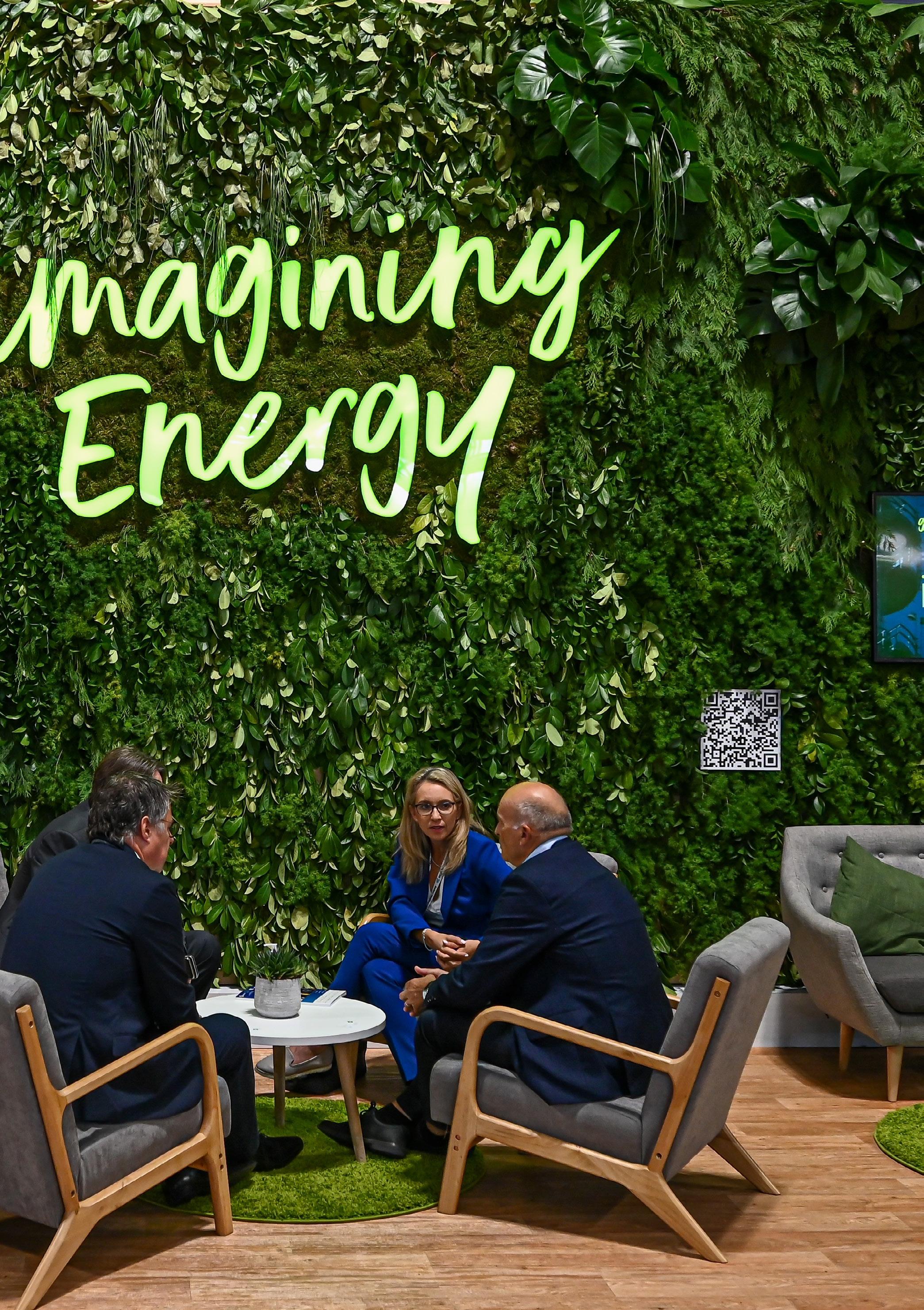
//Energy must be secure, affordable, and low-carbon in nature. Achieving these goals is the ‘energy trilemma’ that bp seeks to address. One of the most recognisable names in the energy industry, bp is a major with a mission. The company has set out its vision for net-zero by 2050 – inline with others in the market. But bp hopes to do things better and faster. In 2020, the company adopted a clear strategy for transition, but that has been hastened with an added $8 billion committed to bioenergy, convenience, EV charging, hydrogen and renewables, and power, with added focus on sustainable aviation fuels.
While decarbonising for the sake of the environment, bp is also confident that the process can yield financial returns, presenting a longterm opportunity for value creation.
“Renewable energy is the world’s fastest growing energy source and essential to getting the world to net
zero,” the company shares. “Rapidly growing our renewables business is core to our strategy: by 2030, we aim to have developed around 50GW of net renewable generating capacity globally, up from 3.3GW in 2021.”
Three established and proven areas of low carbon, low emission, high energy delivery are wind, solar, and hydrogen. It is these three categories in which major energy companies will win the race for lasting, positive climate change. Here, bp is already leading the way and looking to advance its position exponentially.

In Scotland, bp and partner EnBW successfully gained a lease option to develop a major offshore wind farm at the start of last year. The company announced that Aberdeen would become its global centre of excellence for offshore wind, and its new project could potentially power three million
households. The project, known as Morven – after a mountain in the Aberdeenshire hills – will sit in depths of 65-75m and will generate 2.9GW.
BP CEO Bernard Looney and EnBW CEO Frank Mastiaux were both particularly excited about the prospect of generating clean energy in Scottish waters, utilising industry knowledge developed in oil and gas to meet the needs of the future.
“bp has a proud 100-year history in Scotland,” said Looney. “We want to thank Crown Estate Scotland for the opportunity to now start a new chapter, helping Scotland continue as a global energy leader for the next 100 years. We have a fantastic partner in EnBW and now an even more competitive portfolio of nearly 6GW of combined offshore wind to develop together.”
Mastiaux added: “Since the construction of the first German offshore wind farm in 2010 by EnBW, we have become a major player in offshore
technology, even beyond Germany’s borders. We are therefore very pleased to be able to contribute our experience of developing and operating technically demanding offshore wind projects once again with our partner bp.”
In Germany, the company won a 4GW offshore auction to bring about change for the better in its onshore operations. Renewable energy will power green hydrogen and biofuels production, electric mobility growth and refinery decarbonisation. Two projects, fixed-bottom in nature, will be connected by the end of 2030 and will sit 130km and 150km off the coast.
“These awards are a huge milestone for bp’s decarbonisation plans in Germany and are a strong reflection of our wider strategy,” said executive vice president, gas and & low carbon energy, Anja-Isabel Dotzenrath. “The renewable power we aim to produce will anchor the significant demand we expect for green electrons for our German operations, from a whole host of products and services including green hydrogen and biofuels production, electric mobility growth and refinery decarbonisation.
“Germany is a core market for bp,” she reminded, “and we are excited to continue and grow our business here. The investment is fully aligned with our integrated energy strategy and is accommodated within our disciplined capital frame. Expected returns of 6-8% are consistent with our renewables and power growth engine on an unlevered basis, with the potential to realise enhanced value through integration across the Germany value chain.”
Currently, bp employs around 4000 people in Germany and looks after around 2300 retail sites through the Aral brand. The company also boasts 1500 fast EV charging points and recently expanded its Hamburg office to underpin efforts int eh renewable space.

“We are investing massively in Germany’s energy transition and in our own – from renewable power
generation to having an impact on the decarbonization of road transport to the decarbonisation of our refineries,” said CEO of BP Europa, Patrick Wendeler. “Our major existing businesses here are transforming – powered by green hydrogen, biofuels and offshore wind. And today’s win accelerates the pace of change as we look to do more. We look forward to the important role we can play in contributing to Germany’s energy transition and its efforts to become climate neutral in 2045.”
Similar to the other majors, bp is waiting for government policy to back up the hydrogen rollout. Already confident in the ability of the element as a fuel, and far down the road in terms of testing viability for heavy-duty transport
and industrial application, bp is busy ramping up its hydrogen presence. Germany and Scotland are again focus regions for bp’s ambitious rollout. In January, the company announced it would investigate the possibility of installing an industrial-scale ammonia cracker at Wilhelmshaven where
THIS IS ANOTHER CRITICAL STEP IN DEVELOPING AND DELIVERING LOW CARBON HYDROGEN IN COMMUNITIES THROUGHOUT THE WORLD
Two decades ago, offshore wind was an early-stage conceptual technology that posed significant economic and technical challenges to the energy industry. Today, the opposite has been proven to be true. The market is globalising, scaling and the asset lifecycle is extending in more challenging and deeper waters.
Kent are at the forefront of the offshore wind revolution, has conquered the toughest challenges and made offshore wind a viable renewable energy source. Kent’s UK Offshore Wind Market Director, Cerianne Cummings, commented “We have delivered 70% of the UK’s offshore wind farms and assisted governments with crafting their long-term wind strategies. We delivered the first certified project using the PISA geotechnical design that produced much lighter monopiles than industry standard on Triton Knoll, and even deeper WTG jackets on projects such as Beatrice. Our team also designed the first floating projects.”
“Our knowledge and experience in fixed and floating wind is unrivalled, taking projects from fuzzy concepts to flowing electrons. We continually strive to push the boundaries of water depth, seabed type, standardisation, optimisation and asset management” said Cerianne.
Kent’s offshore wind team supports the full project life chain. From early-stage master planning and lease bidding, through FEED and detailed design, to integrating delivery and supply chain models and finally into commissioning, startup and advises into the operational, maintenance and life extension phase.
Kent employs the most technically skilled experts in structural, mechanical, electrical and instrumentation, naval architecture, marine, geotechnical, safety, reliability and environmental engineering.
And when it comes to technology, their teams are developing the tools that make offshore wind development easier. Cerianne highlighted
“Our Multi-Objective Design Optimisation Tool (MODOT) uses advanced optimisation algorithms to produce design optimisations in days rather than months, adding value from the start and saving clients 1,000’s of tonnes of steel across a wind farm using efficient designs.
Our Virtual Windfarm Tool (VWFT) gives our clients balanced and best solutions when assessing what a potential windfarm site is worth. It allows visibility of conflicting design priorities and manages expert input across disciplines.”
repurposed oil and gas infrastructure could be used to transport hydrogen for industrial use. With ammonia coming from bp sites around the world, the cracker at Wilhelmshaven would split hydrogen from nitrogen, with the hydrogen used for customers in the Ruhr region. The deepwater harbour at Nord-West Oelleitung (NWO) terminal at Wilhelmshaven is perfect to support hydrogen activity.
“The development of this import facility complements bp’s global hydrogen project portfolio, as we develop a presence in a number of potential hydrogen and ammonia export locations in the Middle East, Africa and Australia, which
could supply part of the European demand in the coming years. This is another critical step in developing and delivering low carbon hydrogen in communities throughout the world,” said Felipe Arbelaez, senior vice president hydrogen and CCS.
Patrick Wendeler, said he was confident in bp’s ability to deliver hydrogen infrastructure: “At bp we have the expertise and capacity to cover the entire value chain of green hydrogen production, including conversion into derivates like ammonia, transport, and then reconversion to supply green hydrogen to the customers and places who need it. This development would help create greater
energy independence for our German customers across a range of low carbon energy products. Wilhelmshaven has a proud energy history, and we hope this hydrogen hub can help carve out its next chapter and help Germany meet its energy transition goals.”
In Aberdeen, the company has signed a JV agreement to develop a city hydrogen hub. Partnering with the local city council, a green hydrogen production, storage and distribution facility – powered by renewables – will be developed over three phases. The plan is to initially produce around 800 kg of green
Continues on page 116
Kent is working with bp and EnBW on their Mona & Morgan and Morven offshore wind projects in the UK

70% of UK’s offshore wind farms
32GW of projects delivered globally
3500+
WTG foundations designed and maintained
25+ offshore substations
30+ floating wind projects
the energy within

Continued from page 114
hydrogen for use in the transport sector. As the project scales up, more uses will be added. The hope is that, by 2030, 700 skilled jobs will be created.
“bp is investing across all the energy transition growth areas in the UK,” confirmed UK Head of Country and Senior Vice President for Europe, Louise Kingham CBE. “This announcement is evidence of that commitment in action and is supported by other ambitious plans to produce clean energy from UK offshore wind, develop carbon capture in
Teesside and grow the country’s electric vehicle charging network.

“With these new business opportunities underpinned by our long-standing position in North Sea oil and gas, we are showing what an integrated energy company can do. And all of this couldn’t be possible without the skills and experience of a talented workforce and supply chain, eager to help make the UK’s net zero ambitions a reality,” she added.
In 2022, bp signed a Strategic Framework Agreement (SFA) in Oman
to research and develop potential for renewable energy rollout and hydrogen production. By 2030, the Sultanate of Oman hopes to diversify the country’s energy mix to include renewable energy and take advantage of the desert sun as part of the Oman 2040 vision.
Initially, bp will capture and evaluate solar and wind data from 8,000km2 of land to identify areas for development of energy hubs. Solar and wind projects are the initial focus, but further down the line the aim is to create green hydrogen by using the renewable energy created. Oman will use hydrogen for export and domestically.
“This agreement represents what bp is able to offer as an integrated energy company,” said Looney. “These projects will build on our gas business, and bring wind, solar and green hydrogen together in a distinctive and integrated way supporting Oman’s low carbon energy goals. And we’re not just investing in energy. We are investing in Oman to create and develop infrastructure,
support local supply chains and cultivate the skills and talent needed to usher in this next generation of energy leaders. We look forward to working closely with the Omani government to take this forward.”
Currently, bp operates Block 61 in Oman, a gas asset producing one third of Oman’s gas demand. The company’s local operations generated $610 million with Omaniregistered companies in 2020.
In August 2023, bp ventures – the company’s investment arm focused on new technology – ploughed millions of dollars into Advanced Ionics, a developer of hydrogen electrolysers. The funding will help the business to
grow and finetune its Symbion™ water vapor electrolyser technology for heavy industry. This concept reduces cost and electricity requirements for green hydrogen production. Typically, electrolysers require the use of dedicated materials, but the Advanced Ionics product uses steel and other widely available supplies. At scale, the company’s electrolyser could make green hydrogen accessible for less than $1 per kg.
“Advanced Ionics’ technology has the potential to drive down cost and disrupt the hydrogen market. bp has a global portfolio of hydrogen projects, and as the world transitions to a net zero future, it’s important to us to be investing in these technologies and advance the track to deploying green hydrogen. We look forward to working with Advanced Ionics on the next stage of its growth,” said bp ventures VP, Gareth Burns.
The first step will be to advance the team and deliver the first of its next-gen electrolysers to early customers. Other investors in the scheme include Clean Energy Ventures, Mitsubishi Heavy
Industries, GVP Climate, and Aster, while Advanced Ionics is also participating in a pilot programme with Repsol.
Clearly, bp continues to back up its words and promises with action. The company is working with its wallet, and is making strategic investments today that will change the landscape in the future.

“Flexibility in exactly how we will execute the strategy is what allows us to maintain resilience and, therefore, our unwavering focus on the destination,” said Looney, highlighting progress to date.
Importantly, bp shareholders have approved the company’s strategy, understanding that secure, affordable, and low-carbon energy is an opportunity as well as a challenge. Thankfully, bp always thrives in times of challenge and always grasps opportunities to advance the energy landscape that serves us all.
// BP IS INVESTING ACROSS ALL THE ENERGY TRANSITION GROWTH AREAS IN THE UK //

Across the board, EDF is supporting Net Zero ambitions in the UK. From rolling out PPAs in wind energy, to helping secure battery storage and using hydrogen for innovative new purposes, the company is highly ambitious. At the much-heralded Hinkley Point C nuclear power plant site, EDF is reinforcing its expertise in carbon free power generation, benefiting the community at the same time.
As the large energy players around Europe scramble to reduce emissions and overhaul the energy mix to satisfy demand from consumers, clients, and governments, the important thing to realise is that financial element is now adding up. No longer an experiment, renewable energy is
here to stay because it powers lives without heavy carbon emissions and it generates returns for investors.
In 2023, investment into clean energy is set to reach $1.7 trillion globally, with solar expected to outpace oil production for the first time. “Clean energy is moving fast – faster than many people realise.
This is clear in the investment trends, where clean technologies are pulling away from fossil fuels,” said IEA Executive Director Fatih Birol.
When combined with nuclear, an energy mix made up of renewables makes for a robust system and countries including Finland and Sweden have been praised for their


efforts to remove coal and oil, which have been largely successful, reducing harmful emissions dramatically.
But in the UK, coal, oil, natural gas sill make up the bulk of supply. EDF Energy is working hard to be part of the solution, installing a major nuclear power plant in Somerset, and participating in several renewable projects.
In August, EDF signed an offtake agreement with North Kyle onshore windfarm in East Ayrshire. The arrangement sees EDF utilising 100% of the 630GWh clean energy to supply around 217,000 homes. Currently under construction, the project is expected to come online in early 2025 and cements EDF’s position as the largest offtaker of renewables in the UK.
“It’s great to be definitively helping Britain achieve Net Zero through this PPA agreement, which will bring new
renewables onto our grid via this new onshore wind farm in Scotland. We are delighted to be offtaking 100% of the renewable wind power from North Kyle, demonstrating EDF’s expertise in offering all types of PPA. Particularly in this case with a project that received a CfD, and our commitment to supporting new renewable projects,” said Head of PPA at EDF, Tom Abbott.
In the same month, Gore Street Energy – a diversified fund dedicated to energy transition through energy storage – selected EDF as a partner to rollout its new 80MW battery storage project. Located in Milton Keynes, the battery energy storage system (BESS) required route to market services, which EDF already supplied at two other sites. EDF’s Powershift platform was the obvious choice for Gore Street Energy, providing access to a variety of revenue streams including the Balancing Mechanism, wholesale optimisation and ancillary services.
“We are very pleased that Gore Street Energy Storage Fund has once again chosen EDF as its trading and optimisation partner and we are committed to continuing to strengthen our relationship into the future. This partnership will provide essential flexibility to the energy system and reinforces EDF’s commitment to helping Britain achieve net zero,” said Director of Wholesale Market Service Commercial, Stuart Fenner.
The big EDF focus in the UK is the Hinkley Point C nuclear power plant. Set to come online in summer 2027, the largest construction project in Europe is set to provide power to six million households. 22,000 people work on the project, and £24 million has been ploughed into education, skills and employment. Nine million
Continues on page 122
Tried, tested and trusted partner of leading companies in the global

Pre-commissioning as well as post-commissioning services during stops, turnaround and outages

Permanent workshop services
Metal laundry of stainless steel and other metals on multiple locations in the Netherlands, Belgium and the



Remote workshop services
Temporary pop-up facilities at greenfield investments to facilitate smooth installation of new systems
Continued from page 120
tonnes of CO2 will be avoided each year, and, as such, Labour leader Sir Keir Starmer to state: “Nuclear will be part of the energy mix as we forward. It will be nuclear – and new nuclear – and renewables. Locked up in that is cheaper bills, independence so that Putin can’t put his foot on our throat ever again, lower cost, and skills and jobs of the future, and I’ve had lots of questions from staff about delivery of this project.”
In February, the first new reactor for the site made its way to Somerset. The reactor will create the steam required to turn the world’s largest turbines. At 13m long, weighing 500 tonnes, the reactor was built in France and was transported via sea to the Avonmouth Docks in Bristol before moving by barge to Combwich Wharf. From there, a four-mile journey was completed in

five hours on a road transporter where it will be installed in the reactor building. The second reactor is expected to arrive later and become operational in 2028.
The two reactors will sit on the same site and will produce heat to create steam. The steam turbines have a capacity of 1.77GW cooled by water from the Bristol Channel. Out in the sea, six miles of tunnel connect to a complicated system where essential water will flow to moderate temperature onshore. In April, two jack-up vessels were on site to assist in the vertical tunnels construction as they link to the seabed system. Neptune and Sea Challenger jack ups vessels are major piece of equipment and were hailed by the onshore team.
“This is one of the final stages of our offshore operations, which will see teams from EDF, Balfour Beatty and New Wave Solutions working together to deliver yet another
incredible feat of engineering,” said Area Delivery Director, Jonathan Smith. “The cooling water system is critical to the power station – which will help Britain fight climate change and achieve stronger energy security.”
Adding to the excitement around the quickly approaching energisation at Hinkley Point C, EDF announced in April that 30,000 further training places would be dished out before completion. As the site enters the ‘peak construction’ period, skills are needed to push the project over the line after already experiencing delays. Pipe fitting, cabling, equipment installation, and control systems are all areas of focus for the training programmes, leaving a legacy of skills in the electrical work, welding, steelwork, and more. EDF has spent millions on skills development, directly and indirectly, around the UK since the start of the project and Hinkley Point C’s Managing Director,
generation composite storage tankers, to be sued at asphalt and cement sites surrounding the Heysham nuclear power station. EDF’s experience in nuclear makes the company the perfect choice as a partner in the project alongside Hanson UK, National Nuclear Laboratory (NNL), Hynamics, and CERES Power.
The hope is to prove that hydrogen production can be more efficient and currently, nowhere else in the world is working towards such ambitious targets of 20% efficiency improvements. With such gains, caron emissions are reduced significantly.
“This is a fantastic project and a great opportunity for EDF to demonstrate how nuclear can contribute to the energy transition,” said EDF Generation Strategic & Commercial Development, Rachael Glaving. “The proposed study highlights how future nuclear stations might not only provide
electricity but also heat which in this case will be used to support hydrogen production more efficiently than is currently possible.”
Patrick Dupeyrat, EDF UK Research & Development, added: “This award is an enormous vote of confidence in our project. Decarbonising UK industry is one of the biggest challenges the nation faces in the push for Net Zero – using nuclear power to produce hydrogen which can power the carbon heavy asphalt industry is a logical thing to do.
“Doing so will help create the nation’s new nuclear future with new innovative technology and could help safeguard jobs.”

At group level, EDF HQ in France announced in July better financial performance, citing improvements in the company’s existing nuclear fleet as a positive for the first half. EBITDA
of €16.1 bn was six times higher than the same period in H1 2022.
“The whole Group is deeply engaged in improving efficiency and performance so we can continue to provide increasingly effective support for domestic and business customers in their energy transitions. Together with its industrial partners, the EDF Group is well on the way to meeting all its future challenges,” said CEO Luc Rémont.
Clearly, EDF is a strong player in the move away from fossil fules and with its unrivalled expertise in nuclear combined with a strong ambition around renewables – especially in the UK – the company will continue to be a strong driver of the Net Zero push.
Argent Energy is a leading provider of biodiesel as a replacement for traditional fossil fuels in industrial sectors. Expanding into chemicals and other new markets, it’s an exciting time for this inventive organisation as a stream of new partnerships begin to yield results.
 PRODUCTION: Tommy Atkinson
PRODUCTION: Tommy Atkinson

//When the European Commission released the Fit for 55 package of legislation in 2021, the writing was on the wall for big carbon emitters. Reducing greenhouse emissions by at least 55% by 2030 was seen as a strong but necessary ambition. All sectors will have to comply but instead of seeing hurdles and worry, most are seeing opportunity and investment potential.
At Argent Energy, a leading European producer of biofuels to compete with diesel, the legislation has opened fresh opportunities to utilise its proprietary technology to combat climate change.

A particular boon came in 2012 when Transport for London announced it would trial biofuels from Argent on London buses and then in 2015 when the company signed up a major Scottish bus network to utilise its biodiesel, produced from waste – no fossil fuels.
But now, Argent Energy is on the growth path and is rolling out significant projects to ensure its fuels, and biproducts, are used as far and wide as possible. In July 2022, Director of
Corporate Affairs, Dickon Posnett told Energy Focus that the company was focussed on delivering biodiesel for road transport use. Today, expansion across various sectors is underway and clients are queuing up to make the most of what is now a proven product.
In October 2022, Argent Energy inked a deal with Virgin Voyages – a leading cruise company. By utilising biodiesel, the vision was to accelerate the traditionally hard to decarbonise marine fuel sector. By using biodiesel, Virgin Voyages can decrease carbon emissions by up to 90% and can blend the biodiesel with traditional fuels as a drop-in replacement. Average cruise ships can consume between 150 and 250 tons of diesel every single day.
“Decarbonisation of the marine sector is an oceanic task and Virgin Voyages’ decision to use Argent Energy as a supplier of sustainable marine fuels demonstrates the importance of waste-based biodiesel as a key strategy in that task,” said Erik Rietkerk, CEO of Argent Energy.
“In order to significantly reduce our carbon footprint further, we must transition to lower-carbon fuel sources as soon as possible,” agreed Tom McAlpin, CEO of Virgin Voyages. “We could do this today with our existing engines if more sustainable ‘drop-in’ fuels were available in our ports of call. Unfortunately, these fuels are not yet widely available, and in most cases, are not cost competitive. We want to work with partners to pioneer for the essential change.”
Argent Energy can produce around 240,000 metric tonnes of sustainable
// IN ORDER TO SIGNIFICANTLY REDUCE OUR CARBON FOOTPRINT FURTHER, WE MUST TRANSITION TO LOWER-CARBON FUEL SOURCES AS SOON AS POSSIBLE //
second-generation biodiesel annually, with more capacity in the pipeline.

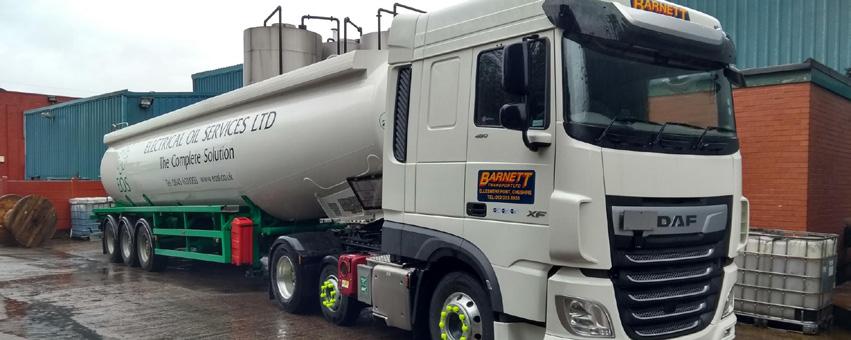
Another vital partnership was formed in August 2022 when Argent Energy announced an agreement with Eco Clarity. Argent is always on the lookout for efficiency improvements, and pairing with Eco Clarity was an obvious benefit as the company had developed a unique technology to filter wastewater into usable oil residues which make the base for biodiesel.

By separating fat, oils and grease (FOG) through an automated system that is housed across three containers, valuable second-generation biodiesel can be produced.
“A standard Eco Clarity hub can handle 10 tonnes of FOG containing waste water in 10 minutes, which can then go on to be separated and harvested within 30 minutes. The hub’s
efficient system currently uses just 25% of the energy typically used in similar processes, with temperatures never exceeding 60 degrees to ensure a low energy consumption,” says Eco Clarity.
“Through Eco Clarity and Argent Energy, valuable renewable resources have been created from materials that may otherwise have ended up discarded,” adds Argent Energy.
FAME
December 2022 saw Argent Energy begin groundworks for a new refined glycerine plant at the Port of Amsterdam. Already active in the Netherlands, this new facility will produce 50,000 tons per year and sees Argent expanding its horizons beyond biodiesel. A waste product from the refining of biodiesel, glycerine will be converted to a 99.7% pure,
technical grade product for use in the chemical industry across a range of applications from plastics to resins.

“This refining facility will help add real value to what is a standard processing residue with limited applications,” said Rietkerk. “It will also help reduce carbon emissions in industrial processes where refined glycerine is an important component. Together with our up-coming five-fold increase of Fatty Acid Methyl Ester (FAME) production capacity, the construction of this glycerine refinery shows our strong belief that wastebased biodiesel will remain a crucial part of decarbonisation in transport and other industries for decades to come.”
A recent trial of Argent Energy’s FAME, used by FincoEnergies and
Continues on page 129
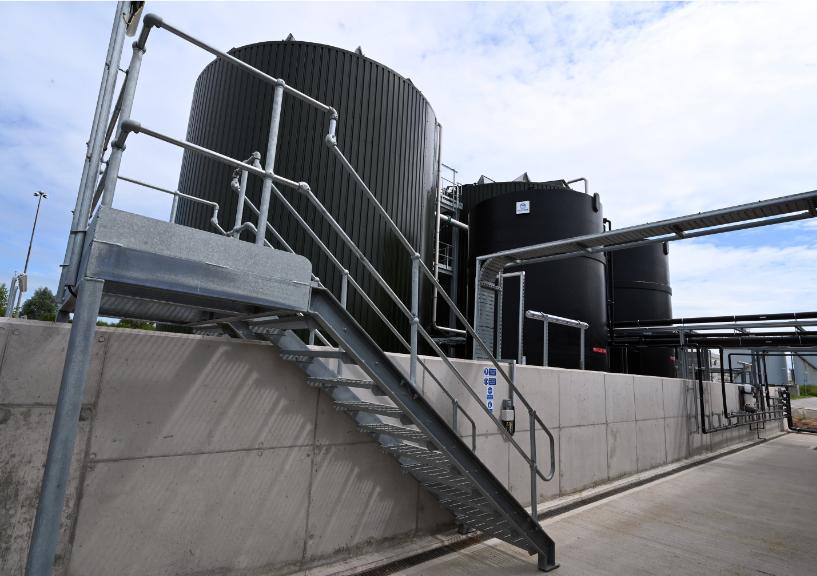
WEHRLE’sadvancedbiologicaltreatmentandfiltrationtechnologies areleadingthewaytoefficientwaterrecyclingandresourceutilisation
WEHRLEdesignsandbuildsturnkeywastewater treatmentplantsacrossmultiplemanufacturing sectors.Ourclientsachieveefficacyintheir wastewatertreatmentbyuseoflowenergy technologiesandbymaximisingrecyclingand reuseofthetreatedeffluent.WEHRLE’smodular designaidsinreducingtheinstallations footprintonthesite,aswellasfutureproofing forchangesinproductionandprovidinga sustainableapproachtoloweringthesites carbonfootprint.


WEHRLE’swastewatertreatmentplantsapply automationwherepossibleandallowremote access,makingthemoperatorfriendly.Theyare renownedfortheirreliabilityandthisis demonstratedbymorethan350installations globally.
Ourcomprehensiveportfolioofservices include:
► Conceptdesignandpilottrials
► Detaileddesignengineering
► Manufacturingandassembly
► Constructionandcommissioning
► Serviceoperationandmaintenance
► Remotetechnicalsupport
WEHRLEarea160-year-oldfamilyrunbusiness, locatedinSouthwestGermany.ItsUKdivisionis basedinBromsgrove,Worcestershireandhas beenoperatingforover20years.
Shouldyourequirefurtherinformationplease contact: info@wehrle.co.uk orvisitour website.

• 40+ years of delivering quality-driven projects across the UK
• Operating across a wide range of industrial markets
• Collaboration, sustainability and innovation at the core of our team
0161
www.morson-projects.co.uk

Continued from page 127
Dutch maritime logistics company VT Group, saw the material power the MTS Vlissingen, a liquid cargo tanker. As a drop-in replacement for diesel, FAME is well-suited to the maritime sector. The three companies will continue to work together to advance production and learnings.
“The results of the pilot are welcome of course, but actually no great surprise. It is widely known how cost-effective biofuels are in their contribution to decarbonisation, we just need governments to be more ambitious and not miss the huge opportunity to push more maritime GHG savings right now,” said Posnett. “Industry is ready to deliver more, with immediate effect, so work on the longer-term solutions can continue
apace in the knowledge we are doing all we can in the meantime to maximise carbon reductions for the planet.”
As a concept, the use of biodiesel and biofuels is proven - clear benefits exist. The science is obvious – biodiesel compared to traditional fossil fuels generates significantly reduced carbon emissions. Critically, biodiesel is now affordable and available. But most importantly, it is sustainable and renewable. Innovation and pioneering spirit is rife at Argent Energy and the company is keen to partner, encouraging all potential clients to get involved as soon as possible to understand how they can achieve return on investment and improved performance.
“The entrepreneurs who started Argent built the first biodiesel plant in Scotland, showing that it could
be possible to make biodiesel out of animal fat as a direct replacement for diesel,” says Posnett.
“There are a lot of rewards for getting it right,” he concludes. “You’re going to be first to the action, you’re going to have reputational benefits; to be the one that is not doing it is going to be painful.”
OCT 2
OCT
ADIPEC, taking place on 2-5 October 2023 in Abu Dhabi, is the world’s largest and most inclusive gathering for the energy industry. Over 2,200 companies from across the world, representing the entire energy ecosystem and beyond, will come together at the ADIPEC Exhibition to showcase the latest strategies and innovations that are defining the future of energy. The exhibition will feature 54 NOCs, IOCs, NECs and IECs and 30 international exhibiting country pavilions, uniting under a common goal while presenting diverse perspectives and ideas, and forging the game-changing partnerships that will enable the world to decarbonise faster, together. Alongside ADIPEC’s 16 exhibition halls, it will host four specialised industry areas – the Decarbonisation Zone, Maritime & Logistics Zone, Digitalisation in Energy Zone, and Manufacturing & Industrialisation Exhibition & Conference. These dedicated zones will enable the industry to strengthen existing business partnerships and form new models of cross-sector collaboration to unlock and maximise value across businesses and drive future growth.
OCT 25
OCT
“Commercialise. Revolutionise. Electrify. Unlock the True Potential of Offshore Wind” Europe is focusing on renewable energy to stabilize energy security and achieve independence. Offshore wind technologies have the potential to unlock this industry’s immense opportunities. European governments have set a target of 450GW of offshore wind, requiring significant efforts to develop new opportunities, adopt technologies, and build a supply chain. Offshore & Floating Wind Europe will gather stakeholders to address challenges and strategize solutions for floating and fixed-bottom wind.
NOV 7

Europort, organized in the world port city of Rotterdam, is the international maritime exhibition and meeting place for innovative technology and complex shipbuilding. With an average of 25,000 professional visitors and 1,000 exhibiting companies Europort belongs to the world’s largest maritime meeting & knowledge sharing B2B platforms. Our seas, rivers and channels are deeply rooted in The Netherlands’ DNA. The Dutch are globally renowned for challenging these waters and for their maritime expertise on extraordinary projects. While the exhibition will span every aspect of the maritime world, it is therefore only natural that Europort has a strong focus on high-tech ships. These nine categories of special-purpose vessels will be particularly prominent at Europort.
OCT 2
OCT 10
OCT 10
OCT 25
NOV 7
NOV 7
NOV 13
ADIPEC ABU DHABI, UAE | OCT 2-5
ENERGY MANAGEMENT SUMMIT 2023
LONDON, UK | OCT 10-11
HYDRO EDINBURGH EDINBURGH, UK | OCT 16-18
ANNUAL OFFSHORE & FLOATING WIND EUROPE 2023 LONDON, UK | OCT 25-26

SMART CITY EXPO 2023 BARCELONA, SPAIN | NOV 7-9
EUROPORT 2023 ROTTERDAM, NETHERLANDS NOV 7-10
WORLD LP GAS FORUM 2023 ROME, ITALY | NOV 13-17

2-5 October 2023
Abu Dhabi, UAE
ADIPEC, the world’s largest energy exhibition and conference, brings together the ideas, ambition, technology and capital needed to accelerate the urgent, collective and responsible action that can decarbonise and future-proof our energy system.

160,000 Energy professionals
2,200 Exhibiting companies
54 NOCs, IOCs, NECs and IECs
15,000 Conference delegates
1,600 Conference speakers
350 Conference sessions
10
30 Country pavilions Conferences
Under the Patronage of H.H. Sheikh Mohamed Bin Zayed Al Nahyan, President of the United Arab EmiratesEnsuring the sustainability, security, and equity of energy access means we must think big. We need global solutions that can be scaled and adopted quickly. SLB’s know-how and technology are helping to overcome industry’s greatest challenges while transforming energy. Together we create amazing technology that unlocks access to energy for the bene t of all.
With a renewed commitment to environmental stewardship and social responsibility, SLB's technology-driven approach will help reduce carbon emissions and promote sustainable practices. By deploying our advanced technologies, SLB is commited to support Qatar's vision of becoming a sustainable nation and reducing its carbon footprint.
